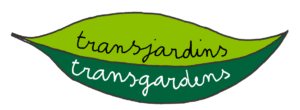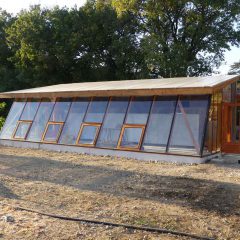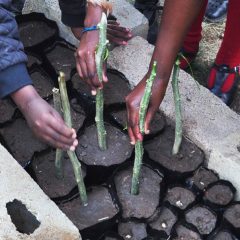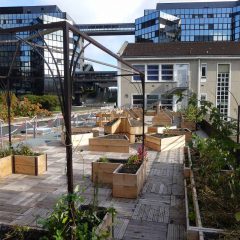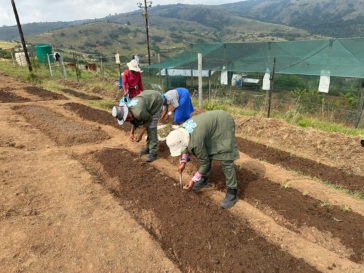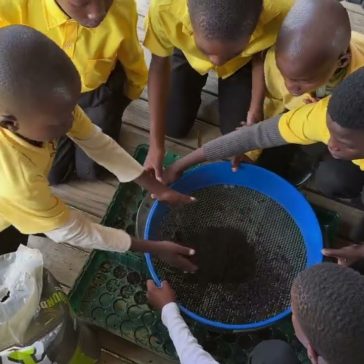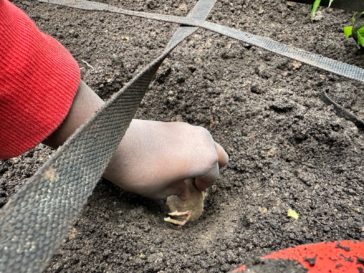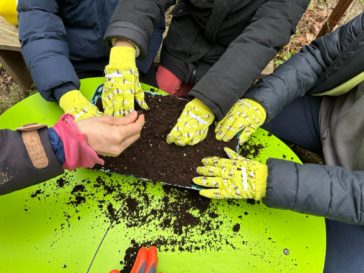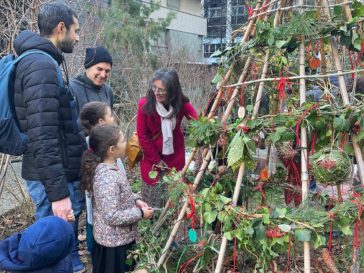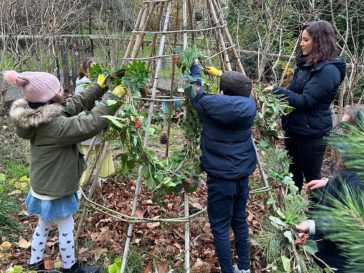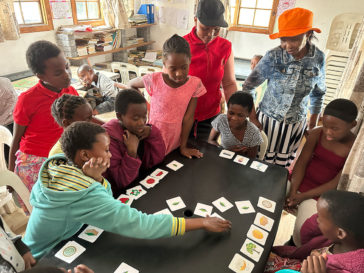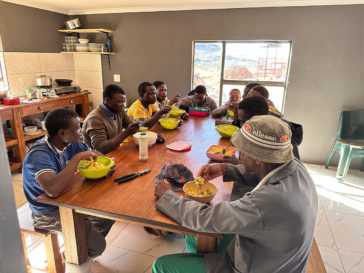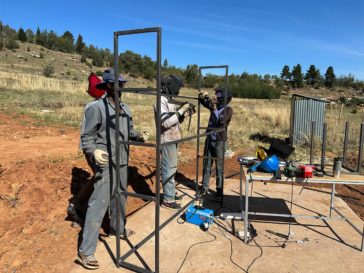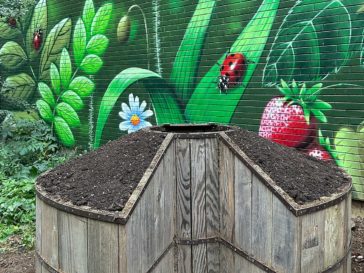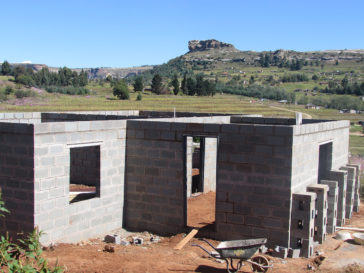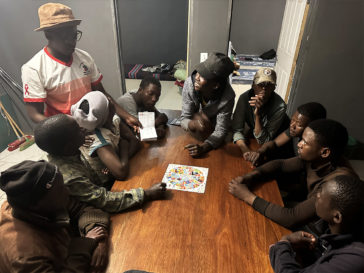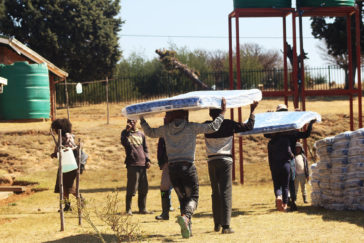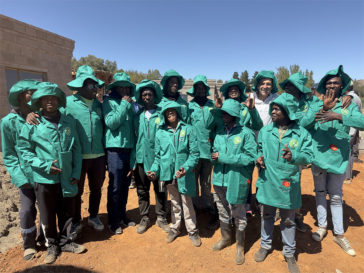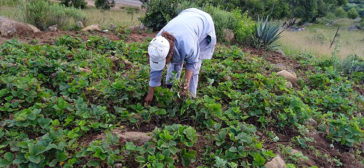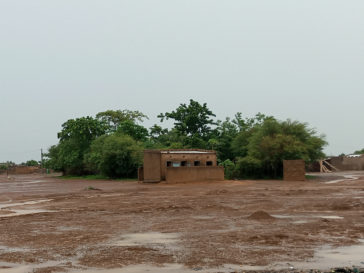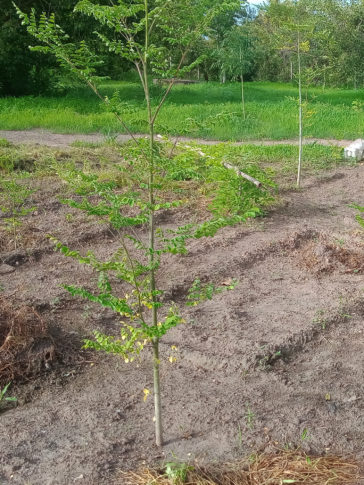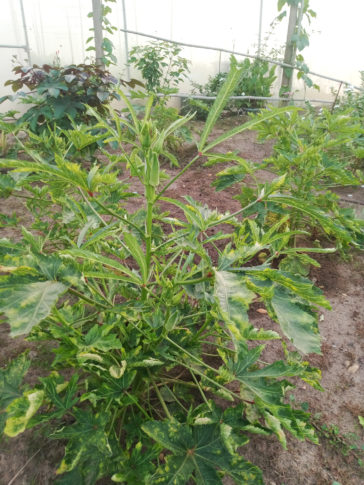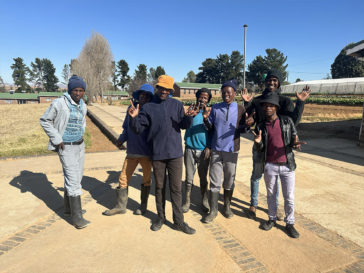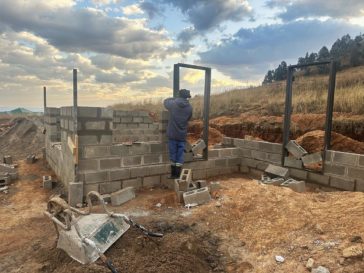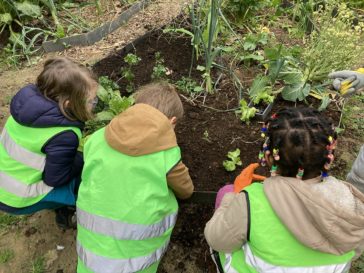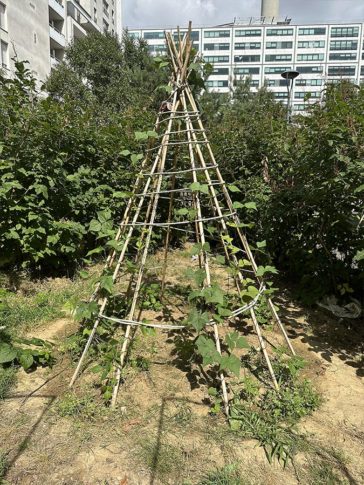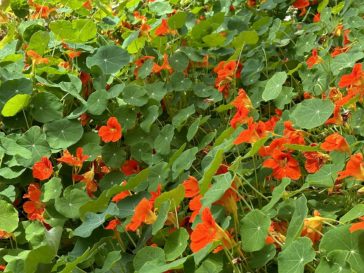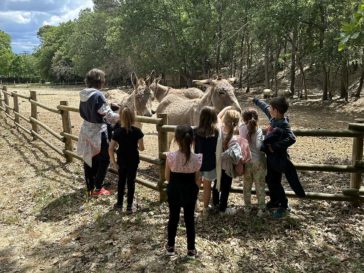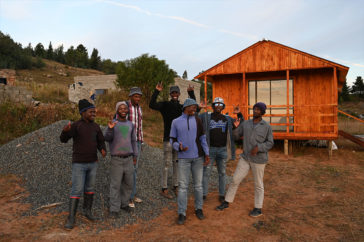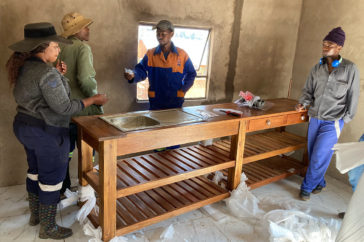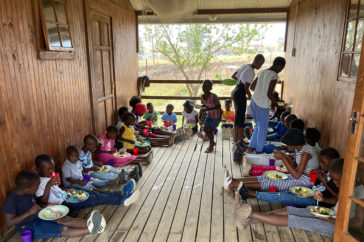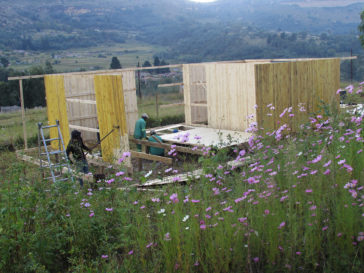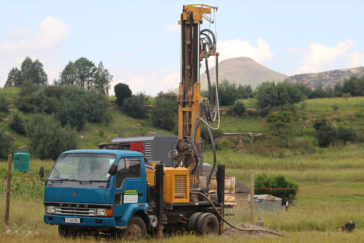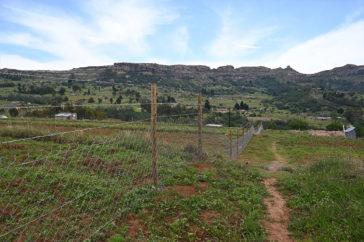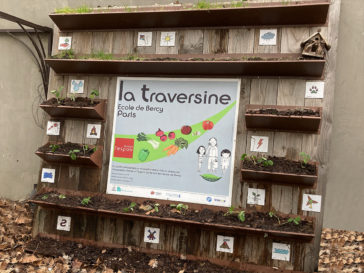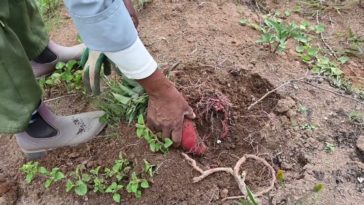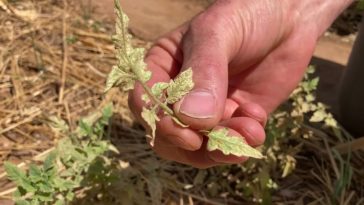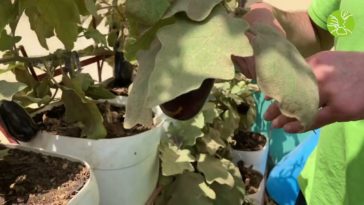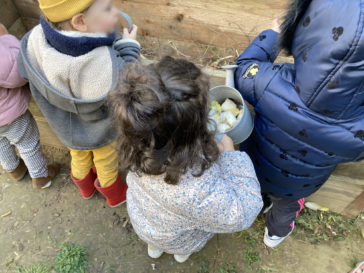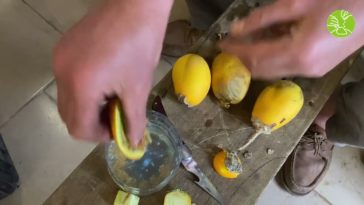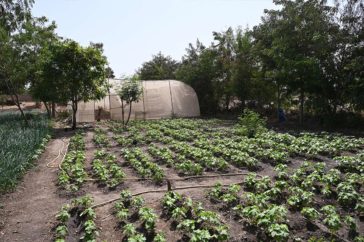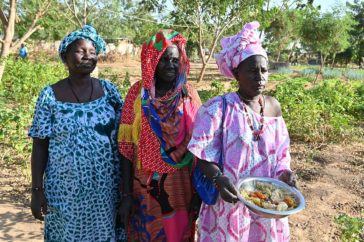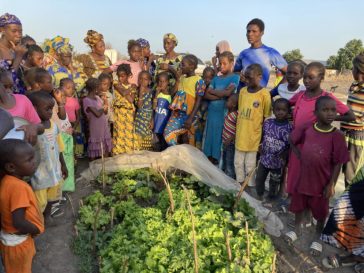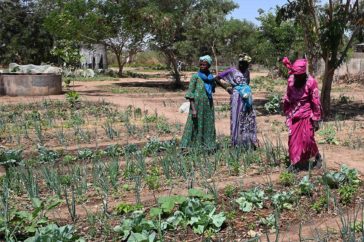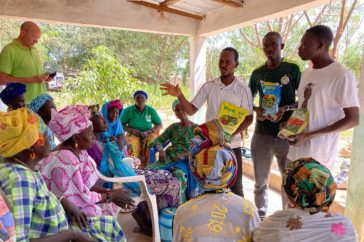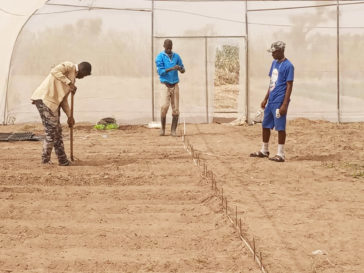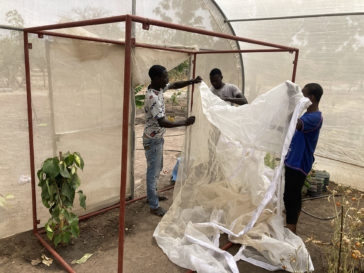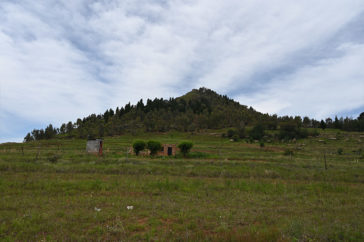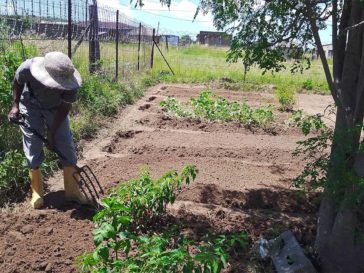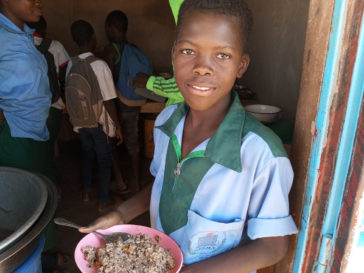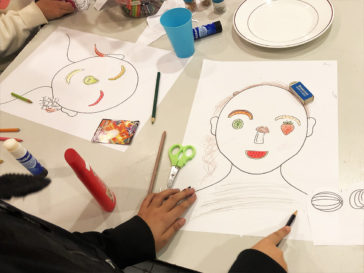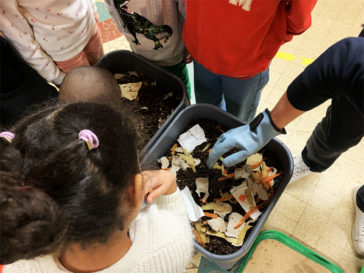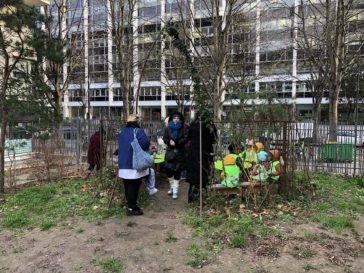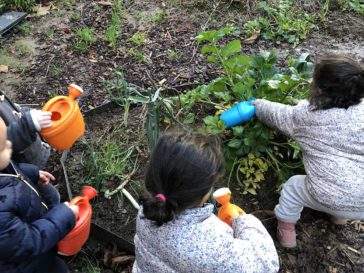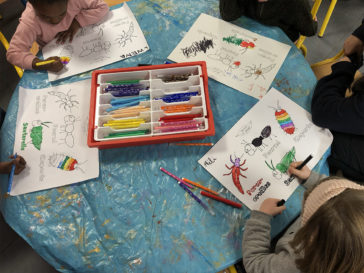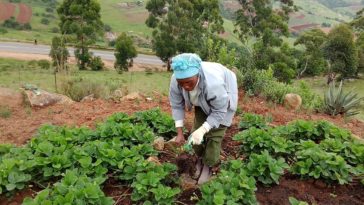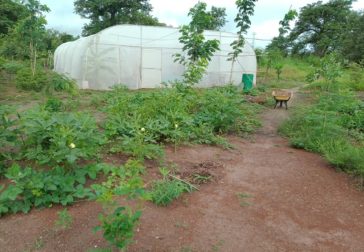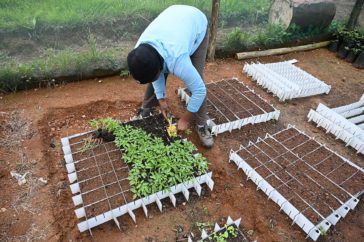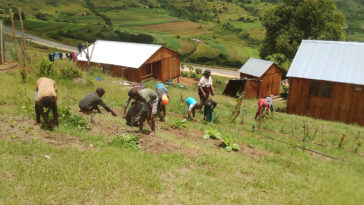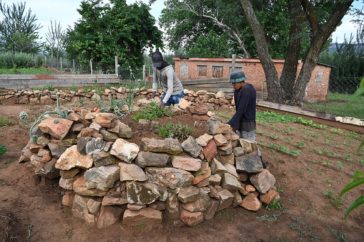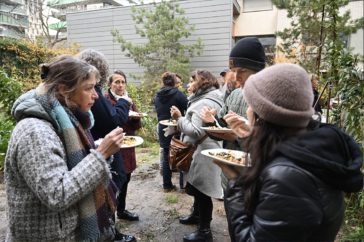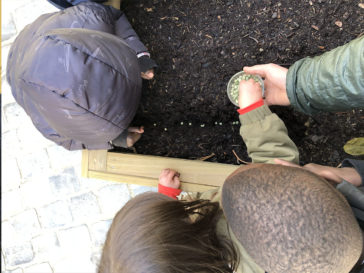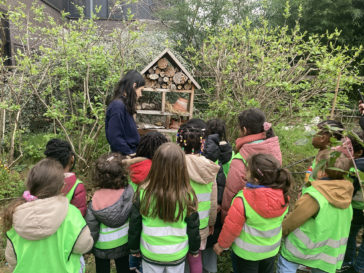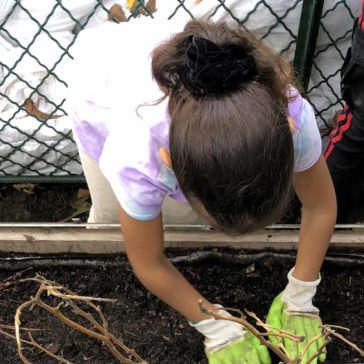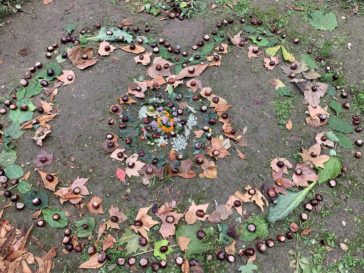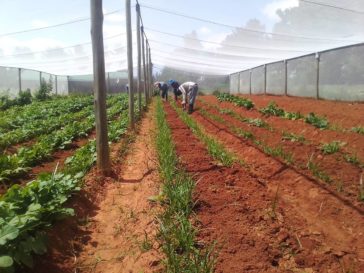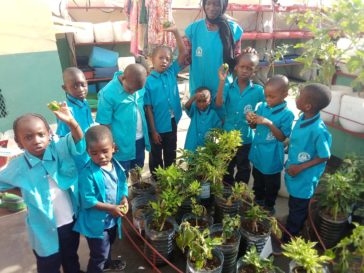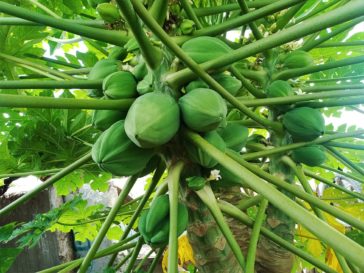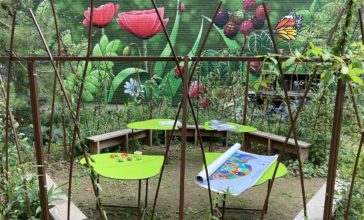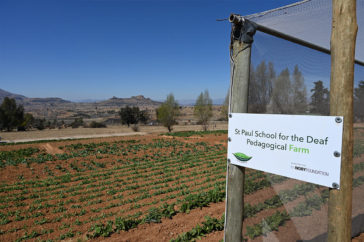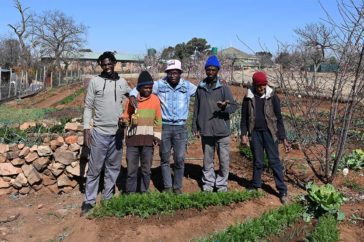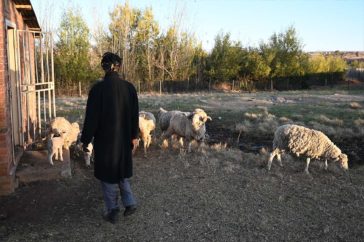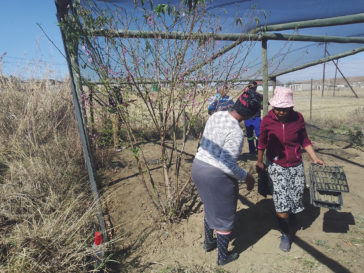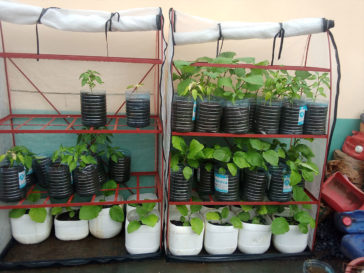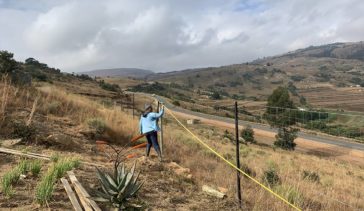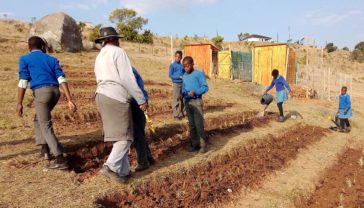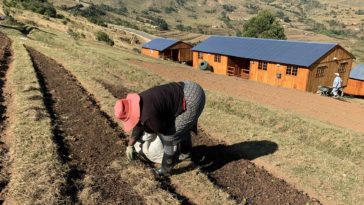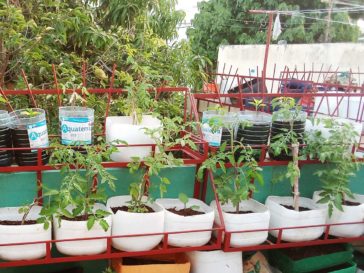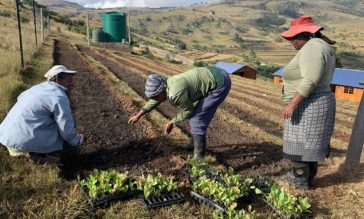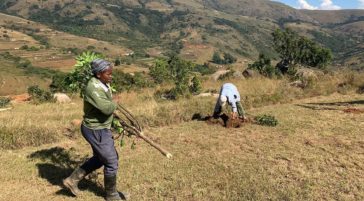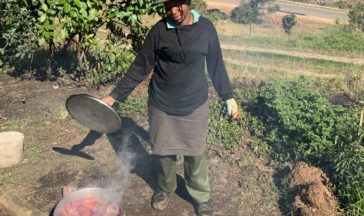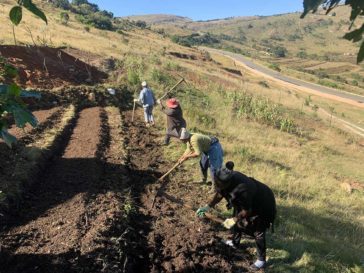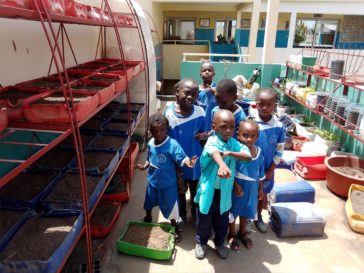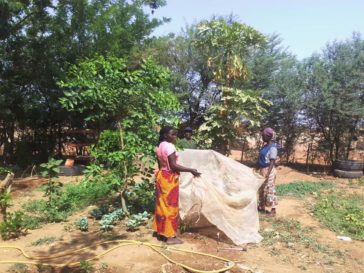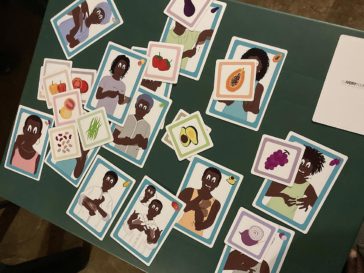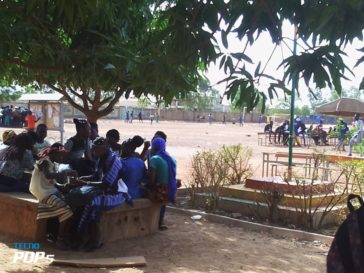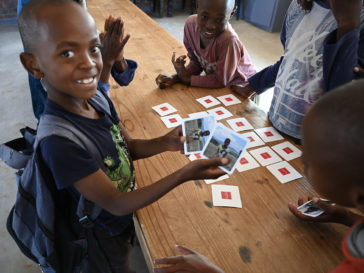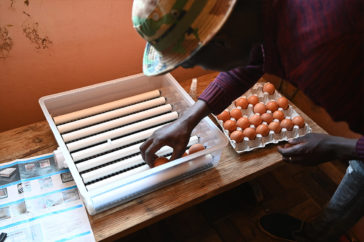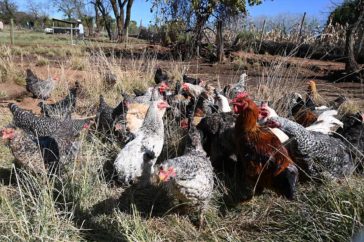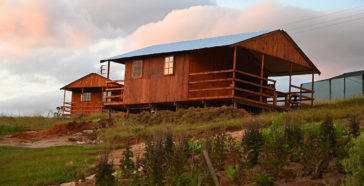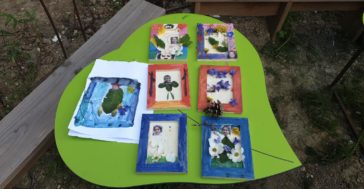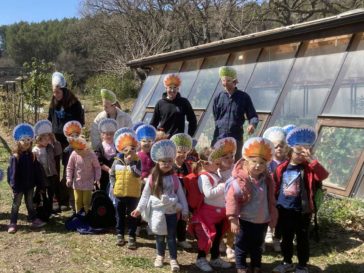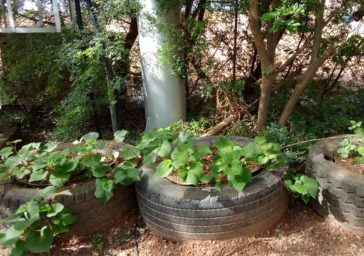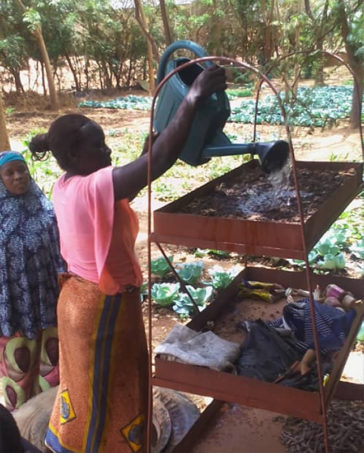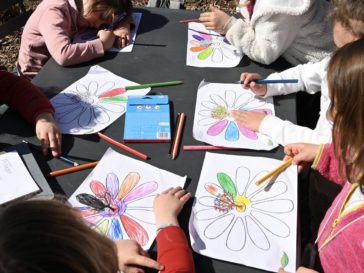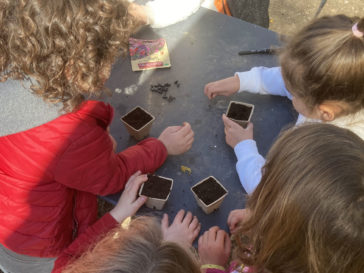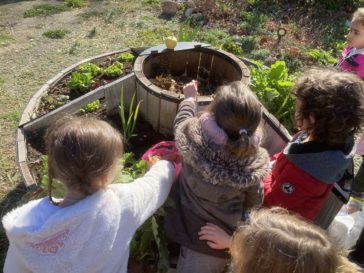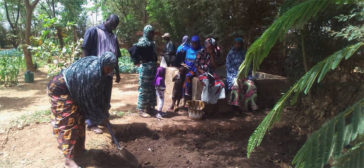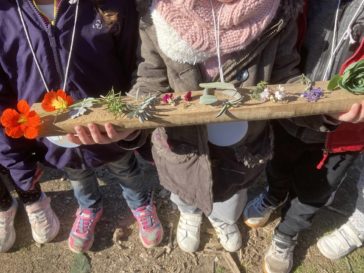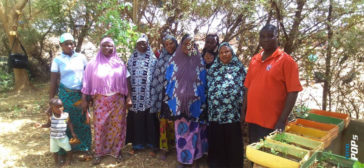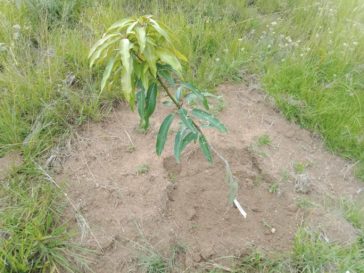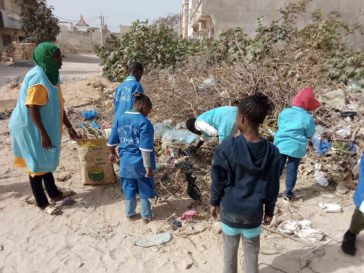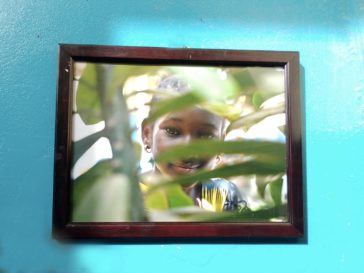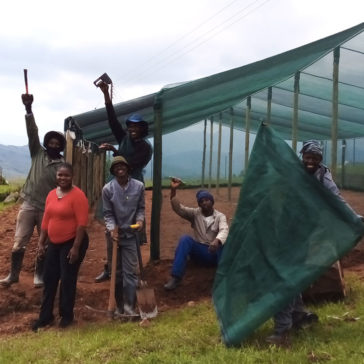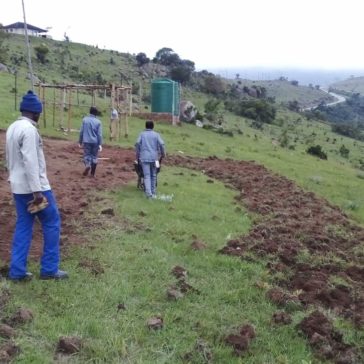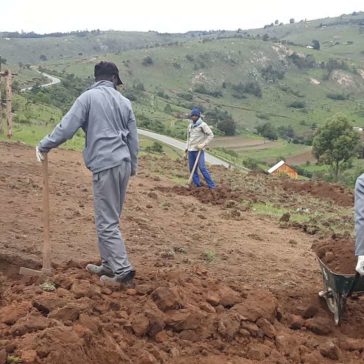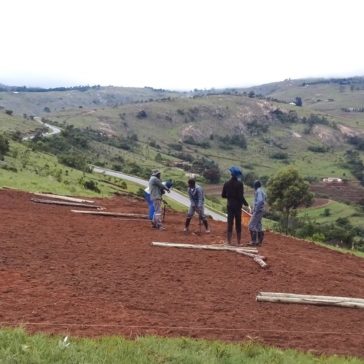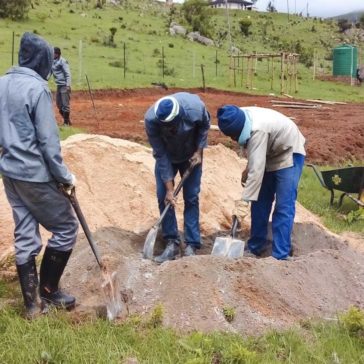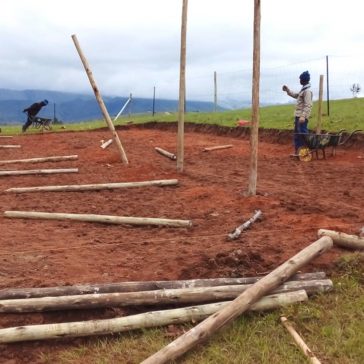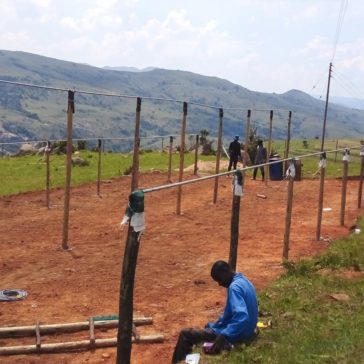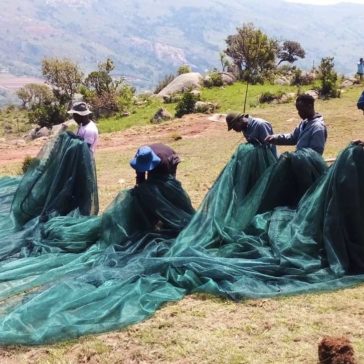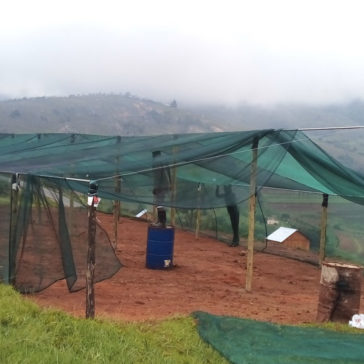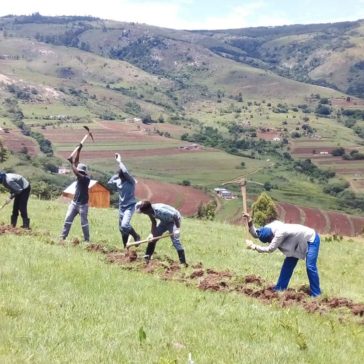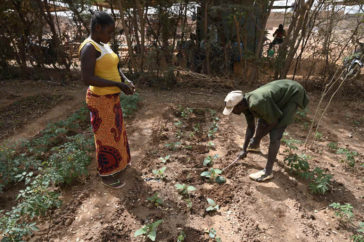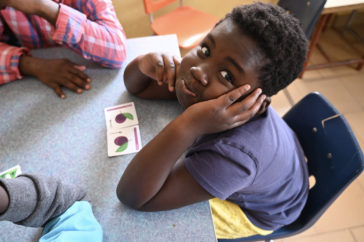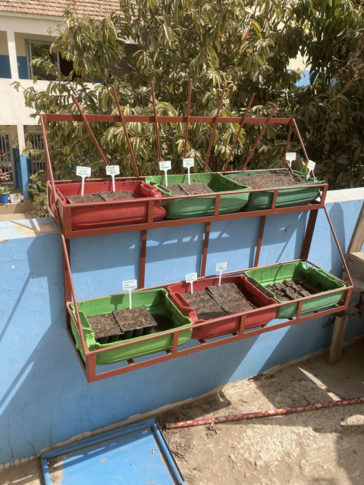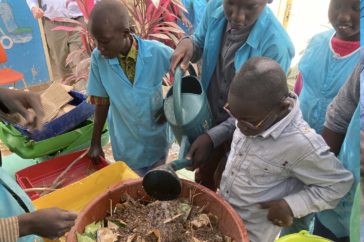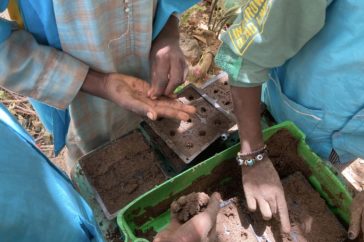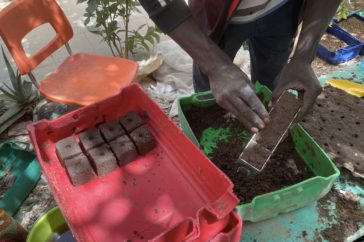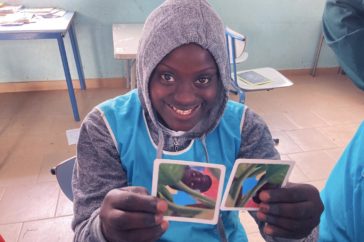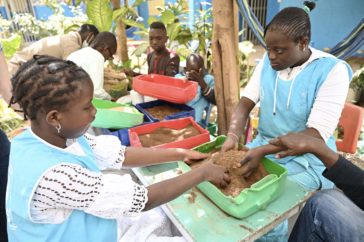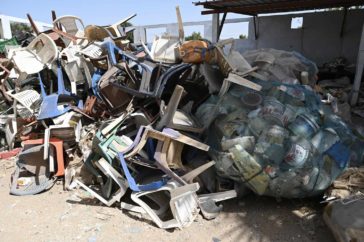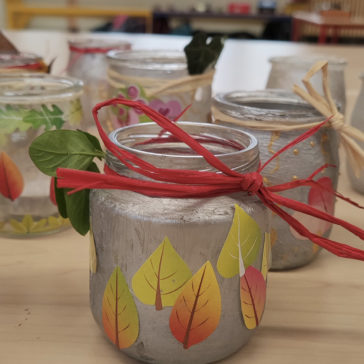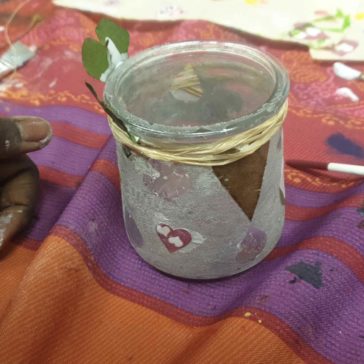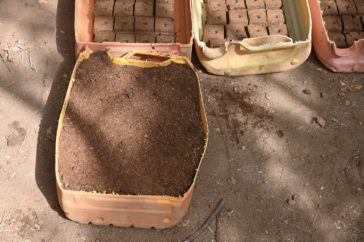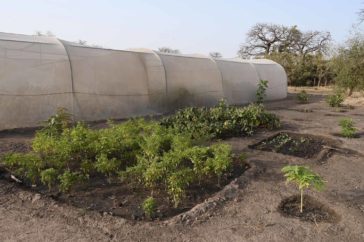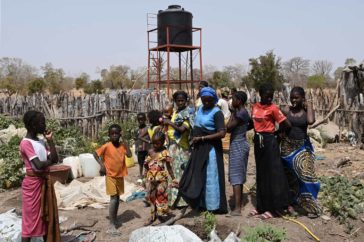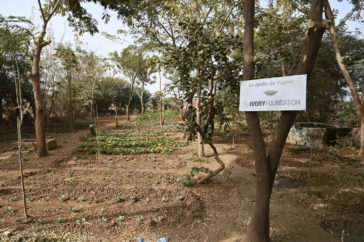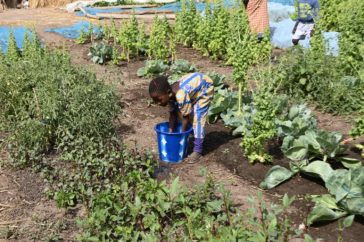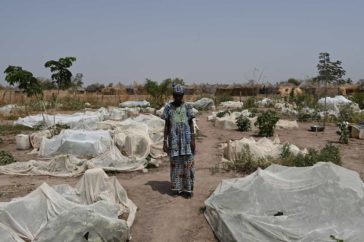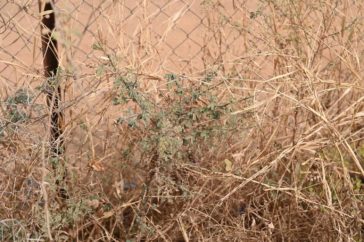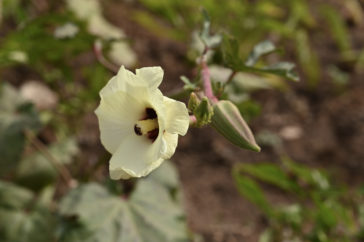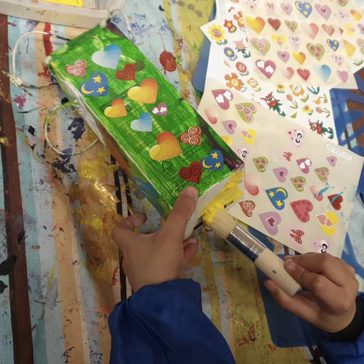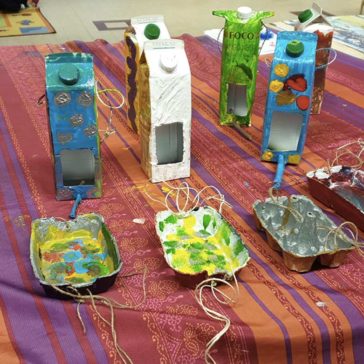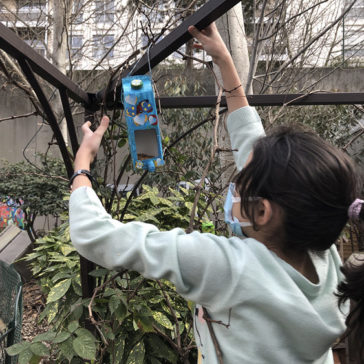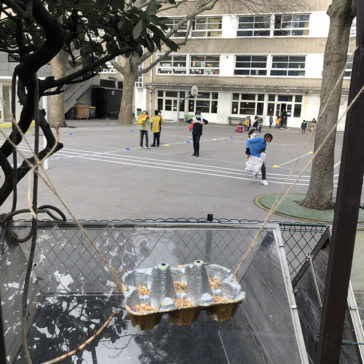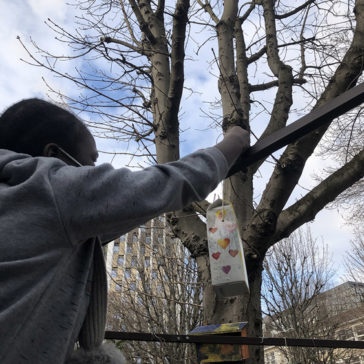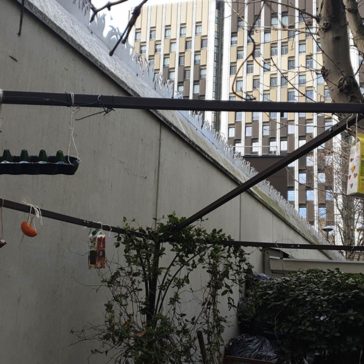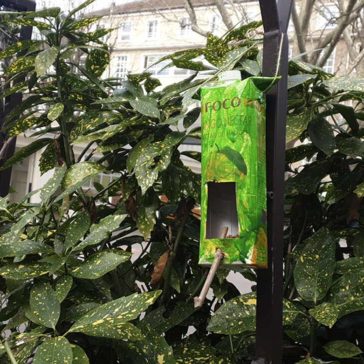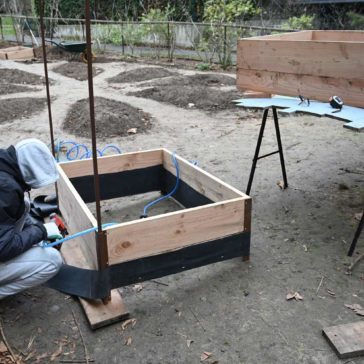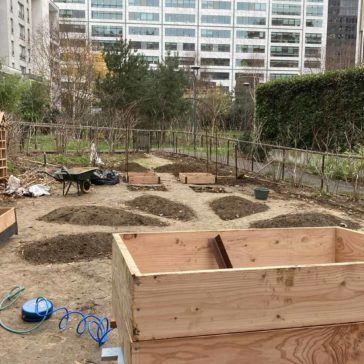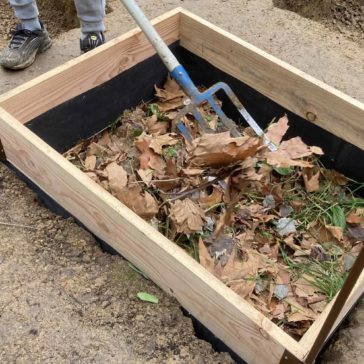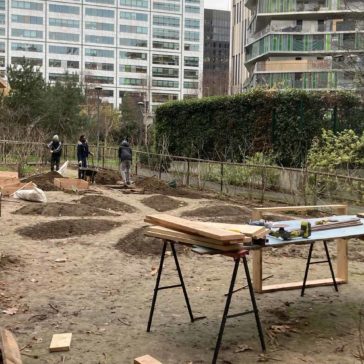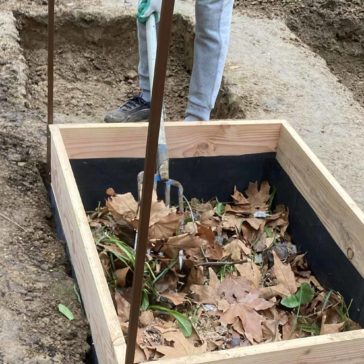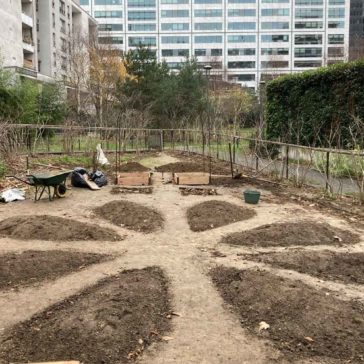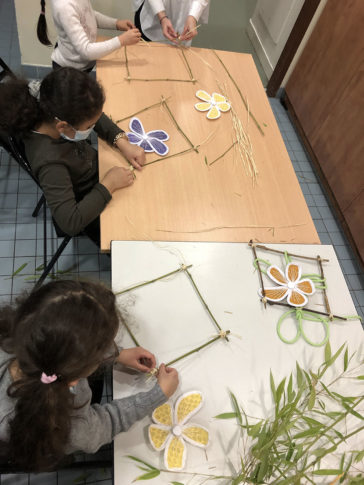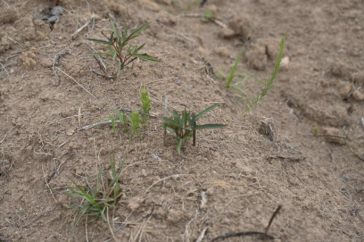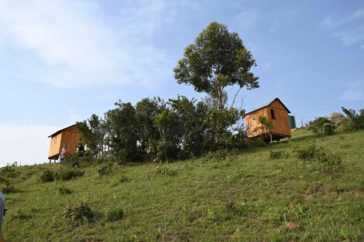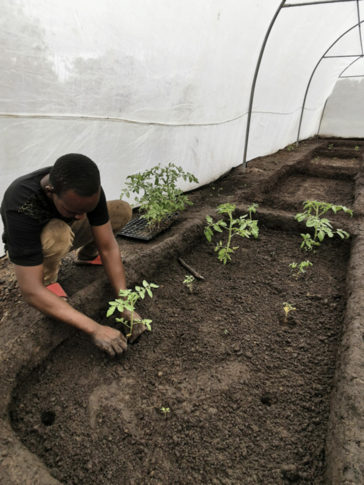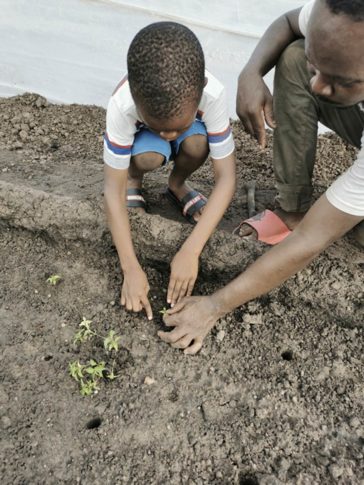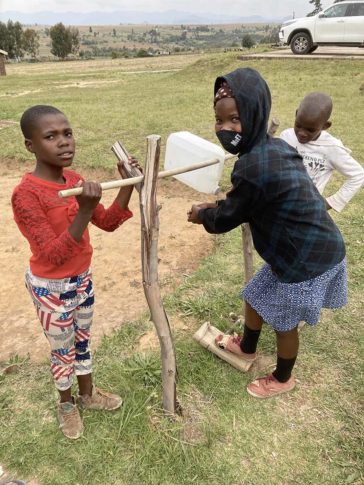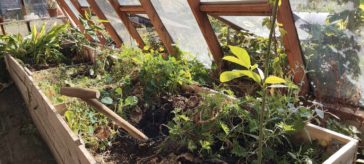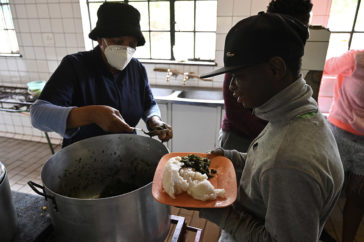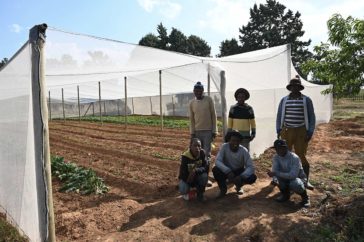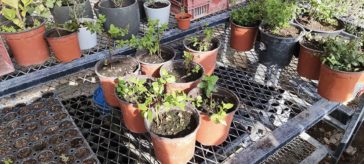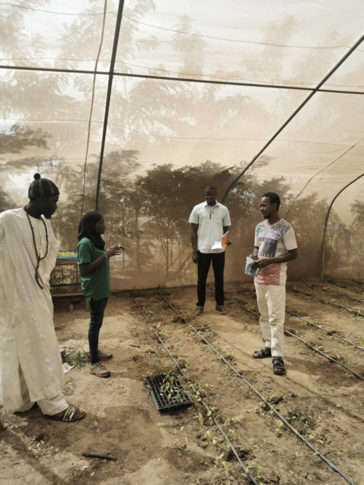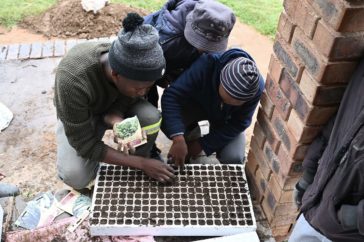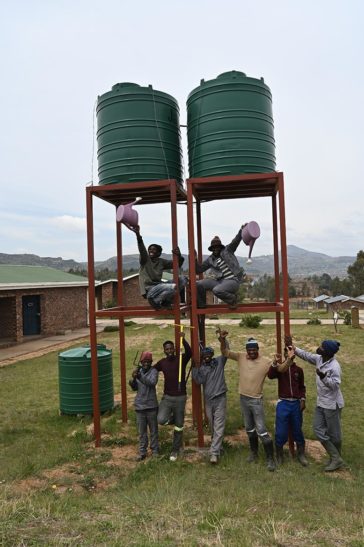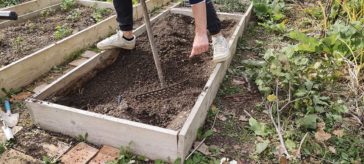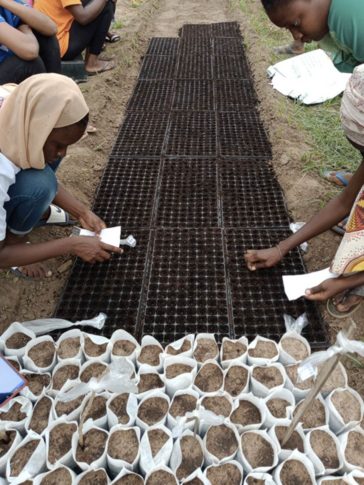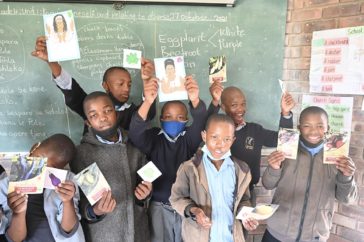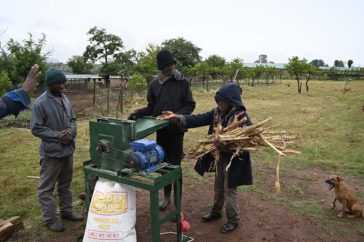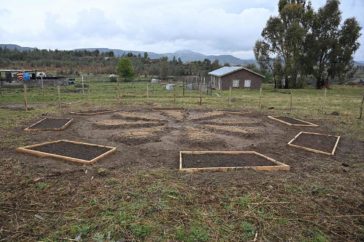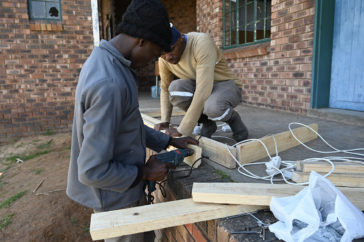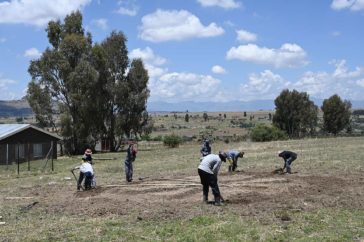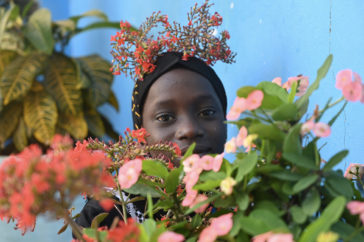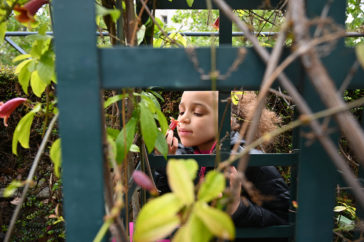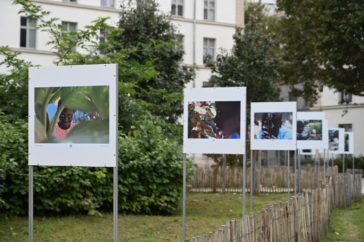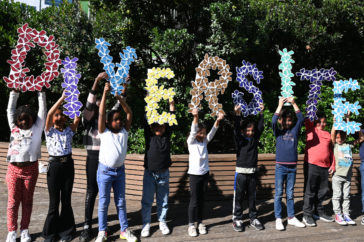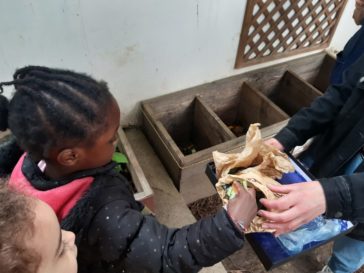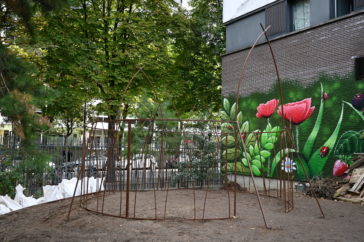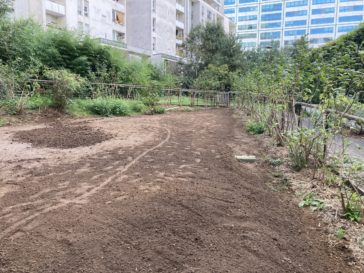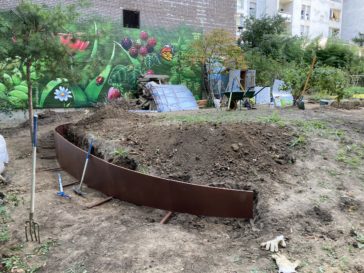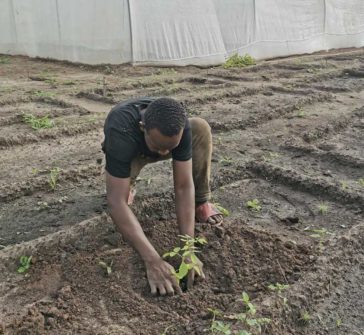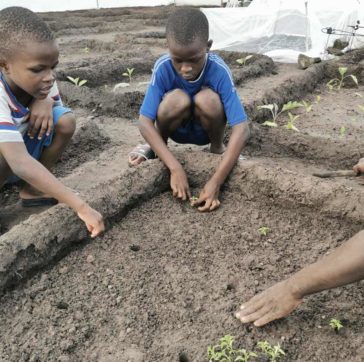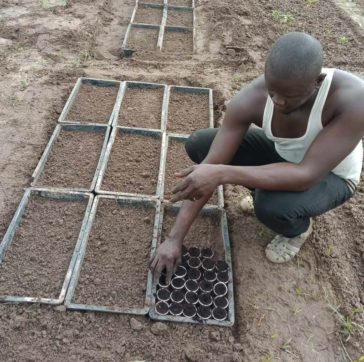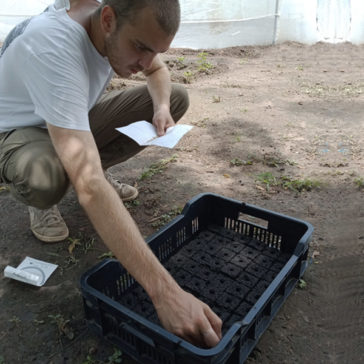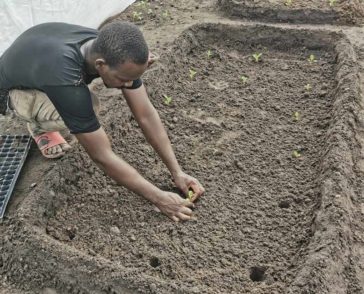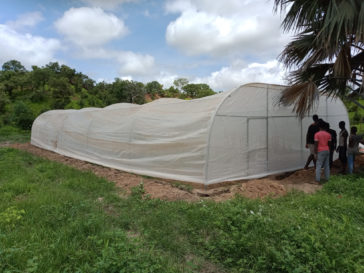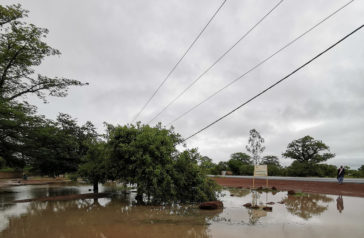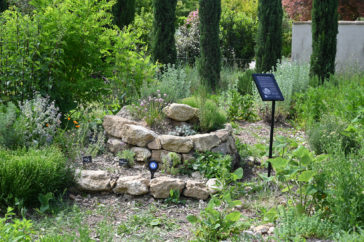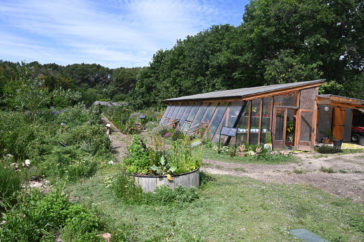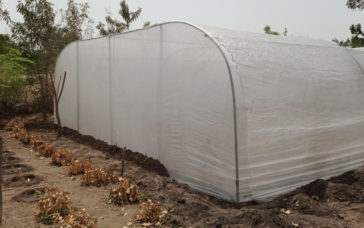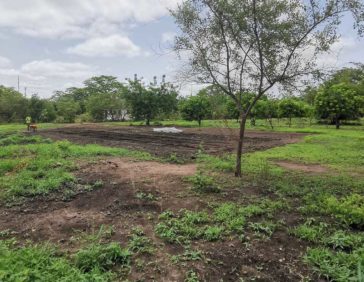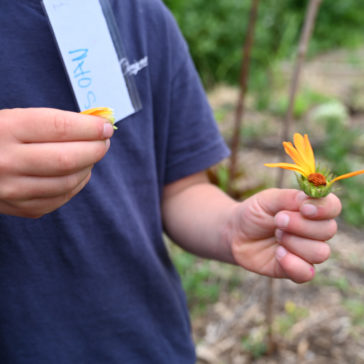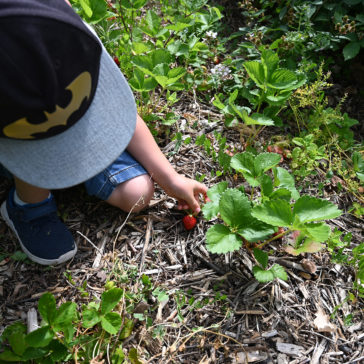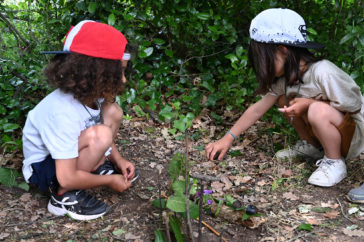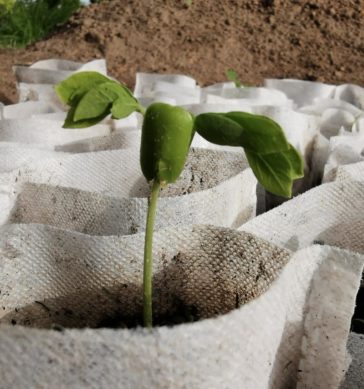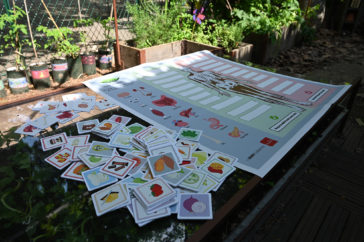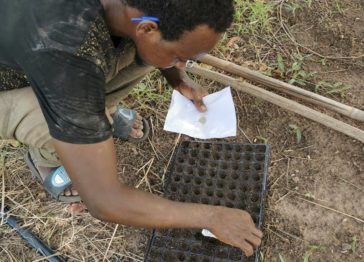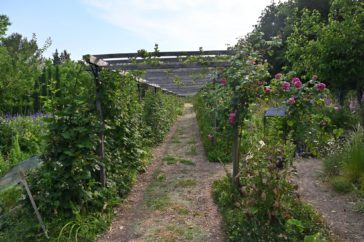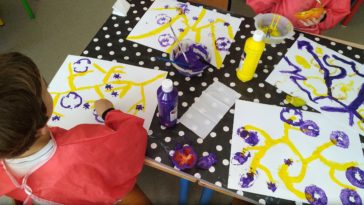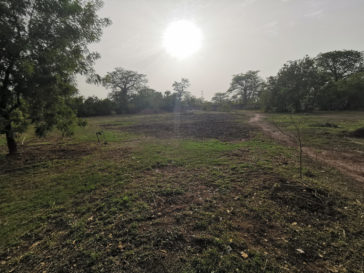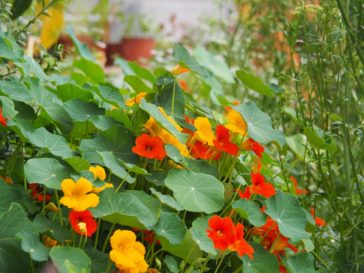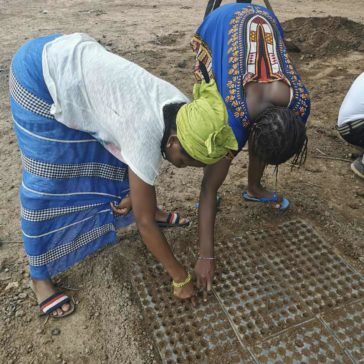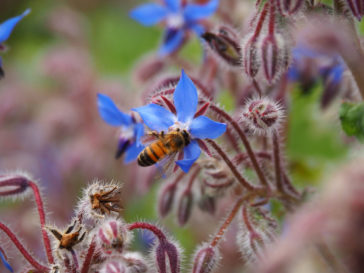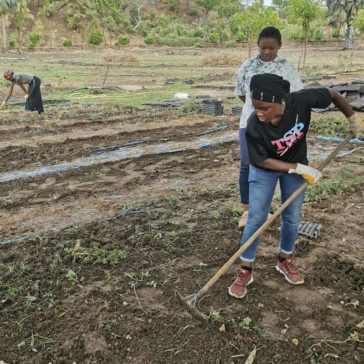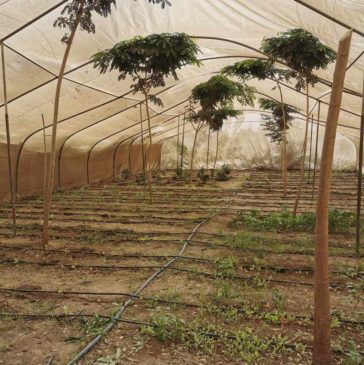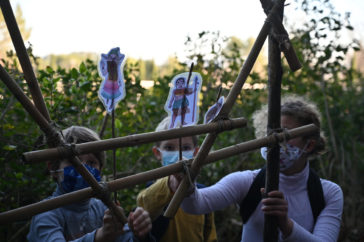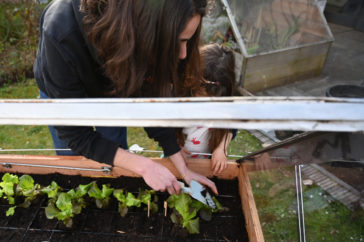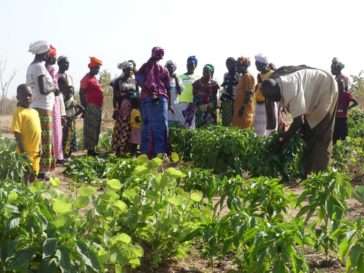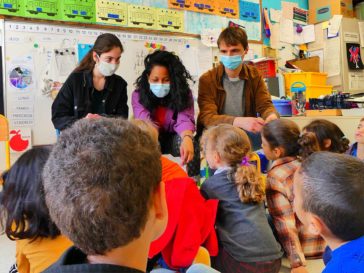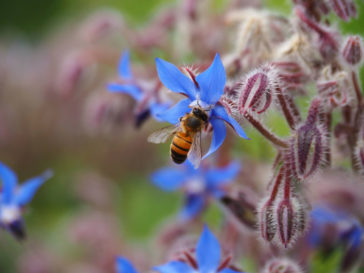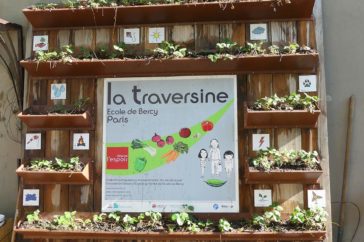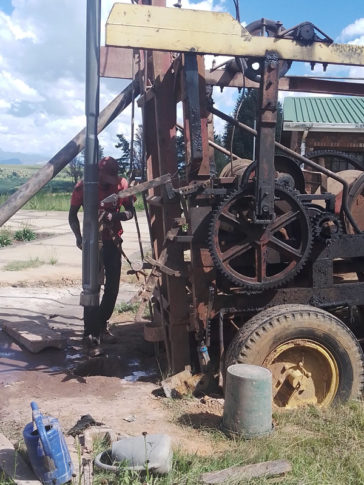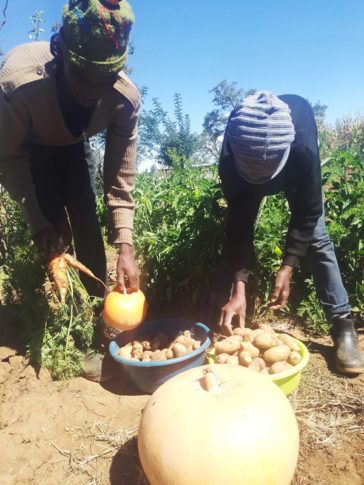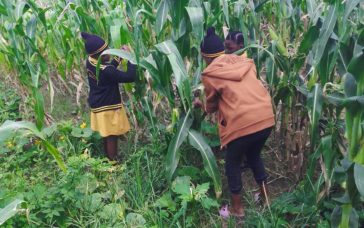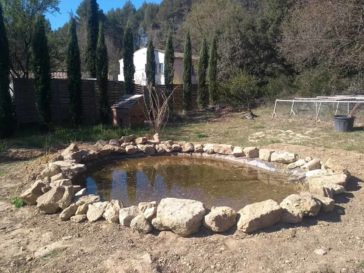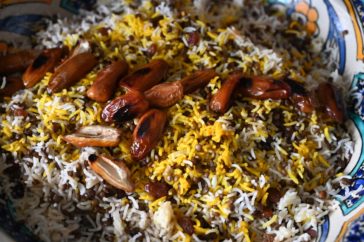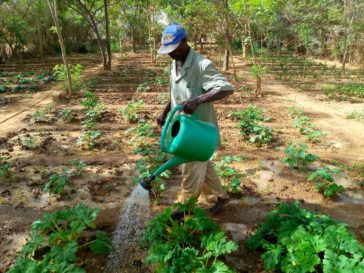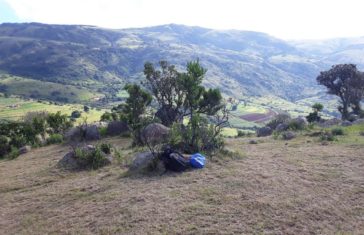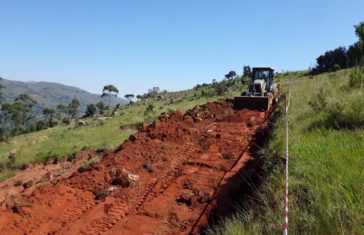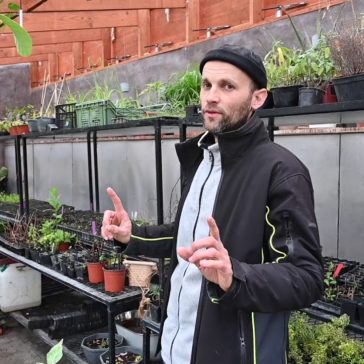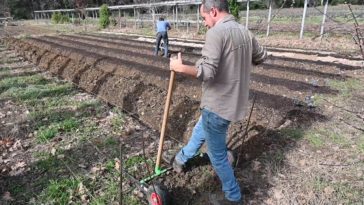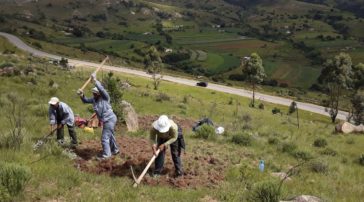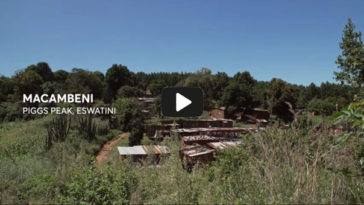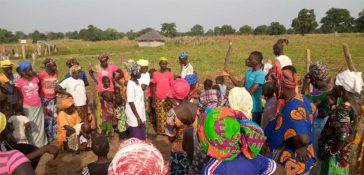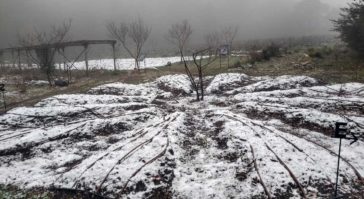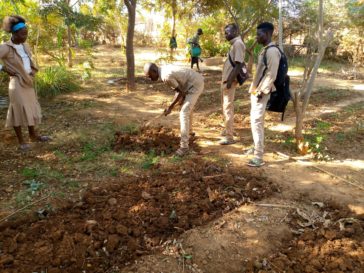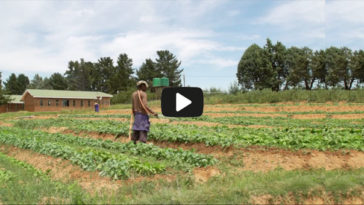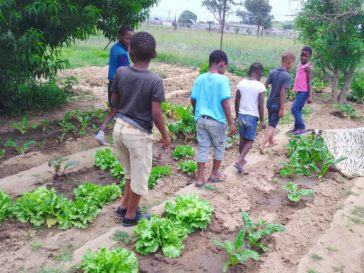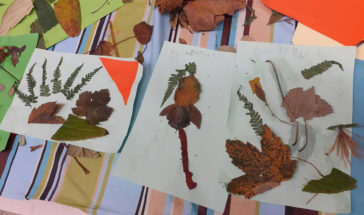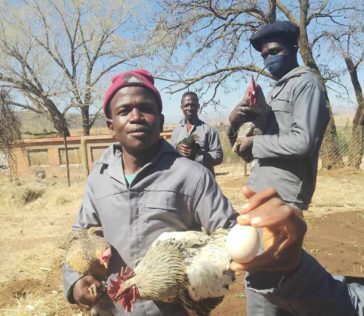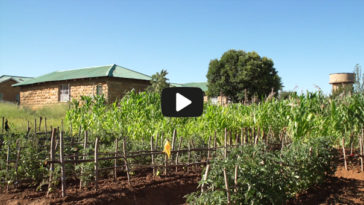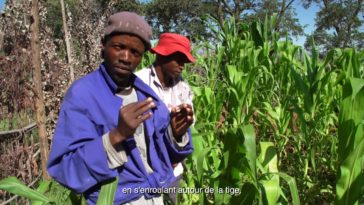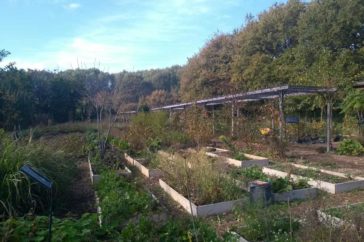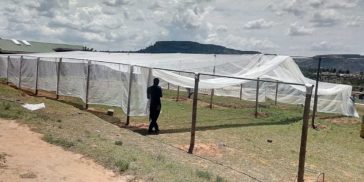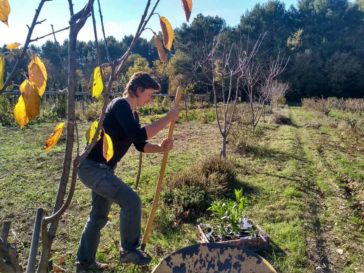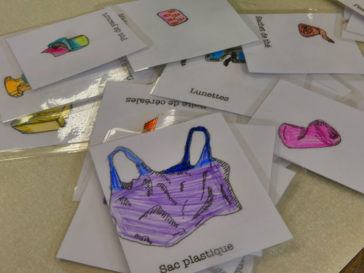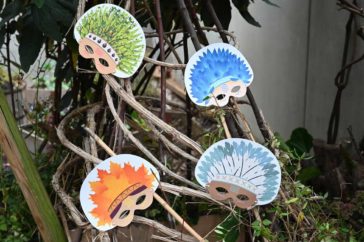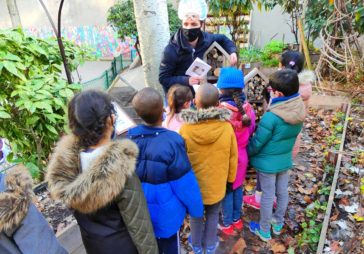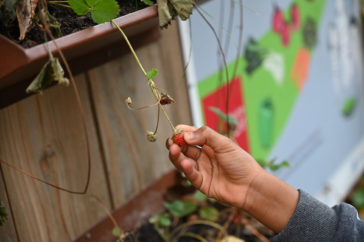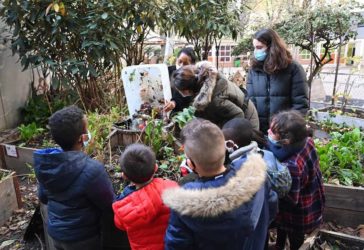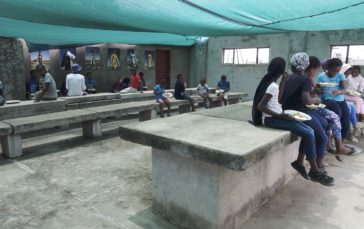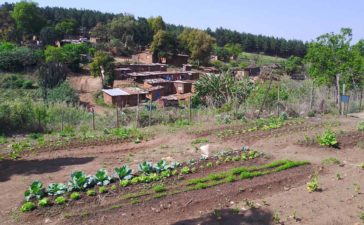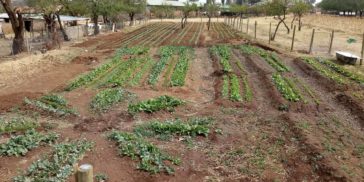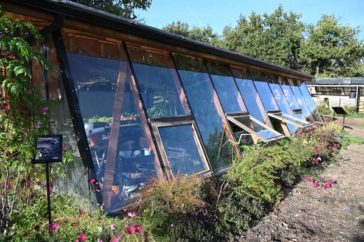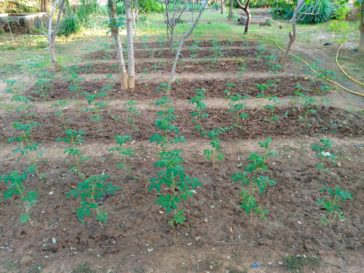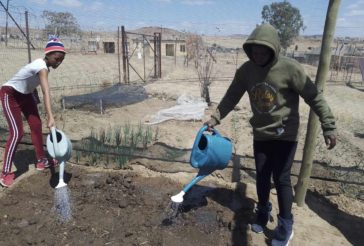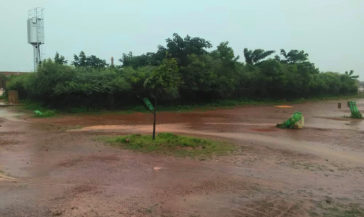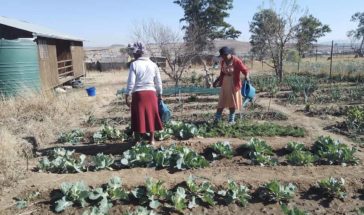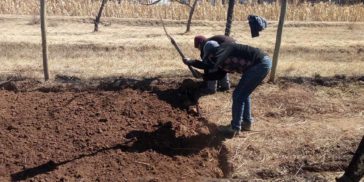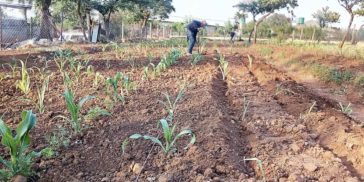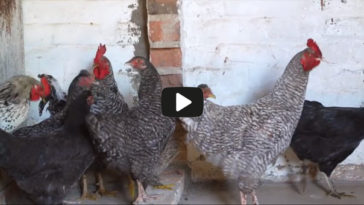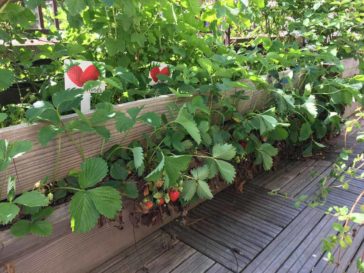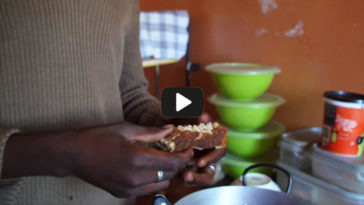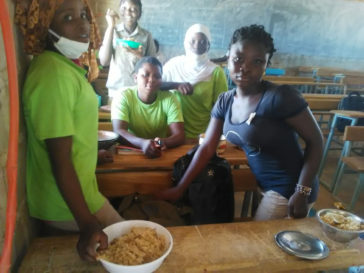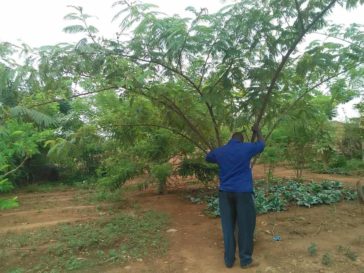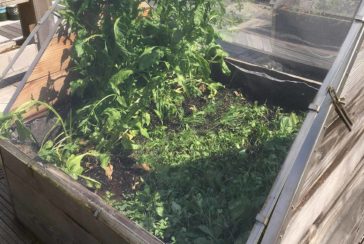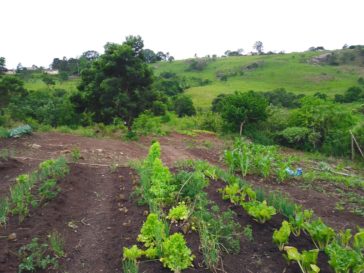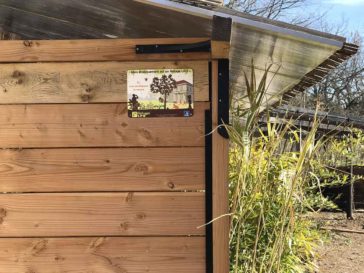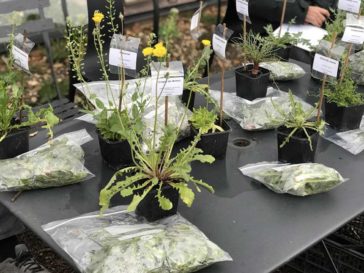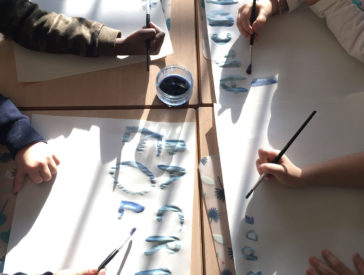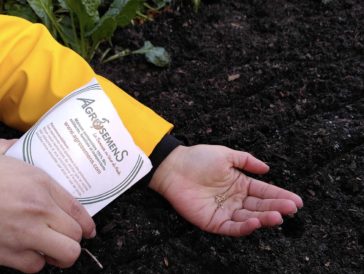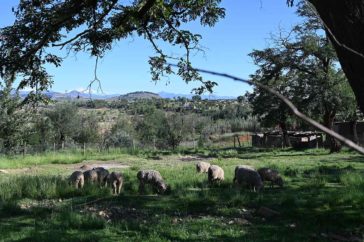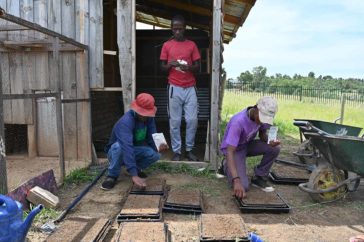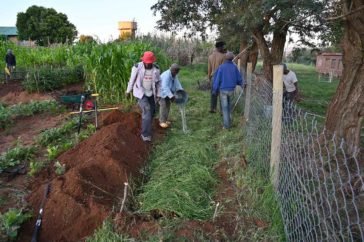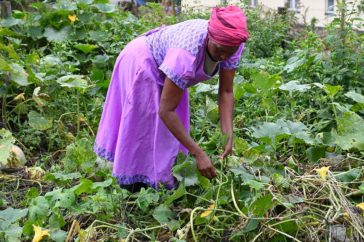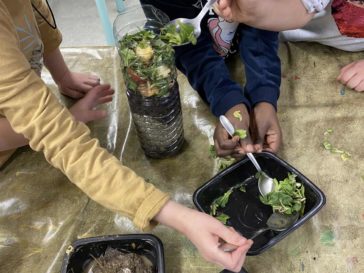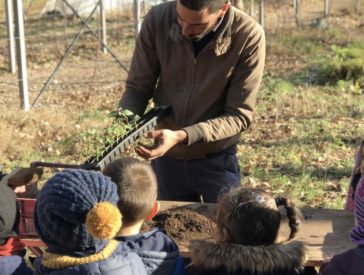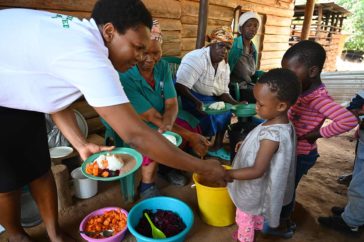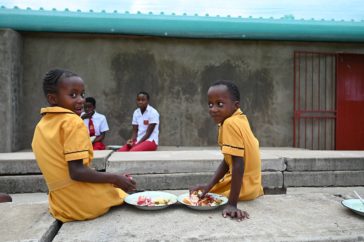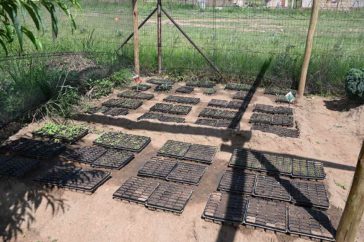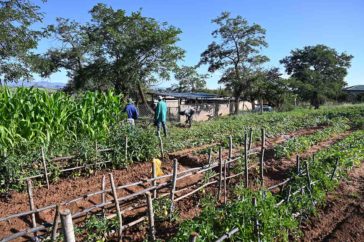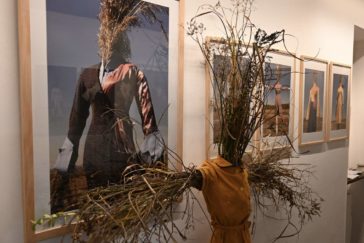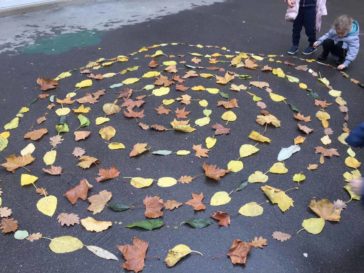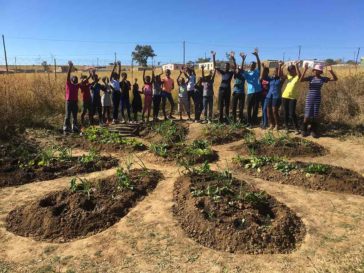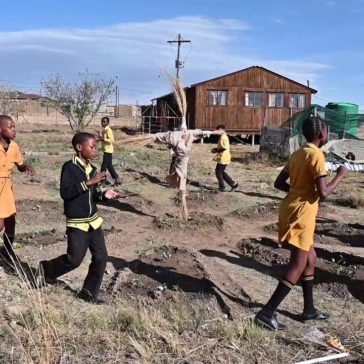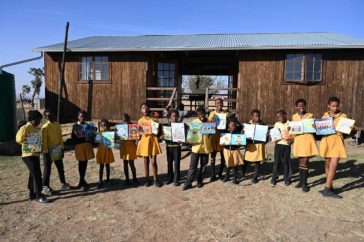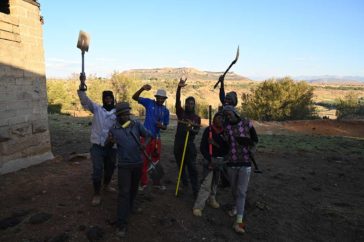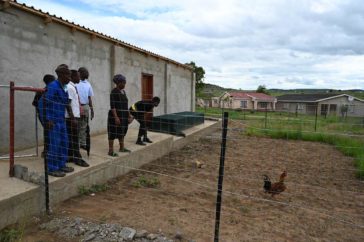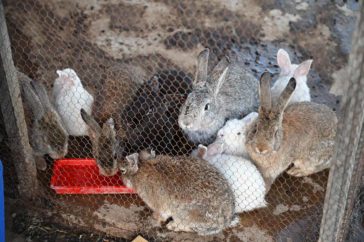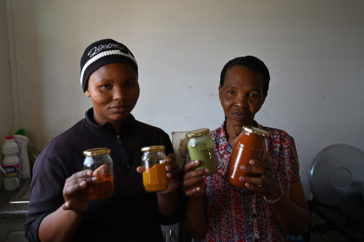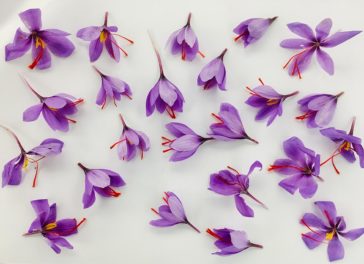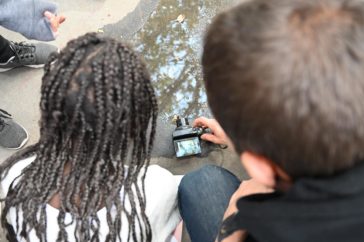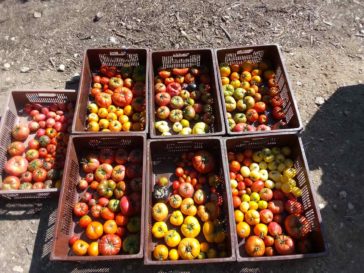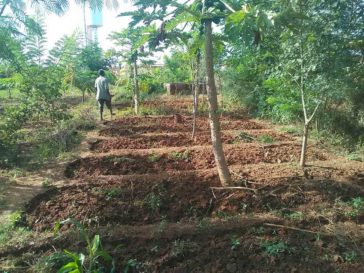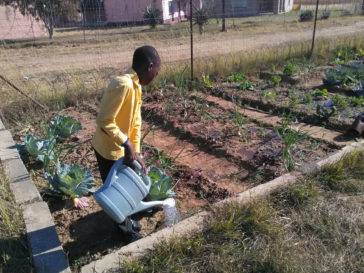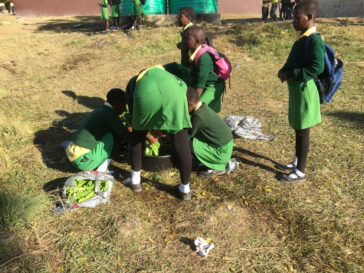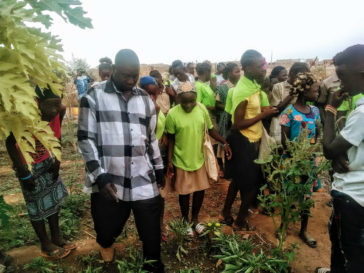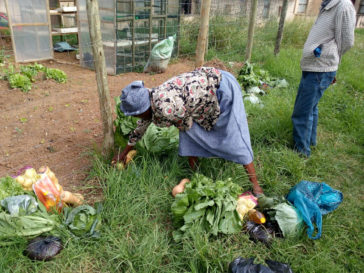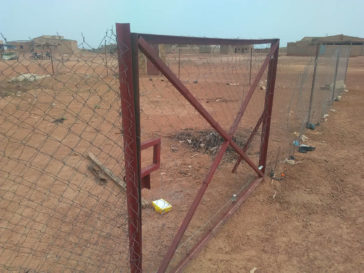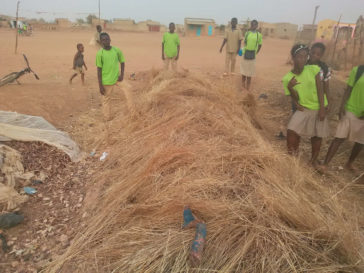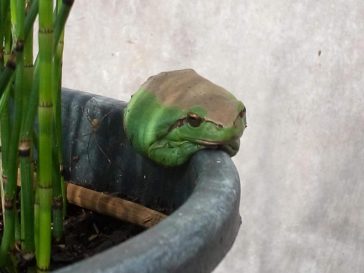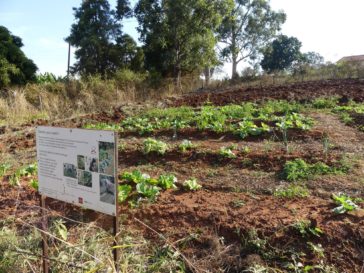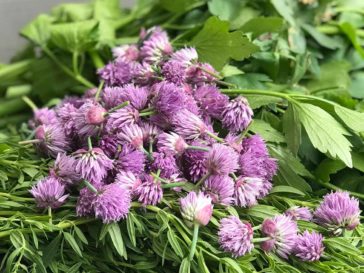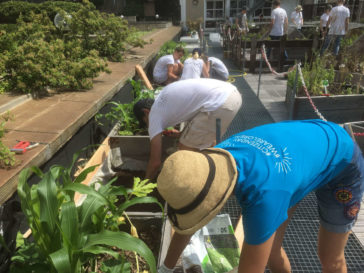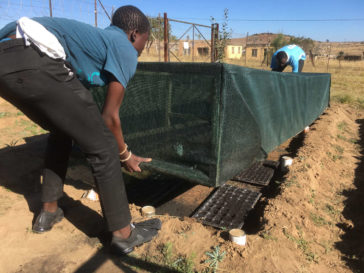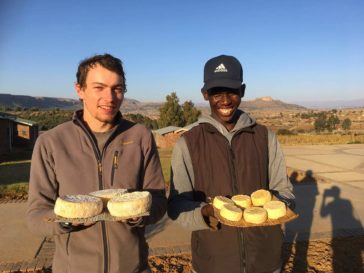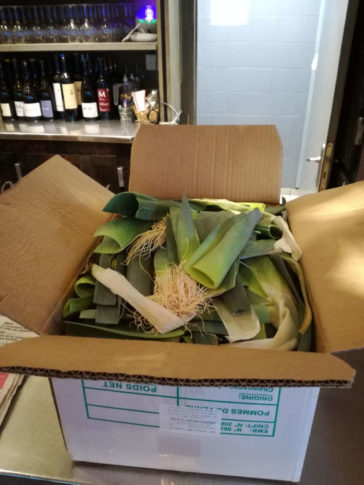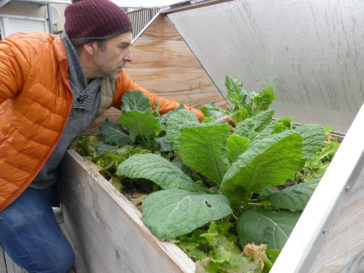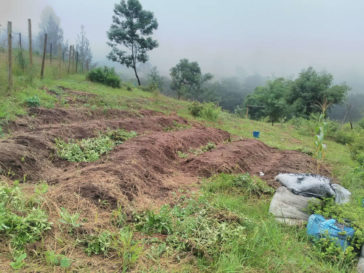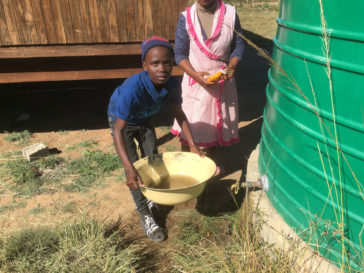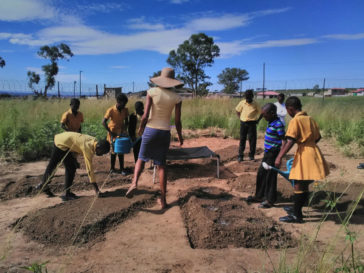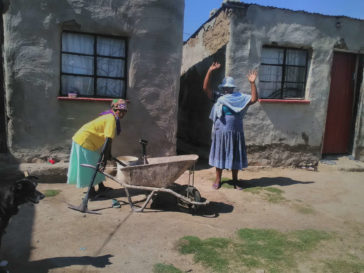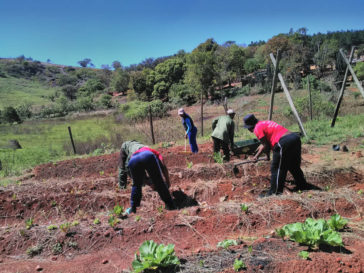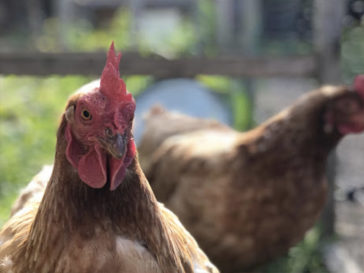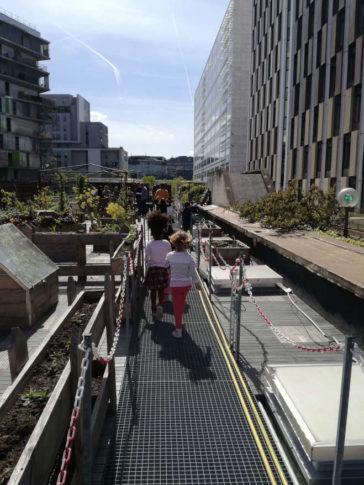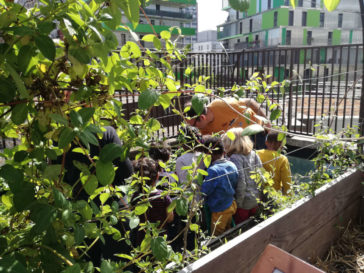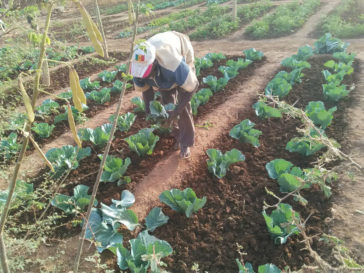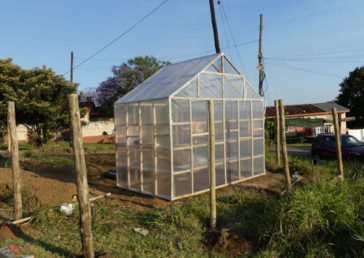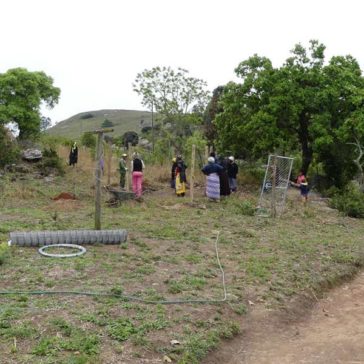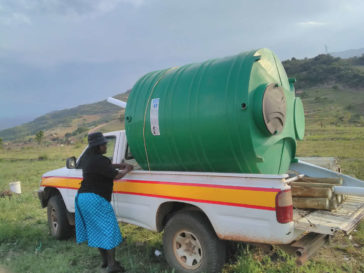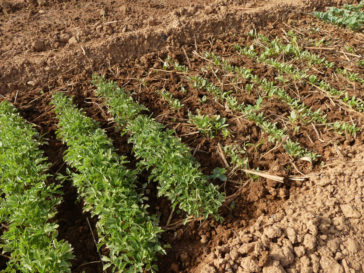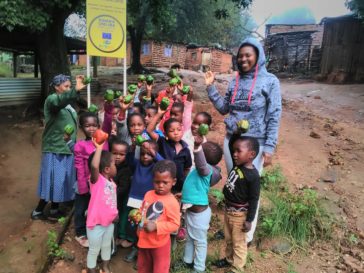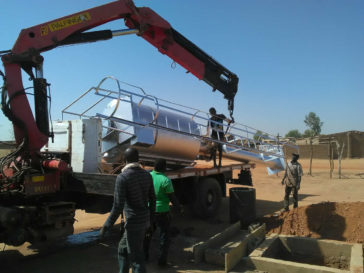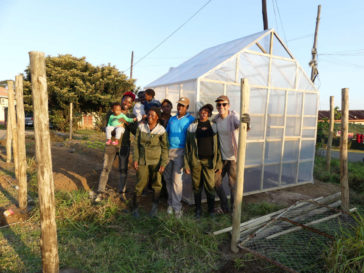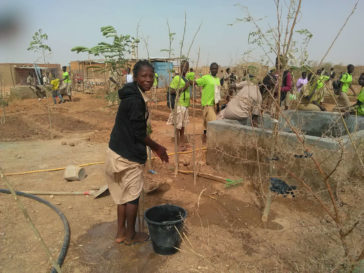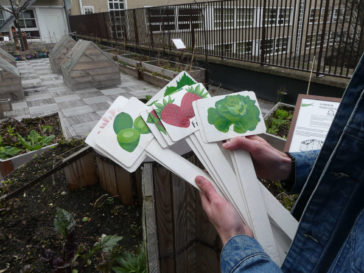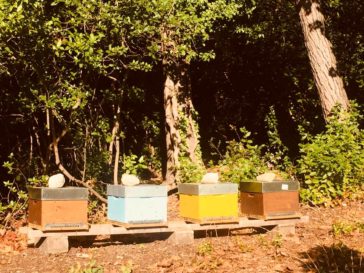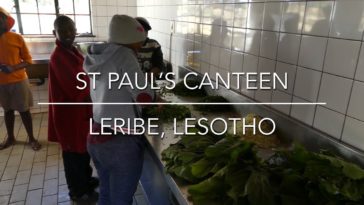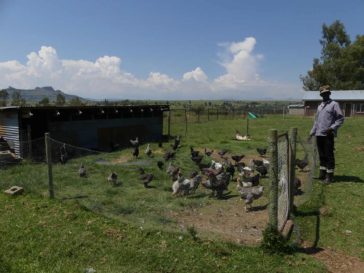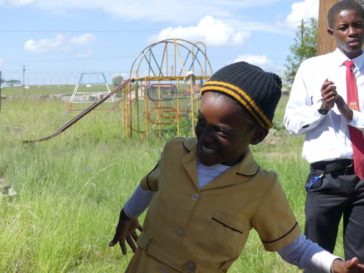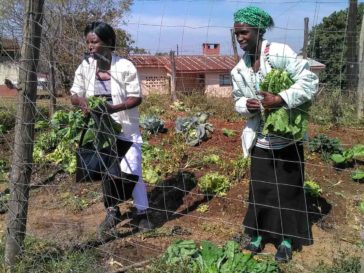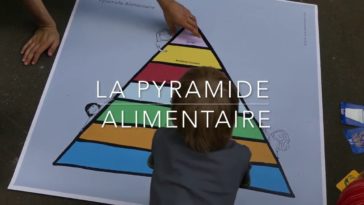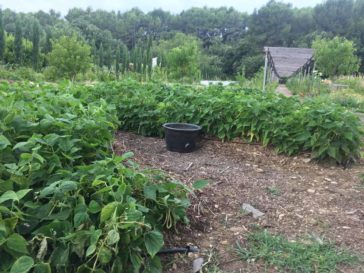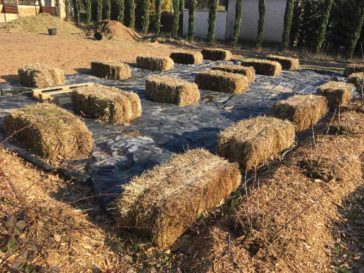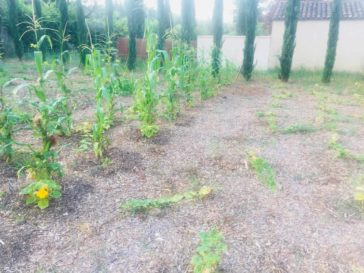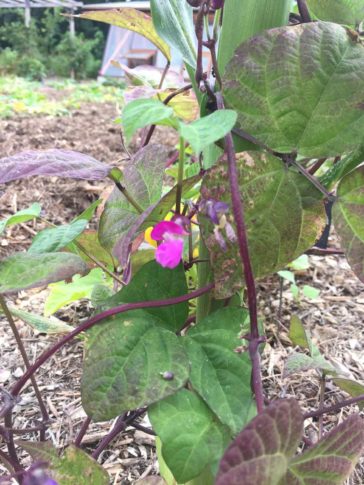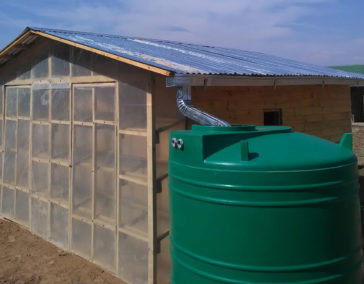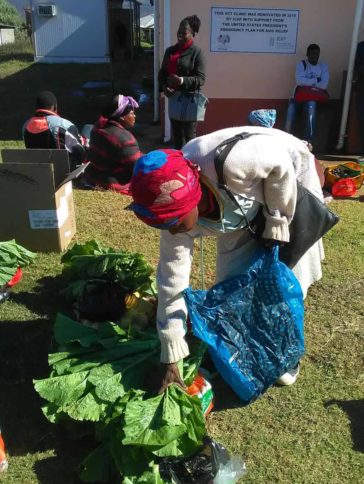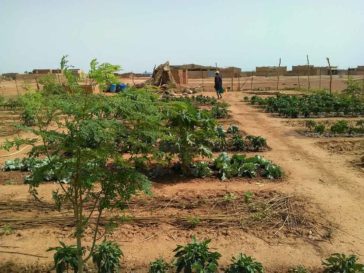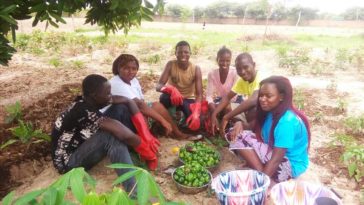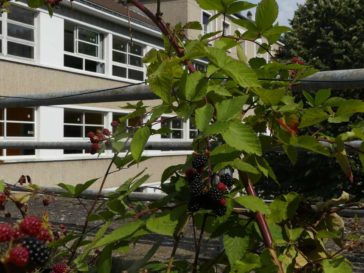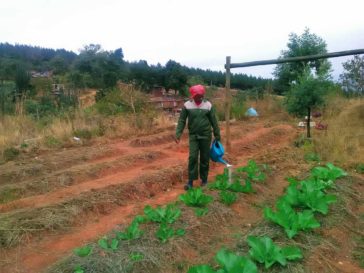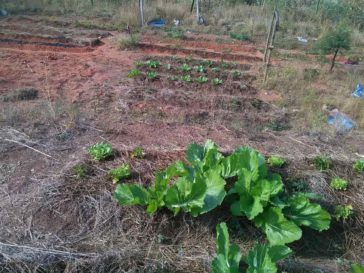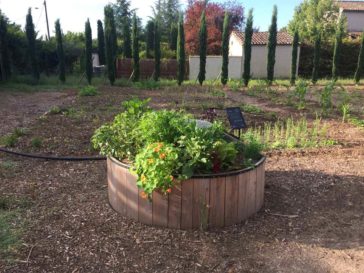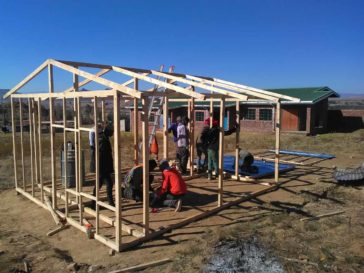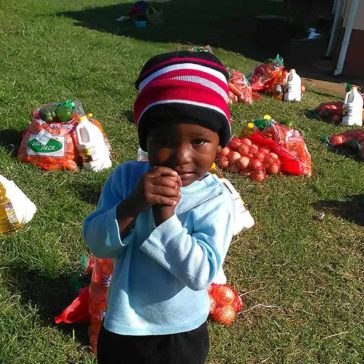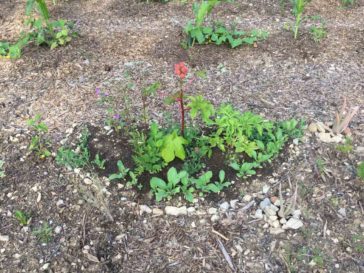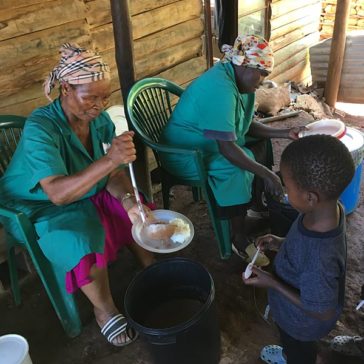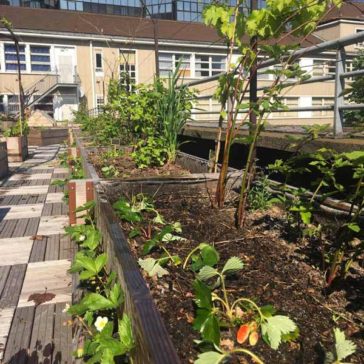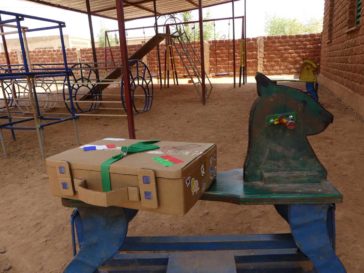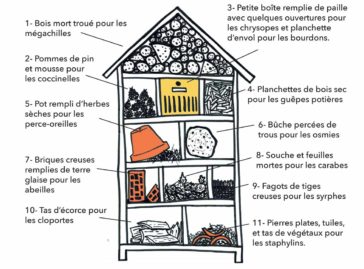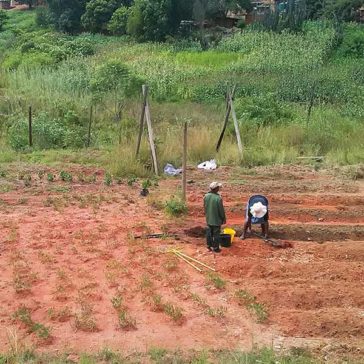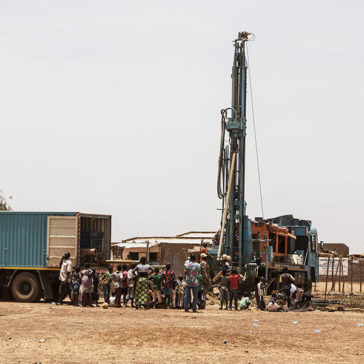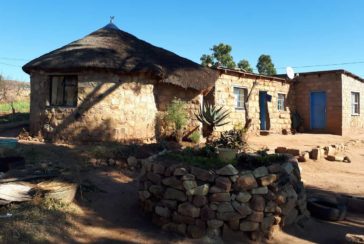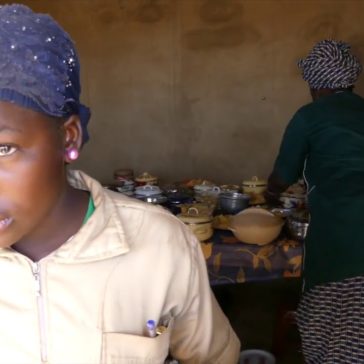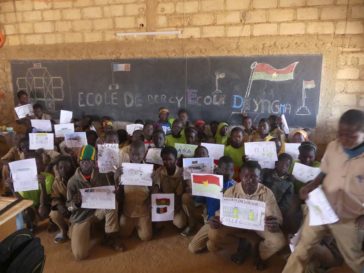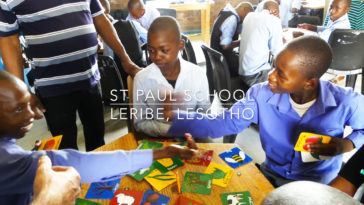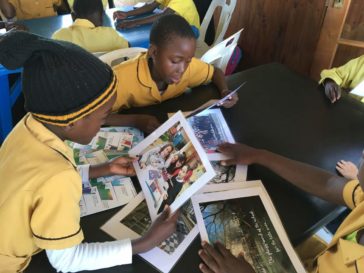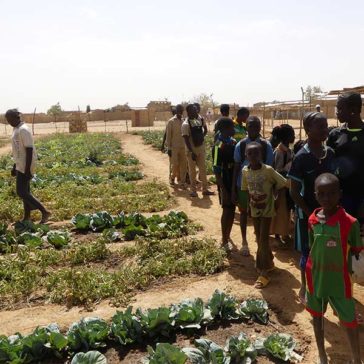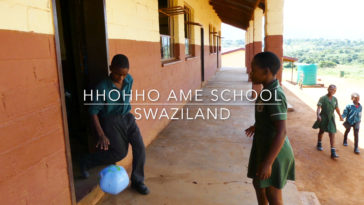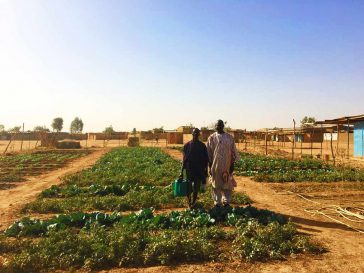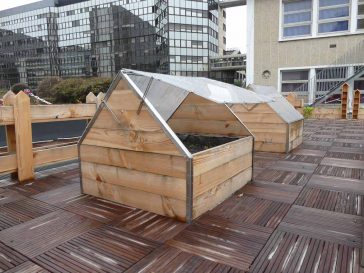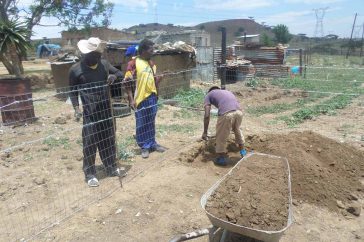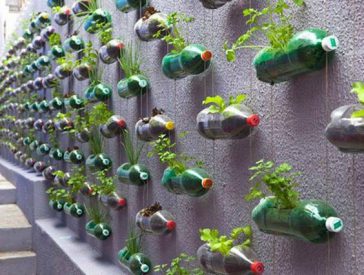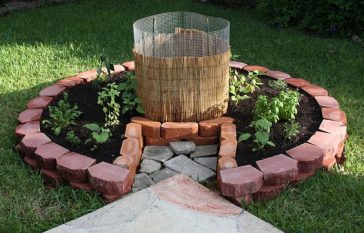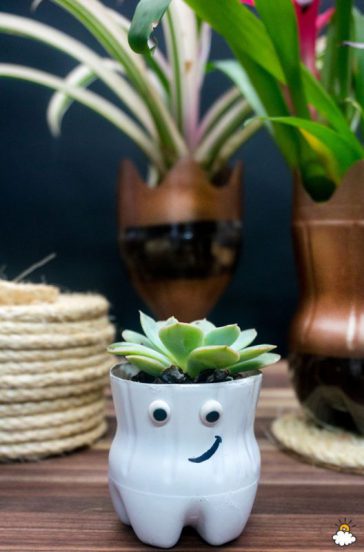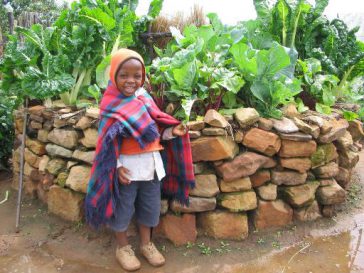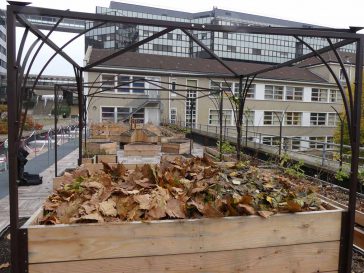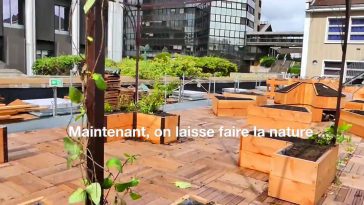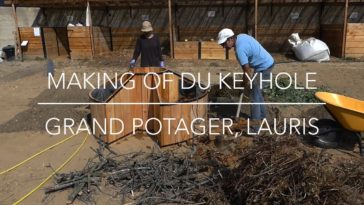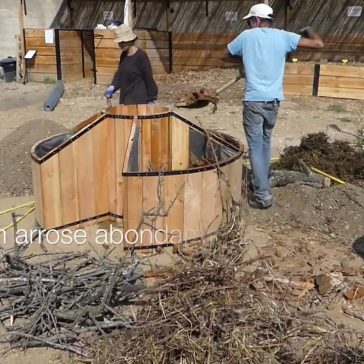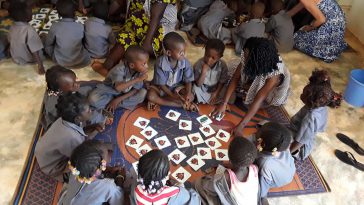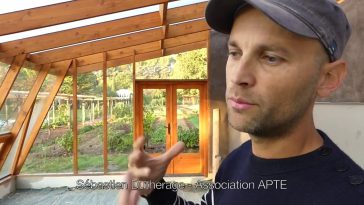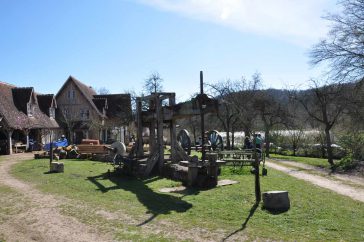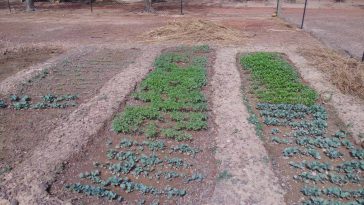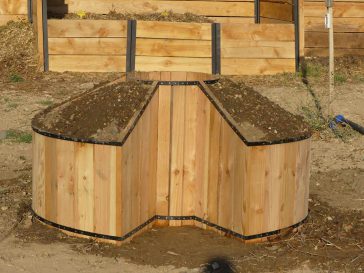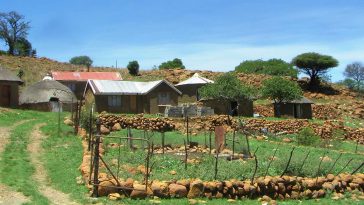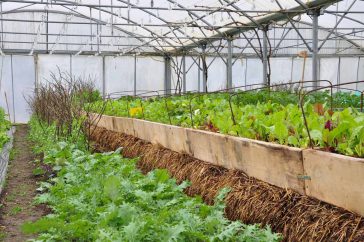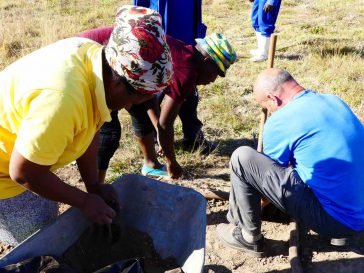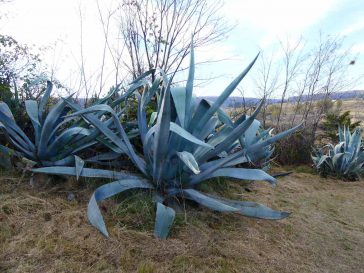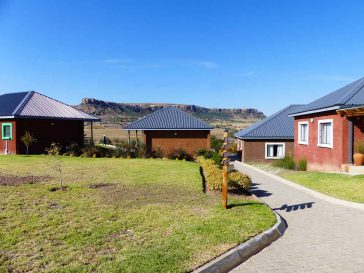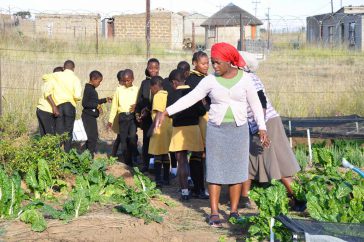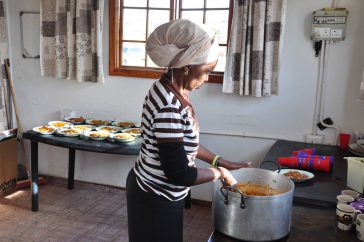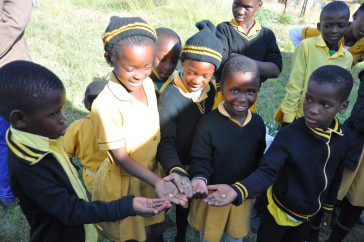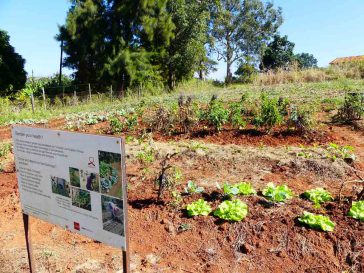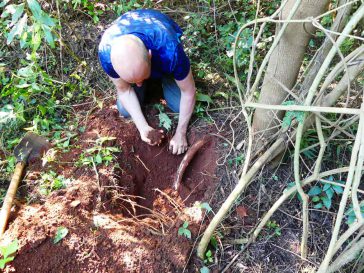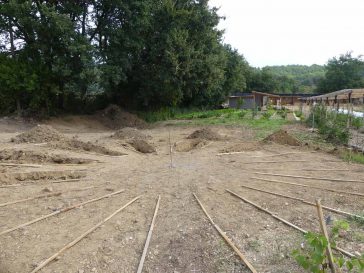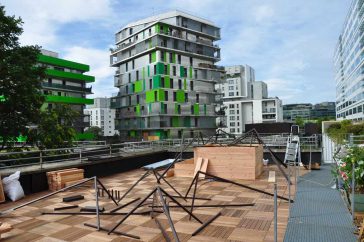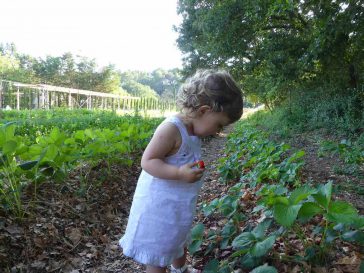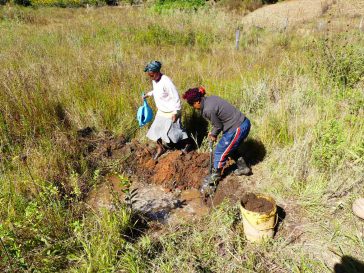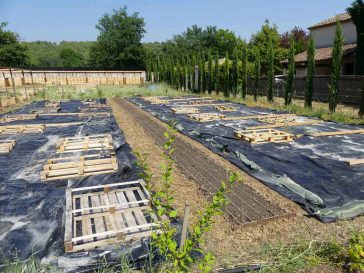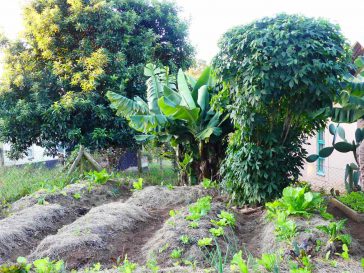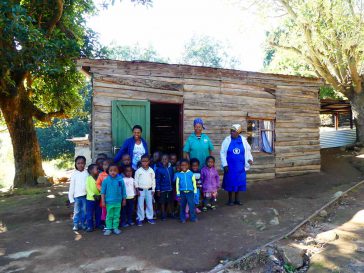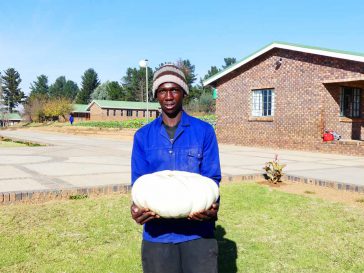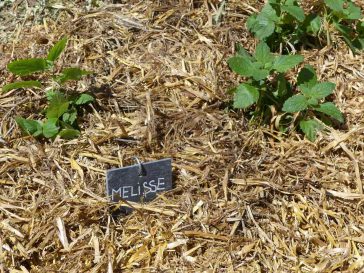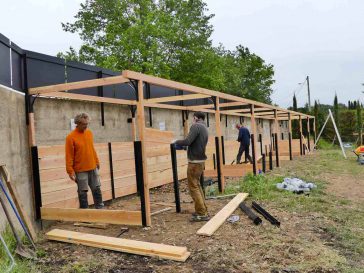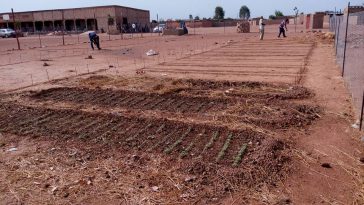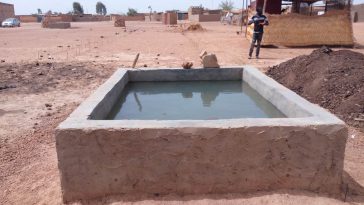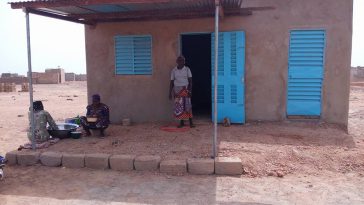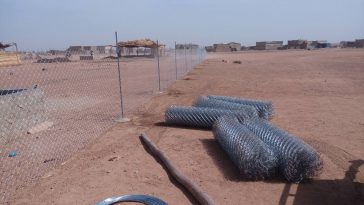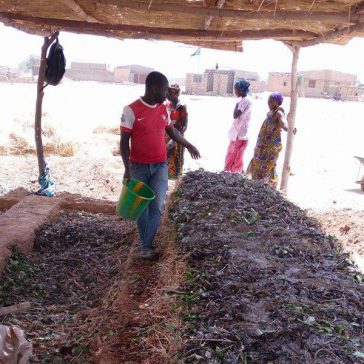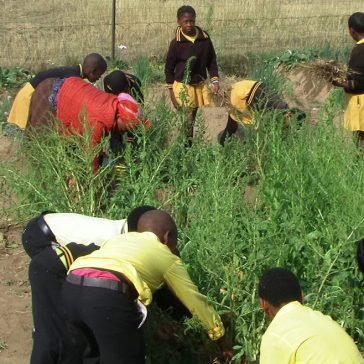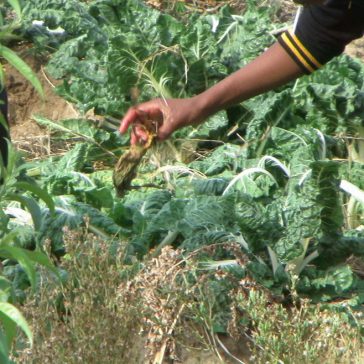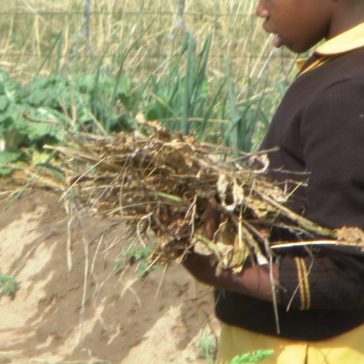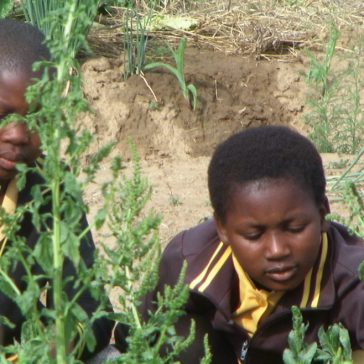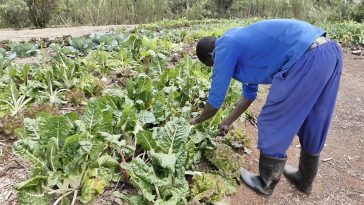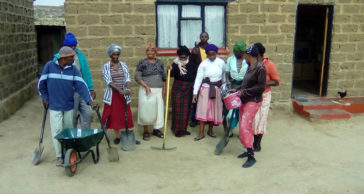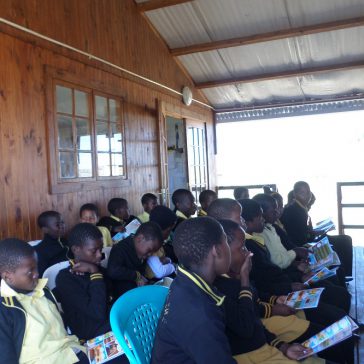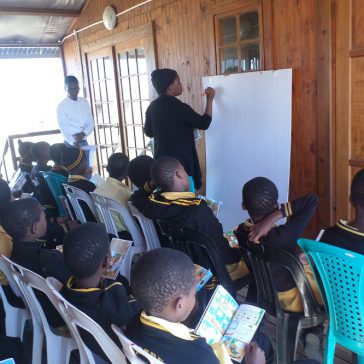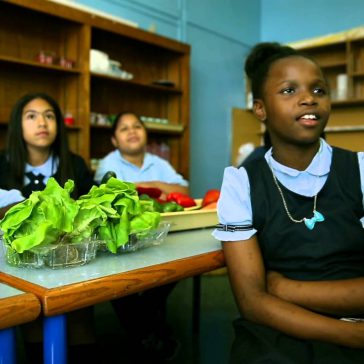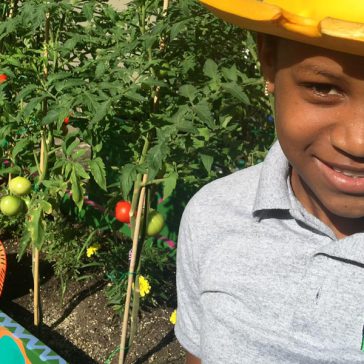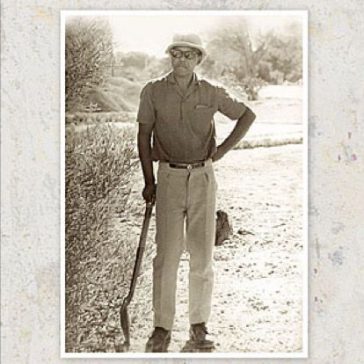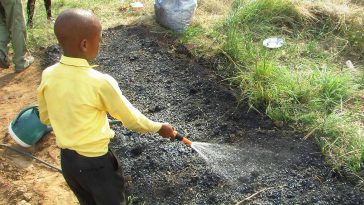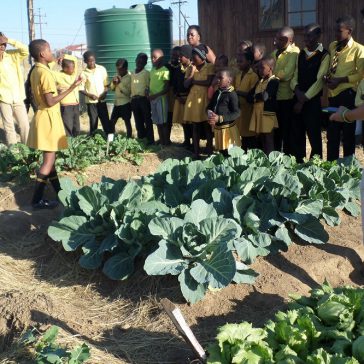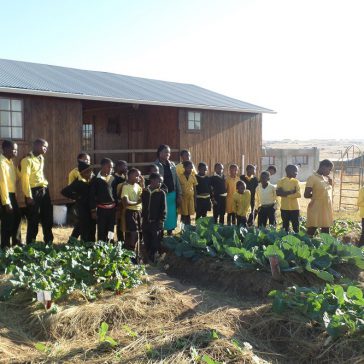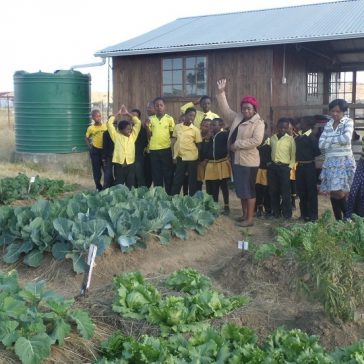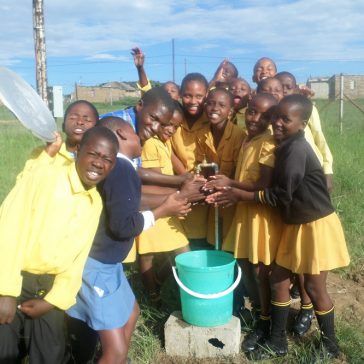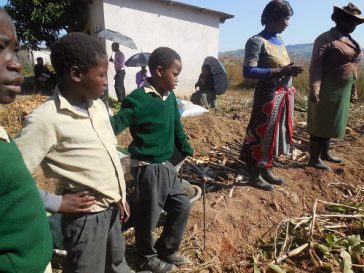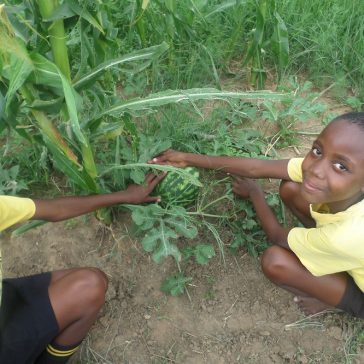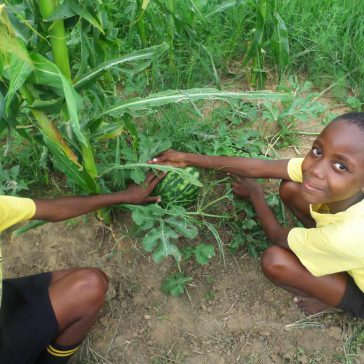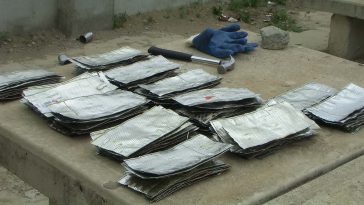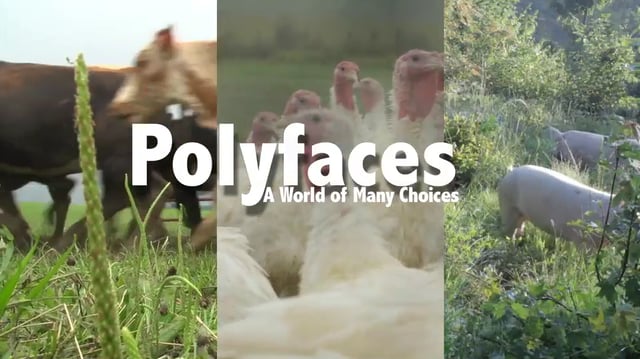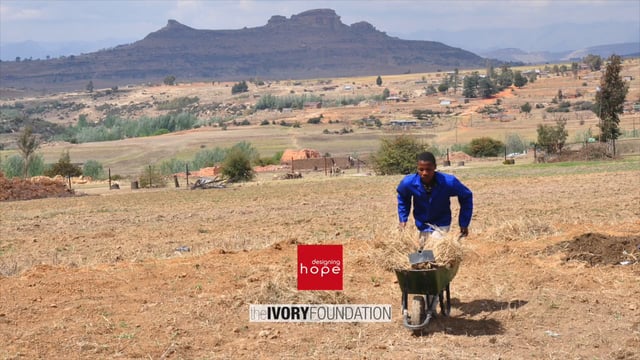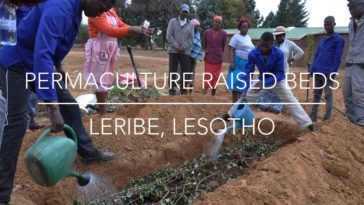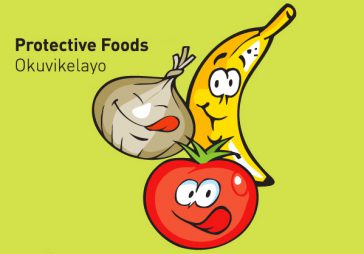Most objects that are usually sold by specialists can be built by collecting raw materials or – even better – recycled materials.
Distribution of school uniforms in Malanti
A wonderful initiative was recently launched near Malanti: the distribution of school uniforms to underprivileged children in local schools. The aim is to help families in difficulty and ensure that all children can go to school in a country where … Read More
Filling the trays in the Rufisque garden
Joseph, who is in charge of the Rufisque garden, has prepared a mixture of compost and potting soil to fill the trays in the new vegetable garden structures. It’s a team effort that’s much appreciated by the children, who love … Read More
Traversine Bercy Radish seedling
It’s Friday, the last day of the week before the weekend! So it’s time for some special care for the garden, which will spend the weekend on its own. The children from the Bercy school helped us to water and … Read More
Traversine Bercy The garden on the Bercy roof terrace has been installed !
This day has arrived! We’ve finished assembling the garden on the roof terrace of the Bercy nursery school.All the structures are in place. All that’s left is for nature to do its work (and us too)!
Maintenance of tomato plants in the Traversine Bercy garden with a pupil from the Bercy school.
The tomatoes sown with the children from the Bercy elementary and nursery schools were able to be transplanted into the greenhouse and benefit from the ideal sunshine of the school’s roof terrace. Since they were placed in the tubs, they … Read More
Traversine Bercy planters maintenance
This Wednesday, exceptionally, we only had one pupil from Bercy elementary school, as the children were on a field trip. She was very committed and helped us water, weed and take care of the garden. We’re particularly pleased with the … Read More
The animals at Levi’s Nek Farm
Every day, the young residents of Levi’s Nek Farm take it in turns to look after the animals. The hens are now fed on the farm’s self-produced maize meal. The sheep graze during the day and return to the farm … Read More
Preparing new plots at Levi’s Nek
Plot by plot, the young residents of Levi’s Nek Farm optimise the space available for cultivation. They work with local farmers for the first ploughing, using cattle to pull the ploughing tools. The grelinette, an 80 cm wide spade, a … Read More
Construction of a second greenhouse at Levi’s Nek, Lesotho
The young residents of Levi’s Nek Farm, who are deaf and hard of hearing, are building a second greenhouse as an extension to the first. This will give them a covered area of 400m2 for market gardening. This space will … Read More
First plantings in the greenhouse at Levi’s Nek, Lesotho
After preparing the growing beds, the young residents of Levi’s Nek Farm had the pleasure of planting their nursery-prepared lettuce plants. These plants, grown from seeds supplied by our partner Agrosemens, will benefit from a protected space during the southern … Read More
Planting onions in the Traversine Bercy garden
Children from the Bercy nursery school have planted shallot bulbs to start filling the containers around the star in the Traversine Villiot garden.Other vegetables will follow, to create a concentrated vegetable garden in this sunny spot in the heart of … Read More
Assembly of the Traversine Bercy star-shaped bin
The Traversine Bercy has been given a new design following its relocation in 2021 due to a problem with seepage on the roof! The mandala has been replaced by a star-shaped planter, surrounded by 4 angled planters placed between each … Read More
Filling containers with leaves, Traversine Bercy, Paris
To reduce the weight of the planters, dead leaves from the schoolyard were collected and composted over a period of 2 years and placed at the bottom of the planter to create a rich, light substrate before planting the soil. … Read More
Niebe harvest at Levi’s Nek Farm – Lesotho
The young residents of Levi’s Nek had the opportunity to try their hand at growing cowpeas, a bean that is highly prized in West Africa for its leaves and seeds. Dried beans are widely consumed in southern Africa, so the … Read More
Extension of the Rufisque Garden
At the request of the school, which has noted the success of the Rufisque vegetable garden, we are extending the garden to increase the production of vegetables for the kitchen and involve more children, particularly the younger ones in nursery … Read More
Planting aromatic plants on the terrace of the Traversine Bercy – Paris
A new stage in the construction of the garden at the Traversine Bercy, with the installation of the herb garden. The little gardeners from the Bercy nursery helped to fill the containers, and had the pleasure of transplanting sage, chives, … Read More
Assembling the trays for the Traversine Bercy terrace
It’s assembly time ! Once all the materials have been reassembled on the roof, installation can begin. The Douglas fir boards have been pre-cut to size according to the new garden plans. Once the boards have been screwed in place, … Read More
Transplanting young seedlings in the greenhouse on the Traversine terrace
In anticipation of the Traversine’s return to the school’s roof terrace, seedlings were sown in class with the children from the Bercy nursery school.This gave them a heated space in which to grow. To ensure that they continue to grow, … Read More
Outdoor activities at Halfway House in Roosboom, South Africa
The Halfway House is a place for children to relax and enjoy themselves after school every day. They can enjoy outdoor games as well as board games inside the house, in addition to the daily meals they are served.These happy … Read More
Preparation of the cultivation beds in Levi’s Nek Farm greenhouse.
The greenhouse at Levi’s Nek Farm is now up and running! In order to get the greenhouse operational without delay, the young residents set about installing the growing beds inside. To do this, they applied the principle of permaculture and … Read More
Tree growth on the Garden of Skills’ cultivation beds
The trees in the Garden of Skills have started to grow and are now approaching 1 metre in height. In a year’s time, they should reach 3 metres and start providing shade for the crops while fertilising the soil on … Read More
Planting chives in the Garden of Skills community garden
While waiting for the seedlings to be ready for transplanting, the Garden of Skills team gave chive plants to the women who will be benefiting from the new community garden. Each woman will place them on her three growing beds. … Read More
The Garden of Skills’ turmeric plants are in flower!
The Garden of Skills’ turmeric plants are in flower!Soon the tubers will be ready to be harvested underground, to be used to flavour the dishes cooked for the women who benefit from the garden.
Garden maintenance with the children of the HalfWay House
The children from the Halfway House work on the vegetable garden with the centre’s gardener and two carers, Lulu and Fisani.
Extension of the Garden of Skills
The Designing Hope association and its local partner Fundzisa Live approached the community of Malanti about extending the Garden of Skills to invite women from the community to set up individual plots. The community responded favourably to this request, and … Read More
Preparing seedlings with the children of Halfway House in Roosboom – South Africa
The children play an active role in maintaining the garden that provides the vegetables for their daily meals. Today, they planted seedlings that will soon enrich the vegetable garden.
Maize shredding at Levi’s Nek Farm – Lesotho
A shredder has been purchased to equip the farm of the young deaf and hard-of-hearing residents, enabling them to transform the harvested maize stalks into feed for their poultry. The youngsters had the ingenious idea of using the grinder to … Read More
Collaboration with the Emmanuel Health Centre, Levi’s Nek – Lesotho
A local health centre, located near the Levi’s Nek farm, has been approached with the aim of developing links with the deaf young residents of the farm. A counsellor from the hospital, currently based at the clinic, will take part … Read More
Donation of uniforms to the Emmanuel Health Centre, Levi’s Nek – Lesotho.
The Parisian atelier Keit has generously donated medical uniforms to the association Designing Hope for distribution to its various African partners. The association gave the medical staff at the Levi’s Nek health centre the opportunity to choose an outfit from … Read More
St Paul School and the “Palisa” Garden
The six young students from St Paul’s School are responsible for the maintenance of the ‘Palisa’ garden. The garden has been divided into four sections. Each class at St Paul’s is responsible for maintaining one part of the garden, once … Read More
Visit of the workshop at Levi’s Nek Farm – Lesotho
The workshop at Levi’s Nek Farm is now fully equipped, allowing the young residents to make themselves everything they need for the farm. For example, to build their greenhouse, they made a metal ladder, which they were able to weld … Read More
Preparing winter seedlings in the Garden of Skills, Eswatini
Fesile presents the seedlings sown in the greenhouse as the southern winter approaches.The seeds were selected from the organic seed catalogue of agrosemens, a partner of Designing Hope.
Potato planting in the Traversine Villiot garden with children from CLAJE
This afternoon, children from the Paris Anim centre (CLAJE) came to the Traversine Villiot garden for a potato planting activity. Potatoes are easy for children to plant: all they have to do is put a tuber in the ground, which … Read More
Seedlings with children at Roosboom
The children at Halfway House in Roosboom are taking good care of their seedlings, taking turns watering them every day. There’s still a few days to wait before they can be planted in the vegetable garden…
Maintenance of the greenhouse at Half Way House in Roosboom.
The greenhouse is an important part of the garden at HalfWay House in Roosboom. It allows nurseries to be set up sheltered from direct sunlight, and protects certain crops from invasions of locusts and grasshoppers. The children also help the gardener … Read More
Redevelopment of the Traversine on the roof of the Bercy nursery school
After three years of work, the roof of the kindergarten is once again available to the Designing Hope association. The installation of the Traversine garden in its new configuration began with the re-installation of the little house-shaped greenhouses, so popular … Read More
Fencing around the pasture at Levi’s Nek farm, Lesotho
The young residents of Levi’s Nek farm have started to put up the fence around the farm’s pasture. This area of over a hectare is situated high above the farmhouse, on the edge of the forest. The fence will enable … Read More
Children of Roosboom take care of the flower shape Mandala garden
The children at Halfway House and the centre’s gardener take great care of the flower-shaped Mandala vegetable garden.Before winter, tagetes, cabbage and spinach remain on the petals.
Setting up the greenhouse at Levi’s Nek farm – Lesotho
Following the successful construction of a 300 m² greenhouse at the Saint-Paul School for the Deaf and Hard of Hearing in Leribe, the young residents of Levi’s Nek have embarked on the construction of two other structures, each measuring 200 … Read More
Coverage of the greenhouse – Levis Nek
After installing the wooden poles, metal rods and ropes, the young people proceeded to cover the greenhouses with a sun-resistant textile, providing protection against the scorching rays of the sun and heavy seasonal rains in southern Africa. This textile was … Read More
Setting up the greenhouse at Levi’s Nek farm – Lesotho
After setting the vertical poles in cement, the young residents of Levi’s Nek Farm position the horizontal metal rods and wires that will support the fabric covering the greenhouse.
Vegetable domino game with children from the Handiscole school in Rufisque
Among the games available to children at the Rufisque school, the vegetable domino game is particularly popular. The children have to find the vegetables corresponding to their coloured board. They then have to sort the vegetables by size on their … Read More
Games with the children of the Handiscole school in Rufisque
Designing Hope has provided educational games based around vegetables, which are particularly popular with the children at the Rufisque school. Joseph is in charge of these classroom activities, as well as working directly on the school roof to water and … Read More
Maintaining the garden with the children of the Handiscole school in Rufisque
Several times a week, children from the Handiscole school in Rufisque help to maintain the vegetable garden installed by Designing Hope on the school’s roof terrace. Joseph, the gardener, accompanies the children along with their teachers.
Two herb tables for Rufisque nursery schools
A second terrace has been added to the Rufisque garden. For the moment, it includes two seedling tables dedicated to herbs, soon to be supplemented by additional modules.
Distribution of food parcels to Piggs Peak hospital
Every month, Designing Hope and its local partner Fundzisa Live distribute food parcels to the most vulnerable HIV-positive patients treated at Piggs Peak Hospital. They benefit from this programme for 6 months, in order to strengthen their natural defences.
Fencing around the pasture at Levi’s Nek farm, Lesotho
The young residents of Levi’s Nek farm have started to put up the fence around the farm’s pasture. This area of over a hectare is situated high above the farmhouse, on the edge of the forest. The fence will enable … Read More
Sowing seeds with the Paris Anim’ centre (CLAJE)
This Wednesday afternoon, the children from the Paris Anim centre (CLAJE) came to the Traversine de Villiot garden for a sowing activity. We provided them with mini greenhouses, composed of a equipped with a water reserve, a seedling tray and … Read More
Sowing with children from Bercy school
The children at Bercy primary schools planted tomatoes, okra, cowpeas and kale. They have completed four mini greenhouses, each with two different varieties to diversify the planting. Their mission is not just a one-off one, but a recurring one, as … Read More
Setting up the Dawady greenhouse, Senegal
With the support of The Ivory Foundation, a 200m2 greenhouse has been installed in the Dawady community vegetable garden. The greenhouse will enable the 150 women who contribute to the garden to produce seedlings together, and will also enable local … Read More
Presentation of leaflets on nutrition to the women of Ndioum, Senegal
A series of manuals on nutrition, published by The Ivory Foundation, has been distributed to the gardens funded by The Ivory Foundation in Senegal. The manuals stress the importance of a balanced diet, and encourage women to grow a variety … Read More
Visit of the Ndioum’s garden
Ndioum is one of the 20 villages visited by Bala’s mobile team in eastern Senegal. The Ivory Foundation financed the creation of a shared vegetable garden for the women of the village. This plot has been fenced off to protect … Read More
The Moringa of Bala
On the Bala seed farm, a new agroforestry technique has been introduced outside the greenhouse. It involves creating growing corridors surrounded by Morigna trees, planted in rows and trimmed to form a hedge. These corridors are 4 metres wide and … Read More
Seed production on the Bala farm, eastern Senegal.
Abdhouramane, manager of the Bala seed farm, tells us about the crops grown in the greenhouse: aubergines, turnips, lettuces, onions… the greenhouse combines several species, but in a single variety to preserve the varietal purity of the species selected by … Read More
The workshop at Levi’s Nek farm
The construction of a workshop has been launched to provide the young residents of Levi’s Nek farm with a workspace and a place to store their equipment. Once up and running, this workshop will enable the deaf and hard-of-hearing young … Read More
Management of the garden at St Paul’s school
The six young students of the St Paul’s school pilot farm are looking after the cabbage and spinach grown in the greenhouse, which will soon be used by the kitchen to provide meals for the pupils. At the same time, … Read More
Vegetable color family game with children from Bercy school
This Wednesday, February 14th, the children at Bercy school played a board game that challenges their memory and cooperation: the vegetable colour families game! The game includes 7 vegetable colours, with 6 vegetables per colour, making 42 cards in duplicate. … Read More
Okra seeds harvest on Rufisque garden
Joseph, the gardener at the Rufisque school, harvested an excellent crop of okra this year. Following a training course organized with The Ivory Foundation, he harvested the best fruits, dried them and extracted the seeds. The seeds used were organic … Read More
Growing Milpa on the Levi’s Nek farm – Lesotho
After planting maize on one of their plots, the young people at Levi’s Nek farm are now sowing climbing bean seeds at the foot of the maize plants that have already grown. They use the Milpa technique, which involves combining … Read More
Discovery of a new board game
Today, the children at Bercy primary schools discovered an exciting new board game. It’s called Clover! In this game, they have to use their creativity and logic to find combinations of vegetables and fruit. Each card they place on their … Read More
Preparing bread at Levi’s Nek Farm
At Levi’s Nek, the division of tasks between the young residents works perfectly well! Damane is the group’s baker, and twice a week he prepares bread for the 10 residents of the farm. The bread is baked in a pan … Read More
Transplanting strawberry plants, sweet potatoes and Chya on Levi’s Nek Farm, Lesotho
Exchanges of experience between projects in southern Africa also take the form of exchanges of plants and seeds. For example, the women from the Garden of Skills have given sweet potato plants, strawberry runners and Chya cuttings to the young … Read More
Landscaping around Levi’s Nek Farm, Lesotho
An herb garden has been created at the entrance to the farm, using stones salvaged from old buildings to create a terraced garden and steps to access the garden. Aromatic herbs and medicinal plants were purchased from a nursery in … Read More
Harvesting Chya leaves, Garden of Skills, Eswatini
Chya is a shrub from Mexico that was imported to Africa because of its resistance to drought and its higher nutritional value than most other leafy vegetables such as spinach, Chinese cabbage and amaranth. It is a good source of … Read More
Inauguration of the Christmas Tipi of the Villiot garden
The tipi in the Traversine Villiot garden was decked out with plant decorations made by children from the Bercy school, nursery school, creche and Paris Anim centre. Mrs Emanuelle Pierre-Marie, Mayor of the 12th arrondissement, came to inaugurate our Christmas … Read More
Planting broad beans and peas with Bercy’s nursery school children
This December, despite the cold, the kindergarten children planted broad bean and pea seeds, which are particularly suited to the winter season.These seeds are ideal for very young children, as they are easy to handle, given their size.After planting the … Read More
Making ivy garlands for the Christmas teepee.
During the summer, the tipi in the Villiot garden is covered with climbing beans and squash. With no vegetation left over the winter, we decided to bring it back to life by transforming it into a Christmas tree! We organised … Read More
Painting bread apples for the “Christmas Tipi” of Villiot Garden
Designing Hope has mobilised all the children who benefit from the Villiot garden to transform the potager’s tepee into a Christmas tree. This morning, 8 children from the Villiot crèche contributed to the project by decorating bread apples with red … Read More
Sowing broad beans in the traversine Villiot garden
Broad beans are one of the few crops that have to be sown in late autumn.Their large seeds are easy for the children to plant, and in a few days they will be able to see the shoots emerge…Another advantage … Read More
Composting with children from the Villiot nursery school
This morning, the children from the nursery school arrived with their compost buckets. Enthusiastically, they put the peelings in our dedicated wooden bin. Then they went to pick up some leaves to add to the compost. Using a stick, they … Read More
Dawady’s outlying gardens
Malik and Abdhouramane, Dawady’s two gardeners, are tasked with visiting the shared gardens run by women in 5 outlying villages. They travel to the bush by motorbike every month to monitor the needs of these gardens…
Construction of the new workshop on the Levi’s Nek farm
The latest phase in the development of the Levi’s Nek farm is the construction of a 6×3 metre workshop, close to the other buildings.This workshop includes an enclosed storeroom for tools and animal feed, and a covered area where young people can work with wood or … Read More
Watering the garden in Rufisque, Senegal
Children from Handiscole’s inclusive Petits Princes school in Rufisque help Joseph, the gardener, to water the vegetable garden installed on the roof of the school by Dessine l’Espoir. It’s a relaxing moment for the children, who enjoy tending the garden as the … Read More
New work outfits !
The women of the Garden of Skills now wear work outfits created in the center’s sewing workshop. These unique jackets bear the Porte-Bonheurs flower. The patterns and design were created by Keit, our sewing project partner. The garden team stands … Read More
TeenGi watering with children at Malanti
Watering the garden with the nursery children has become a regular and popular activity. Under the supervision of Tolaklele, a member of the garden team, and Ncobizwe, head of the creche, the children play an active role in maintaining the … Read More
Blackcurrant cuttings at Traversine Villiot
The end of winter is the perfect time to take cuttings.So, with the help of the Claje children, we pruned the blackcurrant bush in the Traversine Villiot garden.Children with balconies were able to take a pot home with them, with the promise … Read More
Sowing broad beans with CLAJE children at Traversine Villiot
Broad beans are one of the few crops that have to be sown in late autumn. Their large seeds are easy for the children to plant, and in a few days they will be able to see the shoots emerge…Another … Read More
The Silethithemba team dressed by the Garden of Skills sewing workshop.
Fisani and Lulu were able to try on their work jacket and trousers made by the team at the Garden of Skills sewing workshop in Eswatini. The made-to-measure workwear bears the logo of the local association that runs the Halfway House in Roosboom. A … Read More
Set up of the nursery at Malanti
A nursery has been set up for the children of women in training. Thanks to the support of the AA Ulmann Foundation, this facility enables the women to engage fully in a professional activity or training program, while providing a … Read More
Germination test on old seeds
To carry out a test protocol on seeds to ensure that they have retained their germinative germinative properties, you can work on twenty seeds, sown in pots. The seed packets and plates are identified. All the seeds with a good germination rate can then be sown immediately on a … Read More
Preparing the beds at Roosboom
The beds in the garden at Halfway House in Roosboom have been redesigned by the gardener in charge of the kitchen garden. They are now ready for spring planting, and to benefit from the arrival of the first rains after … Read More
Game about the vegetables at Roosboom
Children enthusiastically play the games developed by Dessine l’Espoir around vegetables from the kitchen garden. These fun and educational activities enable youngsters to discover the world of vegetables in an interactive and entertaining way. Thanks to these games, they learn … Read More
Outdoor play at Roosboom
The children at Roosboom enjoy playing outside on the large lawn at Half Way House after lunch, while others water the garden with the centre’s gardener.
Vegetable life memory game at Rooseboom
The youngsters at the Half Way House in Rooseboom were able to try out the new game launched by the association, which completes the transgardens catalogue for educational games in all the gardens run by Dessine l’Espoir and The Ivory … Read More
New growing beds at Yagma
The gardeners at Yagma have put in place new planting beds following the end of the rainy season. The seedlings planted in October and November will benefit from a milder climate to reach maturity before the very hot weather starts in March.
Dismantling the stone house on the farm
In Lesotho, it is not uncommon for a landowner to want the house built on the plot of land he is selling back.The materials salvaged (stones, tin roof, window, door) will be used to rebuild the house elsewhere…This was the case … Read More
Ride to the top of Levi’s Nek mountain with the Farm’s young residents
Levi’s Nek farm is located in an exceptional natural setting, at the foot of a small hill that gives absolutely no hint of the exceptional view that can be enjoyed from its summit.The young people on the farm collect dead wood on … Read More
Metal workshop with deaf and hearing-impaired children from Levi’s Nek farm in Lesotho
The young deaf and dumb farmers were trained in metalwork. They were able to make the 12 bed frames for their dormitory, as well as the tables and shelves needed to fit out the farm. This skill is an asset that … Read More
Extension of the Levi’s Nek farm
With the support of The Ivory Foundation, a new plot of land has just been acquired to extend the farm.This plot is modest in size, but essential for the future of the project, as it can be built on.It will be dedicated … Read More
Meal at the farm
The Levi’s Nek farm has 2 dormitories and a shared living room where young people share their meals.The youths take it in turns to prepare their meals. They have got into the habit of cooking balanced meals for themselves, with … Read More
The animals at Levi’s Nek farm
A new species of indigenous hen has been introduced to the Levi’s Nek farm, and they are impressive for their size and plumage. They are also capable of laying large eggs, which are highly prized on the local market.The presence of several males … Read More
Making metal shelves for Levi’s Nek farm
Using off-cuts from the boards used for the beds, large shelves were designed to fit out the workshop and the storage room for seeds and feed for the farm animals.The aim was also, as part of the metal training offered … Read More
Board game evenings at Levi’s Nek
The youngsters at Levi’s Nek have taken a liking to board games. Dominoes, triominoes, uno – they’ve discovered this activity recently, and are enjoying this relaxing time together.
Making a workbench and metal tables
One of the first objects made during the metal training course organised by Cyrille Varet at Levi’s Nek farm for The Ivory Foundation was a workbench, the starting point for designing all the objects the woman will need… Other tables will follow, a sideboard … Read More
Painting of metal furniture by young residents of Levi’s Nek farm
While the young people on the Levi’s Nek farm may have unequal skills and potential, there is a constant desire on the part of the group for everyone to be involved in the farm’s activities.The strongest prepare the soil, while the weakest … Read More
Setting up the tree nursery at Levi’s Nek
The Ivory Foundation has provided the Levi’s Nek farm with grid seedling trays. These are modular, and can offer either 5cm or 10cm cells depending on the plants.
Seed production in the Yagma garden in Burkina Faso
Gardeners at the Yagma school have set up a nursery using seeds supplied by Agrosemens. The seeds are intended for seed production, according to a protocol developed during regional training organised by The Ivory Foundation with its seed partner Agrosemens in Senegal. The seedlings were … Read More
Extension of the canteen at Yagma school, suburb of Ouagadougou, Burkina Faso
The canteen at Yagma school was financed by The Ivory Foundation along with the surrounding agroforestry garden in 2017. This year, the Fund has financed its extension to provide the children with a refectory where they can have lunch sheltered from the … Read More
First plantings on the beds at Levi’s Nek farm
The young farmers on the Levi’s Nek farm have planted their first vegetable seedlings on the beds they have prepared near their home. These local beds will be planted with a variety of vegetables for the young people’s daily diet. Field crops will … Read More
Keyhole of the Traversine Villiot garden
The Traversine Villiot garden now has a new feature: a keyhole garden. It features a central composter, whose decomposing elements will feed the circular growing tray that surrounds it. This is a new educational space for the children who visit the garden every week.
Installation of a keyhole of the Traversine Villiot garden
Keyhole of the Traversine Villiot gardenThe Traversine Villiot garden now has a new feature: a keyhole garden.It features a central composter, whose decomposing elements will feed the circular growing tray that surrounds it.This is a new educational space for the … Read More
Preparing the planting beds at Levi’s Nek farm
The young people take possession of the Levi’s Nek farm at the end of the southern winter, which is cold and dry in Lesotho (temperatures can drop to -4 degrees). So it’s time to start preparing the beds for the market garden crops that will … Read More
Construction of the Levi’s Nek farm office – Lesotho
Levi’s Nek farm includes a house for the farm manager, with a separate office for farm administration, as well as an apartment for him to live in next to the youth dormitory.
Delivery of mattresses for the children’s dormitory
The Ivory Foundation has been supporting St Paul’s School for the Deaf and Hard of Hearing since 2015.This year, the Fund gave a boost to the school, which is struggling to secure financial support from the Ministry of Education, and financed the … Read More
Manure collection from a neighbor farm
The Levi’s Nek farm and the project it represents are beginning to be known by the surrounding community.The farm manager, with the support of the village chief, took the initiative of contacting the neighbours to present the farm and its objectives. Thanks … Read More
Shared meal at Levi’s Nek Farm
The young residents of Levi’s Nek Farm share their meal on the large table in the living room adjoining the two dormitories in the accommodation block built for them on the farm. Starch, vegetable sauce and chicken from the farm are on the … Read More
Feeding the sheep at Levi’s Nek farm
As they do every day, the youngsters at Levi’s Nek farm are in charge of feeding the sheep and hens.The hens’ pen will be opened first to allow them to feed themselves first, before their big neighbours the sheep are fed in turn…
Board game evening at Levi’s Nek Farm
Every evening, the young people at Levi’s Nek farm like to gather around the large table in the lounge at the entrance to the dormitories to play board games.
Mastering metalwork, an asset for running the farm
The main principle of the Levi’s Nek farm is to give the deaf and hard-of-hearing youths who run it the opportunity to be independent, to acquire as many skills as possible so that they are able to meet all their day-to-day needs … Read More
A farm surrounded by the mountains of Lesotho and South Africa
Levi’s Nek farm is nestled between several mountains. There’s nothing like climbing them to get a bird’s eye view of the farm, with its ploughed-up fields ready for planting.
Levi’s Nek farm youngsters around the fire
The young people at Levi’s Nek have got into the habit of preparing a fire every morning and evening.They use it to keep warm in winter, but there is always a pot on the fire, either to heat water for washing (despite … Read More
Bread-making at Levi’s Nek farm
The youngsters on the Levi’s Nek farm share the daily tasks involved in farm life.One of these tasks is the preparation of bread. 4 balls of pasta are kneaded by hand and placed in a large covered saucepan, where the bread rises and is then cooked over a … Read More
Improving living conditions for children at the St Paul school for the deaf
The Ivory Foundation has been supporting St Paul’s School for the Deaf and Hard of Hearing in Leribe since 2015. While this support has until now focused mainly on setting up vegetable and animal protein production facilities to feed the … Read More
Inter-project exchange and human collaboration between Lesotho and Eswatini
At the opening ceremony of the farm, we donated the uniforms made by the women of the Garden of Skills in Eswatini to the youths, who were very touched by this gesture, as they had been trained in permaculture by … Read More
Opening ceremony of Levi’s Nek Farm
In order to help the young deaf and hard-of-hearing residents of the farm integrate into the Levi’s Nek community, an inauguration ceremony was organised for the young people, members of their families (some of whom came from very modest backgrounds and lived … Read More
Youngsters from Levi’s Nek farm in their work clothes
At the inauguration of the Levi’s Nek farm, the young people were able to see and try on the complete outfit made for each of them by the women of the Garden of Skills in Eswatini. They were extremely proud … Read More
Bulembu biochar
For almost 10 years now, the biochar burner installed by The Ivory Foundation in Bulembu has been working tirelessly to produce this input that helps retain water and nutrients in the soil, while capturing carbon in an environmentally friendly way. Two people are in … Read More
Useful Insects
The insects By observing insects in nature, one learns a lot about their way of life. Insects known as pests are eaten by other so-called auxiliary insects. Pollinators that forage flowers are essential for the reproduction of many plants and … Read More
Strawberry harvest in Malanti
The women at the Garden of Skills love strawberries, and strawberries really thrive in Eswatini…The small plot dedicated to this crop has been considerably enlarged, thanks to the collection of runners and their transplanting onto new plots. These strawberries are … Read More
Malanti greenhouse maintenance
The Malanti greenhouse provides a protected space for seedlings from the nursery, sown in pots, as well as for a selection of vegetables protected from the sun and insects.
Harvesting vegetables for hospital distribution
The women in charge of the vegetable garden at the Garden of Skills have picked a large harvest to add to the food baskets distributed to hospital patients. Fresh carrots and beetroot will join other vegetables and essentials bought in town for distribution to … Read More
Malanti garden maintenance
The women in charge of the beds in the Garden of Skills put into practice the well-known advice of gardeners: “One hoeing is worth two waterings”. By loosening the upper crust of the soil, the water is able to penetrate … Read More
Carrot harvest in Malanti
Nomvula, head of cultivation at the Garden of Skills in Malanti, harvests carrots to unthicken her beds, entrusting part of the harvest to a disadvantaged young person from the community of Malanti, who receives regular help from the association with donations of … Read More
Maintenance of the Malanti mandala
The Mandala in the Garden of Skills is a concentration of all the species grown in the vegetable garden at the Malanti centre. Located at the entrance, it plays both an aesthetic and educational role. Located close to the vegetable garden, it’s also the ideal … Read More
Building a shelter for the animals at Levi’s Nek farm
The young people at Levi’s Nek farm have begun building a 12-metre-long shelter for the farm’s sheep and chickens. Levi’s Neck farm includes a one-hectare pasture for sheep and, in the near future, cows. This enclosed shelter is only used at night to protect the … Read More
The trellis of the Traversine Villiot garden
The trellis at Traversine Villiot is now entirely covered with mulberry trees! Maintained in this way, they are developing rapidly, with stems reaching up to 4 metres! Enough to provide a shady passageway that is beginning to fill with fruit … Read More
The mandala in the Garden of Skills
The mandala in the Garden of Skills is located at the entrance to the garden, near the kitchen. It includes a sample of the crops grown in the kitchen garden: shallots, tomatoes, lettuce, spinach, etc.
Transplanting strawberry runners
The strawberries love the Garden of Skills just as much as the women in the garden love the strawberries…Just the thing… The plants have produced a huge number of runners, which the women have taken care to transplant onto new … Read More
The importance of Yagma’s agroforestry vegetable garden in absorbing excess rainwater
In the Yagma school district, during the rainy season, the massive quantity of rainwater cannot be absorbed by the compact soil of the area, and runs off into pools that have formed in places in the middle of the city, encouraging the … Read More
Yagma under the winter rain
Every year during the rainy season, the Yagma district is flooded with water running down the dirt tracks.Real ephemeral rivers sometimes block the streets. The agroforestry garden at the Yagma school is shown in these photos as an island spared … Read More
Squash harvest in the Yagma garden
During the rainy season, the Yagma gardeners planted a combination of squash and maize in the school garden. Maize, which needs water, is particularly suited to this crop, and appreciates the companionship of cucurbits, according to the Milpa principle.
Boards of Moringa in Bala
At the Bala seed farm, a different agroforestry technique has been introduced. Until then, fertiliser trees had criss-crossed the land. On this new plot, the corridor cultivation technique was used. The moringa plants are planted in a tight row, and … Read More
Collection of educational games
Dessine l’Espoir has developed a collection of educational games about gardening and the environment. To make them easier to handle, the association has asked the women of Eswatini to make the bags, hand-embroidered with the name of the games and … Read More
Planting courgettes in Bala
As part of the seed production project launched in West Africa by The Ivory Foundation in collaboration with Agrosemens, Abdourahmane, the gardener at the Bala seed farm, is currently transplanting courgettes into beds in the seed greenhouse. Courgettes are preferred … Read More
The vegetables in Bala’s greenhouse
At Bala, Abdourahmane has set up a variety of crops. Two varieties of basil are grown for seed production. One is in flower and will soon be producing seeds. Okra will also be harvested once the fruit has ripened for … Read More
Bala greenhouse
At Bala, gardener Abdourahmane has planted a variety of local crops, including okra, chilli peppers and cassava.
The first team settles in at the farm in Levi’s Nek, Lesotho
With the dormitory now complete, three young people from St Monica said farewell to the farm that had been their home for 3 years and moved to their new home in Levi’s Nek. Three young people stayed on to look … Read More
Tasty dishes cooked by the farm’s youngsters
A local vegetable garden is planned to provide a variety of vegetables and herbs for their personal use.Until the garden is up and running, the vegetables have been bought from Levi’s Nek stores….
Construction of the Levi’s Nek farm manager’s house
The Ivory Foundation has planned to install the Levi’s Nek farm manager, Leepa Mosehle, who has been accompanying young deaf and hard-of-hearing people in this educational farm project since 2015. This building will include both his home and an office … Read More
Watering the Traversine by the nursery children
Twice a week, children from the Villiot nursery help to maintain the garden. After enriching the compost with peelings from their canteen, they help to water the vegetable garden.
Nursery school children plant lettuce at Traversine Villiot
As part of their work tending the Traversine Villiot vegetable garden, the nursery school children from école de Bercy transplanted lettuce plants onto the mandala and the garden beds.
The TIPI in the Traversine Villiot garden
The climbing beans sown last April on the Traversine Villiot tipi have reached the top in just a few months!The first flowers are starting to turn into beans! This species (from Agrosemens seed) produces purple vegetables that turn green when … Read More
Use of the campagnole in the Garden of Skills in Eswatini
The women of the Garden of Skills have had one since the launch of the project and make good use of it to prepare the beds. The cultivation plots have been sized to a width of 80cm to fit the … Read More
Maintenance of the planting beds at Malanti
5 women are in charge of the cultivation beds in the Garden of Skills, a daily task carried out since 2021, when the project began in the Malanti hills in Eswatini. Growing the plants in parallel rows at right angles … Read More
Seedlings in the Grand Potager
Herbs and edible flowers are an important part of the crops grown in the large kitchen garden at Lauris to enhance the dishes served by the Domaine de Fontenille restaurant.
The donkeys of the Grand Potager
Every year, two classes from Lauris spend a day in the large vegetable garden at the Domaine de Fontenille. The treasure hunt through the vegetable garden ends with a visit to the donkey patch, which is a big hit with … Read More
Balance game at the Grand Potager
One of the outdoor activities devised by Transgarden for children is a balancing game. The children turn two wheels: one indicating natural elements (pebbles, bread apples, branches, etc.) and the other indicating an area of the body (neck, forearm, elbow, … Read More
Biodiversity in the Grand Potager
The Grand Potager at Domaine de Fontenille, which is entirely organically farmed, is an ideal refuge for insects, which enjoy the flowers in the garden and help pollinate them.
Maintenance of courgette beds in Yagma
The Yagma garden team prepared courgette and maize beds before the onset of the rainy season. Maize requires a lot of water, so this season is ideal for planting and growing it. Its rapid growth will enable it to be … Read More
The Garden of Skills greenhouse
The Malanti greenhouse, built by young deaf and hard-of-hearing people from the Lesotho-based “Farming our Future” association, is a real asset for the women in the Garden of Skills. It enables them to sow their crops sheltered from the sun … Read More
Involvement of young people from Farming our future in the work of Levi’s Nek
Every day, the young beneficiaries of Farming our future take turns on the site to see the work in progress. They also help to transport materials to the site, which is difficult for lorries to access
The farmhouse at Levi’s Nek
The main buildings are now in place on the constructible part of the farm. The main building is typical of Lesotho, with its breezeblocks joined like stone and a worked cornice that surrounds and hides the corrugated iron roof. The … Read More
Finishing work on the Levi’s Nek dormitory
The exterior finishes was completed and the roof has been laid. The workers are finalising the interior fittings. In the living room, the tiles have been laid and a kitchen has been made to measure by a joiner.
Barbecue at the Half Way House
Every day, the Half Way House in Roosboom welcomes between 45 and 60 underprivileged children from the Roosboom township. To mark the presentation of the games donated by the Apprentices of Auteuil, a barbecue was organised to complement the daily … Read More
Construction of the volunteer chalet
As with the Jardin des Savoir-Faire in Eswatini, The Ivory Foundation called on Wendy Lane, a designer of wooden chalets, to create a double accommodation unit for its volunteers. The advantage of these structures, pre-assembled in a workshop in South … Read More
Sowing in the Garden of Skill’s greenhouse at Malanti
The women in charge of the Garden of Skills at Malanti in Eswatini are preparing the selection of seeds that they will put into pots in the greenhouse. It’s a painstaking task, so as not to waste this precious resource … Read More
Levi’s Nek borehole
The Ivory Foundation commissioned a local contractor to drill and install a pump to supply water to the Levi’s Nek farm. The presence of water on the site was essential to launch the construction of the farm buildings (cement production) … Read More
Colouring activity at Bercy school
As part of the extra-curricular activities at Bercy school, a colouring workshop was organised on the theme of “lucky charm” flowers by the Dessine l’Espoir association. After creating a model of their project, the children drew it on an A3 … Read More
Onion harvest in the Yagma school garden
The onion harvest was a good one at Yagma, and will be used to flavour the dishes served at the canteen. Every day, the school cooks process the vegetables grown in the school garden to prepare the meals served to the children.
Levi’s Nek development: laying the fencing
As soon as the purchase of the land by Farming Our Future was signed, young deaf and hard-of-hearing people began to lay fencing around the plots to secure the site. This will also allow the animals to arrive quickly, as … Read More
Games with the nursery school children at La Traversine
During their visit to the vegetable garden, the children from the Bercy nursery school split into two groups. While one group looked after the garden, the other played board games created by the association around fruit and vegetables.
Presentation of the insect hotel to the crèche children
Children from the Villiot crèche discover the insect hotel in the traversine garden. The activity leader explains the role of each compartment adapted to a particular type of insect.
Planting of strawberry plants in the garden of the Traversine Bercy, Paris
This Friday, the children of the elementary school of Bercy planted strawberry plants on the vertical wall of the garden of the Traversine of Bercy. They particularly enjoyed this activity which signs the return of spring!
Harvest of sweet potatoes
Sweet potatoes at the Garden of Skills, Malanti, Eswatini The sweet potato is very popular in Eswatini, and is also suitable for sloping ground as it produces abundant creeping foliage. After each harvest, the women take cuttings from the harvested … Read More
Planting courgettes in Sandiare
As part of the seed project involving Agrosemens, APAF and The Ivory Foundation, Thieleme, the technician in charge of greenhouses in the Mbour region, planted courgette seedlings in the Sandiare and Nobadane greenhouses. The varieties were selected to best suit … Read More
Daily watering and maintenance of the garden by children at the Petits Princes school, Rufisque, Senegal
Every day, the children of the inclusive school of the Petits Princes in Rufisque, accompanied by their teachers and Joseph, the person in charge of the garden, take part in the watering and maintenance of the planters.
Use of BT (Bacillus thuringiensis), Bala, Senegal
During the training course organised by The Ivory Foundation and Agrosemens in Senegal, Louis Marie Broucqsault and Cyriaque Crosnier Mangeat presented BT (Bacillus thuringiensis) as a solution for treating the pests that attack Moringa. Louis Marie noted that Moringa leaves … Read More
Observation of tomato acariosis in Dawady, Senegal
Cyriaque Crosnier Mangeat, from Agrosemens, provides advice in Dawady, where The Ivory Foundation has been developing a large collective vegetable garden since 2018, bringing together 150 village women on 450 cultivated plots. Observation of a tomato plant affected by acariosis … Read More
Aubergine Acariosis treatment, Rufisque – Senegal
Cyriaque Crosnier Mangeat advises Joseph Gomis on the Petit Princes garden in Rufisque, Senegal.Joseph has planted aubergines in this above-ground garden on the school roof. Cyriaque has detected the presence of acariosis in the aubergines.He advises misting the leaves from … Read More
Construction of the dormitory
A building of more than 100m2 comprising two six-place dormitories, two bathrooms, a lounge and a kitchen was built using breeze-block. Young deaf and hard-of-hearing people played an active part in getting the project off the ground.
Children from the Villiot day nursery compost their vegetable waste in the Traversine-Villiot garden
Every Wednesday and Friday morning, children from the Villiot collective crèche spend an hour in the Traversine-Villiot garden. The children come with some vegetable waste from the crèche kitchen and put it in our compost, along with dead leaves collected … Read More
Prevention of pepper virosis – Rufisque, Senegal
Louis-Marie Broucqsault, production manager at Agrosemens, is providing advice in Rufisque on the Handiscole garden developed by Designing Hope. He is advising Joseph Gomis, the garden’s manager, on how to prevent pepper blight. Louis-Marie Broucqsault, production manager at Agrosemens, is … Read More
Harvesting aubergine seeds
Cyriaque Crosnier Mangeat, manager of organic seed producer Agrosemens, advises on the Dawady seed project in Senegal. Harvesting methods: You need to select healthy fruit that has reached the ripening stage of the seed carrier (a stage further advanced than … Read More
Technical visit with the Agrosemens team to the Dawady garden
During the seed training course organised by The Ivory Foundation and Agrosemence, the women from the Dawady vegetable garden were given advice on maintaining their collective garden: watering, hoeing the plots, treating diseases with natural treatments such as neem oil. … Read More
Nobadane seed farm
The Nobadane seed farm is one of three seed production sites operated by Apaf in collaboration with The Ivory Foundation and Agrosemence. It includes a greenhouse and outdoor section where onions are grown for seed production. The greenhouse has been … Read More
Meals and training in Dawady, Senegal
The women in charge of the Dawady garden prepared a traditional meal based on cracked rice using vegetables from the garden (bitter eggplant, carrots, peppers) during the training provided by The Ivory Foundation and Agrosemens.
Ndioum2 Village Plot, Bala, Senegal
Ndioum2 is one of three villages on the outskirts of the Bala medical center where a community market garden project has been implemented with support from The Ivory Foundation. The plot has been fenced off to prevent the intrusion of … Read More
The Sentiou Maka vegetable garden in Bala, Senegal
Sentiou Maka is one of the community vegetable gardens set up on the outskirts of Bala. The solar pump has allowed good irrigation of the garden and within three months, it has been fully cultivated. Thanks to the expertise of … Read More
Visit of the Dawady garden, Senegal
The Dawady garden, located next to the medical center, provides 150 women with three plots of land each, with access to water. 25% of the surface is reserved to produce vegetables for the pregnant women looked after at the health … Read More
Seed training at Dawady garden, Senegal
A training session has been organized by The Ivory Foundation and Agrosemens to train the women of Dawady in the use of organic fertilizers and seed production. Natural ingredients such as Neem oil and Neem cake (organic residue after pressing … Read More
Productions at the Bala garden, Senegal
Since its creation two years ago, the garden in Bala has developed well, thanks to the work of Abdurahman. The plot produces both vegetables for consumption and seed production. It combines fruit trees such as papaya with fertilizer trees that … Read More
Bissap harvest in Sentiou Maka
The women of the village of Sentiou Maka have harvested bissap leaves from their communal vegetable garden, which they will be cooking to accompany the semolina. This traditional plant is used both as a drink, by decocting the flowers, and … Read More
Preparing the cultivation beds at the Sandiare farm
As part of the seed project involving Agrosemens, APAF and The Ivory Foundation, a new greenhouse has been set up at Sandiara to complete the production system, giving priority to one variety per species at each site, in order to limit … Read More
The airlock of the greenhouse in the garden of Bala, Senegal
To guarantee the tightness of the greenhouse and thus the varietal purity of the seeds produced in Bala, we have installed an airlock lined with an “insectproof” textile to avoid cross-pollination. A project supported by Agrosemens and The Ivory Foundation.
Seed meeting in Bala
The Ivory Foundation, in partnership with the French seed company Agrosemensand APAF Senegal to encourage the production of reproducible organic seeds adapted to both climatic conditions and the local market, while developing, with the expertise of Agrosemens, accessible tutorials adapted to … Read More
Land acquisition for the Levi’s Nek farm
In order to create the Levi’s Nek farm, Farming our future had to acquire several plots of land of different sizes to create a total area of 3 hectares. One plot is dedicated to market gardening and will also be … Read More
Preparation of new growing beds at the Half Way House in Roosboom
A new gardener has just joined the team at the Half Way House in Roosboom, which is run by Designing Hope. Together with the two women who manage the centre, they are preparing new growing beds for the plants prepared … Read More
Distribution of meals in the Yagma canteen
The agroforestry garden provides daily vegetables used for the preparation of meals in the canteen of the Yagma school. Peppers, onions, tomatoes, spinach, cabbage are cooked in a sauce to accompany starchy foods or mashed beans. A project supported since … Read More
Arcimboldo-like self-portrait workshop by the children of CLAJE and elementary school of Bercy, Paris
The children of the Centre Paris Anim’ (CLAJE) elementary school of Bercy realized their self-portrait in the style of Arcimboldo. After colouring fruits and vegetables, the children cut and glued them to form their own face.
Vermicomposting workshop with the children of the primary schools and the kindergarten of Bercy, Paris
Designing Hope and the kindergarten of Bercy received from the City hall of Paris 2 vermicomposters with the compost worms. We installed a worm bin with the children of the Bercy primary schools and another worm bin with the children … Read More
Bridging snack with the children of the Bercy kindergarten and the Villiot crèche in the Jardin de la Traversine-Villiot, Paris
The children of the nursery school of Bercy and the crèche of Villiot met in the garden of Traversine-Villiot. They composted their vegetable waste (mainly peelings) and visited the garden together. Then, in the kiosk around the clover tables, the … Read More
Drawing workshop of garden with the children of the elementary school of Bercy, Paris
Today, we asked the children of the Bercy primary schools to draw the vegetable garden of their dreams! They were able to organise their imaginary garden as they wished, by placing fruits, vegetables, animals, insects, compost, ponds…While waiting for spring..
The children of the Villiot collective crèche compost their vegetable waste and water the Traversine-Villiot garden, Paris
Every Wednesday and Friday morning, the children of the Villiot collective crèche spend an hour in the Traversine-Villiot garden. The children come with some vegetable waste from the nursery kitchen and put it in our compost. Even though the plants … Read More
Harvesting topinamburs from the Traversine-Villiot garden, Paris
With the children of the center Paris Anim’ (CLAJE), we collected the topinamburs (or Jerusalem artichokes) of the garden of Traversine-Villiot. They were each able to leave with a bag of several topinamburs that they had collected themselves. We prepared … Read More
Spinach harvest in the Malanti garden, Eswatini
Every day, the women in charge of the vegetable garden harvest fresh vegetables in order to make balanced meals for the women in training at the Garden of Skills. Designing Hope takes advantage of these training moments to promote balanced … Read More
Collecting leaves from the Jardin de la Traversine-Bercy, Paris, with the children of the Bercy elementary schools
To mark the end of autumn and to brighten up the garden, the children of the elementary schools of Bercy helped the team of Dessine l’Espoir to collect the leaves of the garden of Traversine-Bercy in Paris. They put them … Read More
Pine cones decoration workshop with the children of CLAJE
The children welcomed by the Centre Paris Anim’ (CLAJE) decorated pine cones for the end-of-the-year celebrations. They glued pompoms and stars on them, wrapped the pine cones with thread on which they threaded beads and painted the ends of the … Read More
Winter digital painting workshop with the children of the Bercy primary schools, Paris
The children of the elementary school of Bercy made a card to wish a good Christmas to their close relations. They wrote on it, drew with felt pens, cut out and glued paper and stickers. Above all, after tracing their … Read More
Playful discovery of insects with the children of the Bercy nursery school, Paris
The children of the nursery school of Bercy in Paris were able to discover the various insects in the garden through colouring boards realised by the association. The children coloured in bees, ladybirds, butterflies, ants, earwigs, woodlice and grasshoppers: all … Read More
The vegetable beds of the Yagma garden, Burkina Faso
The Yagma agroforestry garden, on the outskirts of Ouagadougou in Burkina Faso, is in full production of various vegetables!The presence of the borehole installed with the support of The Ivory Foundation during the setting up of the vegetable garden allows … Read More
Maintenance of the Yagma school garden with the students
In the agroforestry garden of the Yagma school, located on the outskirts of Ouagadougou in Burkina Faso, the students are involved in the daily maintenance of the vegetable garden. This garden, set up on a real wasteland with the support … Read More
Care of Malanti strawberry plants
Strawberries do well in Eswatini! The women in charge of the Malanti “Garden of Skills” have reserved a special place for them: a circular mandala. This year, the plants have produced their first crop of fruit, as well as numerous … Read More
Playful discovery of insects with the children of the elementary school of Bercy, Paris
The children of the elementary school of Bercy in Paris were able to discover the various insects in the garden through colouring boards realised by the association. The insects were classified according to their role in a garden, namely pollinators, … Read More
Garden views of Bala, Sénégal
The Bala seed farm has been set up within the Kaicedrat health centre with the support of The Ivory Foundation. It includes a 200m2 greenhouse ideal for guaranteeing the varietal purity of the species. Around the greenhouse, plots have been laid … Read More
Workshop on the installation of the insect hotel with the children of the CLAJE in the garden of Traversine-Villiot, Paris
With the children welcomed by the Centre Paris Anim’ (CLAJE), the team of Dessine l’Espoir finalised the installation of the insect hotel in the garden of Traversine-Villiot. We installed pieces of broken bricks for the staphylinid, pine cones for the … Read More
Sweet potatoes at the Garden of Skills, Malanti, Eswatini
The sweet potato is very popular in Eswatini, and is also suitable for sloping ground as it produces abundant creeping foliage. After each harvest, the women take cuttings from the harvested sweet potato stalks and transplant them to new beds.
Association of culture at the Garden of Skills, Malanti, Eswatini
The cultivation beds in the Malanti garden follow the principles of permaculture. The women combine different species on the same bed that are mutually beneficial and grow compatibly in the same space. On this particular bed, the women have planted … Read More
Pepper harvest at the Garden of Skills, Malanti, Eswatini
Peppers are particularly popular in Eswatini in the local cuisine. The harvested fruits are small but very flavourful, and will enhance the meal served daily at the Garden of Knowledge.
Thinning of carrot beds in the Garden of Skills, Malanti, Eswatini
In the vegetable garden of the Garden of Skills, nothing is lost! When the women thin the carrots to encourage their growth, the young shoots are collected and cooked for the daily meal offered to the women in training. The … Read More
A new cook at the Garden of Skills, Malanti, Eswatini
Designing Hope has recruited a full-time cook for the Garden of Skills. To accompany rice or traditional semolina (pap), Spe cooks a daily sauce using seasonal vegetables from the garden.
Greenhouse maintenance at the Garden of Skills, Malanti, Eswatini
The greenhouse at Malanti is used both for seedling production and for starting crops in a protected area. The greenhouse limits the impact of the sun and limits evaporation. The women in charge of the vegetable garden wear their work … Read More
Tomato plants in the greenhouse at the Garden of Skills, Malanti, Eswatini
In the greenhouse of Malanti, women have prepared tomato plants which they are now about to plant on prepared beds.
The chicken coop of Malanti, Eswatini
In Malanti, a chicken coop has been set up in two adjoining pens. The principle is to rotate the cultivation and housing of the animals in these two pens. The manure from the chickens enriches the soil for future crops.
Maintenance of the cultivation plots of the Garden of Skills in Malanti
In Malanti, at the Garden of Skills, 5 women are in charge of the maintenance of the vegetable garden. The garden is organised in 80 cm wide plots, on which the association of crops is favoured in order to optimise … Read More
Maintenance of the Teen-Gi garden at the Garden of Skills, Malanti, Eswatini
In the Garden of Skills, a plot of about 20 plots is reserved for the children of Malanti. They come in groups after school and on Saturdays to tend to the planting in their garden. By raising awareness among the … Read More
Autumn painting activity with the children of the Bercy primary schools, Paris
We organised a painting activity using our stencils representing all kinds of leaves, fruits and vegetables. They were also able to use dried leaves to create various patterns. The children made many colourful paintings to take home!
The Keyhole of St Monica
Deaf and hard-of-hearing youngsters from St Monica’s farm water the keyhole. The Keyhole is a traditional garden from Lesotho. So it was very important that the garden at St Monica’s should also have this high circular vegetable garden. The perimeter … Read More
Planting of tulip bulbs at the Traversine Villiot with the children of the nursery of Villiot, Paris
With the children of the nursery of Villiot, we planted bulbs of tulip all around the kiosk of the garden of the Traversine Villiot. The children put the bulb in each hole and then covered it with soil before watering … Read More
Maintaining St Monica’s farm
At St Monica’s farm, the youngsters look after the crops, chickens and sheep.
Visit of the gardens, Bala, Sénégal
Abdourahman, the head gardener of the Bala garden, is also in charge of three gardens in three outlying villages. With the support of The Ivory Foundation, stakes and fences have been purchased to delimit market gardening areas operated by about … Read More
Workshop creation of vegetable mobiles with the children of the CLAJE
With the children welcomed by the Centre Paris Anim’ (CLAJE), the team of Dessine l’Espoir organized a workshop creation of mobiles with natural elements. On straight tree branches, the children hung woolen threads on which they suspended several vegetal elements: … Read More
Biomass collection by the children of the Rufisque garden
In order to fill the bottom of the growing containers of the roof garden of the school of Rufisque, the children go in search of discarded branches on a wasteland of the district near the school… The occasion of a … Read More
Birth of a calf at Saint-Paul
One of the cows at the St Paul educational farm for the deaf and hard of hearing has given birth to a calf. The farm now has six cows.
A meal with the vegetables of the shared vegetable garden at the Traversine Villiot garden with all our partners, Paris
The harvest of vegetables realized at the beginning of November in the garden allowed us to organize a meal in the garden of the residence Villiot-Râpée, in the presence of all the actors who interact regularly with the garden. The … Read More
Seed sowing workshop with the children of the Bercy nursery school, Paris
Even in November, it is still time to sow some seeds… and it is what the children of the nursery school of Bercy did! Hoping that the first sprouts will survive the cold winter, the children sowed yellow turnips, lettuce, … Read More
Vegetable harvest from the Traversine-Villiot garden, Paris, for the benefit of its beneficiaries
We made a harvest before the winter of the vegetables of the garden of Traversine-Villiot : leeks, potatoes, Jerusalem artichokes, spinach, celery, onions, beets, tomatoes. In order to share our vegetables with the people in the garden, we are organizing … Read More
Making pickles with the last tomatoes of the Traversine Villiot garden thanks to the civic services hosted for a training day by Unis-Cité
Within the framework of a day of training organized by Unis-Cité and bearing on the topic of the environment, the young people in Civic service were able to put the hand to the paste and to collect the last green … Read More
Maintenance of the insect hotel by children from Bercy school
We organised an activity with the children from Bercy school to restore the insect hotel. To do this, we prepared small branches and various natural elements to fill the insect hotel.
Garden maintenance at Ladysmith
Every day, the children look after the vegetable garden at Roosboom, helping the women in particular with watering and tending the beds. The cabbages and spinach are harvested to accompany the meals served daily at Half Way House.
Halloween modeling workshop with Double Face at the Traversine Villiot, Paris
To celebrate Halloween, Dessine l’Espoir joined Double Face to allow the children of the residence Villiot Râpée to realize frightening heads of monsters. After a day spent modeling clay under the guidance of Zoé from Double Face, the children painted … Read More
Transplanting spinach to the garden of la Traversine Bercy, Paris
The children of the primary schools of Bercy helped us to transplant in the playground’s garden the spinach which proliferated in the Garden of the Traversine-Villiot. After digging holes in the enriched soil trays, the children planted the spinach plants … Read More
Enriching the planters at the Bercy nursery school, Paris
The team of the Traversine garden takes care now of four culture trays in the playground of the nursery school. Before planting fruit, vegetables and other plants with the kindergarten children, we enriched and aerated the soil in the containers. … Read More
Sowing parsley in the containers of the primary schools of Bercy, Paris
In October, it is still time to sow parsley, it is what we made with the children of the primary schools of Bercy. In the school’s containers, which had been prepared with fertile soil, the children delicately sowed parsley seeds. The … Read More
Watering the garden at the school of Petits Princes in Rufisque
On the roof terrace of the inclusive school of the Petits Princes in Rufisque, the garden developed by Designing Hope welcomes the children every week for a moment of active recreation, dedicated to the maintenance of the garden.Watering is essential … Read More
The reproduction of the cauliflower in the garden of the Traversine Villiot, Paris
In the garden of the Traversine Villiot, our cauliflower, after having formed a compact vegetable, continued its growth. To the astonishment of the children, it has grown new stems. This is what we call the process of going to seed … Read More
Landart and plant weaving activities with the children of the CLAJE and the primary schools of Bercy
This Wednesday afternoon, the team of Designing Hope organized 2 creative animations in the garden of the Traversine Villiot, one with the children welcomed by the Centre Paris Anim’ (CLAJE) and the other with the children of the primary schools … Read More
Seedlings in full growth in Bala’s garden (Senegal)
The seedlings prepared by Abdourhamane, the head gardener of the Bala garden, are a success! The shoots of the different varieties of tomatoes and aubergines have emerged from the plates with a very satisfactory germination rate. As part of the … Read More
Rehabilitation of the cultivation trays at la Traversine Bercy, Paris
It is autumn, it is time to enrich and to refill the tubs of the mandala and the Keyhole of the garden of the Traversine Bercy in order to prepare the tubs to welcome new cultures. The bins have been … Read More
The Residence Villiot Festival, Paris
On Saturday, September 24th, 2022, we took part in the Festival of the Residence Villiot. We welcomed children and adults of the Residence Villiot in the shared garden of the residence. The children were able to enjoy the board games … Read More
Harvesting in the Palesa garden of St Paul’s School, Leribe, Lesotho
Set up in 2021 with the children and young people of the St Paul’s School for the Deaf and Hard of Hearing in Leribe, Lesotho, the Palesa garden (Palesa means flower in Sotho, the language of Lesotho) is providing a … Read More
Garden plots at St Paul’s School in Lesotho
At St Paul’s School in Leribe, Lesotho, the 6 deaf and hard of hearing young people trained at the educational farm maintain the plots to produce the vegetables cooked at the boarding school canteen. Some of the crops are grown … Read More
Growing at the Petits Princes school in Rufisque – Senegal
6 months after the installation of the vegetable garden on the roof terrace of the Petits Princes school in Rufisque – Senegal, the containers have been filled with a variety of vegetables. They have benefited from abundant rainfall, and the … Read More
Sowing in the seed greenhouse of the Bala centre (Senegal)
The Ivory Foundation has developed a reproductive seed production project in Senegal with the organic seed company Agrosemens. The Bala medical centre in eastern Senegal, near Tambacounda, is one of the pilot sites associated with this initiative. Abdourhamane, head of … Read More
Papayer of Bala garden, Senegal
On agroforestry schemes, fertiliser trees and fruit trees are intercropped to maximize the productivity of the market garden schemes. The former fertilise the soil for market garden production, and the latter provide additional income through fruit production. Here in pictures … Read More
Installation of the game tables in the kiosk of the Traversine Villiot, Paris
Games tables forming a four-leaf clover were installed in the Traversine Villiot. These tables are used to organise educational pedagogical activities with children from the Bercy school, the Claje (Paris Anim) and the local nursery. The four tables can be … Read More
Watering the beds at the Garden of skills, Eswatini
A large 10-cubic-meter tank has been installed in the garden, fed by water from a nearby river. While waiting for the installation of a drip irrigation system, the women take care of watering the plots every morning, especially during the … Read More
The greenhouse of the St Paul’s school farm, Leribe – Lesotho
The youths in charge of the St Paul’s educational farm cultivate large plots of land dedicated to market gardening to supply the school canteen with fresh vegetables.Spinach, finely chopped and fried with onions, is a very popular sauce in Lesotho … Read More
The animals of the St Paul’s school pedagogical farm, Leribe – Lesotho
The Ivory Foundation has been supporting the St Paul’s School for the Deaf and Hard of Hearing in Lesotho since 2015.An educational farm has been set up within the school, combining animal husbandry and market gardening to provide the school … Read More
The garden of the Traversine Villiot, Paris, is rich in vegetables!
For its first summer, the garden of the Traversine Villiot is blooming and gave many vegetables. Potatoes, leeks, cauliflower, spinach, celery, Jerusalem artichokes, squash, beets, cucumbers and different varieties of tomatoes are growing and ripening in this garden in the … Read More
Use of a “Campagnole” for planting beds at the Garden of skills, Eswatini
The Malanti garden was built on the principle of permaculture with 80 cm wide plots on which the women grow vegetables in association in fairly dense plots. Densifying the crops allows them to limit water consumption. To prepare and maintain … Read More
Preparation of beds with biochar at the Garden of skills, Eswatini
When preparing the beds with the “Campagnole”, the soil is enriched by sprinkling a mixture of biochar and compost on the surface. The Campagnole will then mix this input deep into the cultivated plots. Biochar is a natural fertilizer produced … Read More
Planting with children in Roosboom
The greenhouse at the Half Way House in Roosboom, expanded with the help of the young farmers from St. Monica’s Farm in Lesotho, can now accommodate more plants, protected from the sun’s rays and from the birds and grasshoppers, which … Read More
St. Monica’s Garden, Lesotho
It’s almost the end of winter… The garden is still rich of its last winter vegetables, and the young people of the farm have prepared the beds to welcome the spring seedlings. The garden team proudly presents its work to … Read More
The Sheep of St Monica’s Farm, Lesotho
The flock, composed of 10 sheep when the farm was launched (3 males and 7 females), has increased by 50% in 2 years thanks to three new births this year. The sheep bring an additional income for the farm with … Read More
Use of a “Campagnole” for planting beds at St Monica’s farm, Leribe, Lesotho
The vegetable garden at St. Monica’s Farm was built on the principle of permaculture, with 80 cm wide raised beds on which the young deaf and hard-of-hearing gardeners grow vegetables quite densely, combining varieties that are compatible in terms of … Read More
Eswatini baskets for the hens at Roosboom
As part of the exchanges between the various gardens in southern Africa, straw baskets made in Eswatini were given to the children of Half Way House in Roosboom to equip the henhouse. The hens quickly adopted the baskets as nesting … Read More
Lunch at the Halfway House
Like every day of the week, the children enjoyed a healthy and balanced meal at the HalfWay House. The meal consists of rice and a sauce prepared with vegetables from the garden. This nutritional support benefits about 50 underprivileged children … Read More
Extension of the greenhouse with the young people of Lesotho
In Southern Africa, Designing Hope and The Ivory Foundation strive to forge human links between the actors of the different projects they develop and support. In 2017, the women of Eswatini and Roosboom came to train in permaculture the students … Read More
Fitting out the interior of the Roosboom greenhouse with the students from Lesotho’s deaf and hard of hearing school
After completing the structure of the greenhouse in the Roosboom garden, the team of gardeners from St Paul’s School for the Deaf and Hard of Hearing in Leribe, Lesotho, took charge of the interior of the greenhouse, using a grid … Read More
Vertical culture in a teepee, a playful and practical tool at the Jardin de la Traversine Villiot, Paris
Our association made and installed a teepee in bamboo in the garden of the Traversine Villiot. It allows us to optimize the surface by using the principle of vertical culture. Squash, cucumbers and tomatoes grow around the tepee and climb … Read More
Finalisation of the installation of structures in the garden of Rufisque, Senegal
In order to optimise the surface area of the garden on the roof terrace of the Rufisque school, three models of growing trays structures have been designed:– The first, produced in 10 copies, allows cultivation on 4 levels thanks to … Read More
Creation of a plan for the Garden of Skills to organise the planning of crops, Eswatini
Two of the main objectives of the Garden of Skills are to become a training centre in the fields of agroecology and agroforestry, as well as nutrition, while developing a catering activity. It is important to ensure good management and … Read More
Activities with children in the Garden of Skills, Eswatini
Since the beginning of June, the Garden of Skills has been welcoming children from the Malanti community. They are divided into four groups, and come once a week from Monday to Thursday, in turn. They come after school and meet … Read More
Mulching and crop enrichment in the Garden of Skills, Eswatini
The women use natural fertilizers such as compost, manure and biochar produced locally with the support of The Ivory Foundation to enrich the crop beds in the Garden of Skills. Grass, previously cut on the ground and then dried, is … Read More
Collecting compost for the Garden of Skills, Eswatini
In order to fertilize the new planting beds set up each week in the Garden of Skills, the women of Fundzisa Live, accompanied by men from the community of Malanti, went to the logging area on the outskirts of Piggs … Read More
First vegetables in the school garden in Rufisque
After 3 months of installation on the terrace, the first vegetables are appearing in the garden of the school of the little princes in Rufisque.Joseph, the person in charge of the roof terrace garden, has started several nurseries in the … Read More
The mandala in Yagma garden, Burkina Faso
The mandala of Yagma garden has grown well ! Plantations of corn, cucumber, pepper, and green bean were carried out on the 8 plates of cultures forming a flower.
First planting on the new beds in the Garden of Skills, Eswatini
After enriching the soil with compost, manure and biochar produced with the support of The Ivory Foundation, the women of Fundzisa Live planted the first crops on the new cultivation beds. Various vegetables (carrots, lettuce, spinach, radishes) were planted in … Read More
Planting trees in the Garden of Skills, Eswatini
The Garden of Skills is a pilot project in agroforestry whose objective is to promote agroecological practices by becoming a training center in agroforestry. Thus, following the principles of agroforestry, the women in charge of the garden have planted trees … Read More
Seedlings in the Garden of Skills, Eswatini
Today, the women of the Garden of Skills planted peppers, beets, lettuce and spinach on the beds of the “Teenji” (Teen G for youth garden), the garden in front of the workshop, half of which is used for educational activities … Read More
A Nursery of Fertilising trees at the Bala garden, Sénégal
The Bala seed farm follows the principles of agro-forestry, where a fertiliser tree nursery has been set up. The seedlings are prepared in plastic bags deep enough for the trees to develop strong downward roots. The seedlings are prepared in … Read More
Harvesting Jugo Beans at the Garden of Skills, Eswatini
The women of the Garden of Skills harvested Jugo Beans which they then prepared with a traditional recipe. Jugo beans are beans grown in Eswatini and have a taste similar to peanuts. Once cooked in water they are ready to … Read More
Preparation of sweet potatoes harvested from the Garden of Skills, Eswatini
To add value to vegetable production from the Garden of Skills, Tolaguele cooked the harvested sweet potatoes. As part of the nutrition training that will be offered at the garden, recipes using little salt and only natural spices will be … Read More
First crops and teepee in the Villiot garden, Paris
The first spring crops are there in the Villiot garden! Mulberry trees were planted in the first two containers and seedlings of radishes and carrots were made in the containers transformed into a greenhouse. We also planted mint seedlings on … Read More
Sweet potato harvest in the Garden of Skills, Eswatini
The women in charge of the maintenance of the Garden of Skills have begun harvesting the sweet potatoes planted a few months earlier on one of the first plots of land set up on the new Malanti site.
Creation of new crop beds at the Garden of Skills, Eswatini
In order to develop a model of food self-sufficiency in the Garden of Skills, the women of Fundzisa Live in charge of the garden prepare new crop beds every week to make the most of the cultivated area. A hard … Read More
Discovery of the new bins in the garden of Rufisque
New structures have just arrived on the terrace, and will make it possible to increase the surface area cultivated on the roof terrace of the inclusive school of the Petits Princes in Rufisque. The children came to discover these new … Read More
Installation of structures at the school in Rufisque, Senegal
The metalworker has finished making all the structures for the roof terrace garden at the school in Rufisque. The children, enthusiastic, participated in the installation of the plastic containers, which, once filled with soil and compost, will soon welcome new … Read More
Installation of mosquito netting in the Yagma garden, Burkina Faso
After the chilli and pepper nurseries, the animators of the Yagma garden have set up a salad nursery. A mosquito net has been put up to protect it from possible attacks by insect pests.
Before and after vegetable gardens in the Yagma neighbourhood, Burkina Faso
After having followed the training in agroecological techniques at the Yagma garden, the women started their own vegetable garden, either in the open ground or above ground, depending on the size of their plot. One and a half months later, … Read More
Sign memory for the school for the deaf and hard of hearing in St Paul, Lesotho
Transjardins has developed a memory game associating a card of an element (vegetables, fruits or garden tools) with a card representing its gesture in sign language. Other cards combine the two (elements and signs) in order to facilitate learning for … Read More
Visits to surrounding schools to promote the Yagma garden, Burkina Faso
The animators of the garden of Yagma visited various schools in the surroundings in order to promulgate the educational project of the garden. As in the Villiot garden in Paris or the Garden of Skills in Malanti, one of the … Read More
Preparing winter crops at St Monica’s Farm, Lesotho
With winter approaching in southern Africa, the young people at St Monica’s Farm prepared their crop beds with seasonal varieties. So they planted spinach, cabbage and tomatoes which will be planted in the garden during the dry season in winter.
Maintaining the Palesa Garden in St Paul, Lesotho
Six young people maintain the Palesa Garden, the circular vegetable garden created for the children of the St Paul’s School for the Deaf and Hard of Hearing. The garden is divided into four sections, each of which is available to … Read More
Face memory for St Paul’s School for the Deaf and Hard of Hearing, Lesotho
The photographs of the St Paul’s school for the deaf and hard of hearing children carried out last year in the middle of the Leribe vegetation within the framework of the project “Nature en Ville”, were reproduced in a memory … Read More
The egg incubator at St Monica’s Farm, Lesotho
The young people of St Monica’s farm have started to use the incubator financed by The Ivory Foundation. Before any use, the equipment and eggs must be disinfected to prevent disease transmission. The eggs are then placed slightly apart on … Read More
Free-range indigenous chickens at St Monica’s Farm, Lesotho
The flock of chickens at St Monica’s Farm has grown significantly since the garden started. There are now about 50 hens of different species with varied and colourful plumage. These hens are raised for egg and meat production, providing an … Read More
Assembling trays for the greenhouse nursery at the Garden of Skills, Eswatini
A system of interlocking trays developed by Designing Hope was entrusted to the women of Malanti to optimize their plant production. This durable and resistant system avoids the use of disposable cups, which are difficult to find locally.
The Garden of Skills is up and running, Eswatini
The access road and the construction of the Garden of Skills are now complete and everything is ready for the activities of the centre: A 100m2 workshop, an open kitchen, a sanitary block, the director’s house, the volunteers’ house, a … Read More
The greenhouse of the Garden of Skills, Eswatini
The greenhouse at the Garden of Skills was set up by the deaf and hard of hearing youngsters supported by The Ivory Foundation in Lesotho, modelled on the one they built for there school two years ago. This greenhouse, covered … Read More
Sharing manure for women’s gardens in the Yagma neighbourhood, Burkina Faso
As part of the training of the Yagma women in agroecology techniques, The Ivory Foundation has provided garden tools and manure to enrich their respective vegetable gardens. Another part of the manure will be kept in the garden to directly … Read More
Plant decoration of frames with Claje in the Villiot garden, Paris
The children of the youth center of Villiot (Claje – Paris Anim) decorated wooden frames in the Villiot garden. First, they painted the outline of the frame in the colours of their choice. They then ventured into the garden to … Read More
Compost with the Bercy preschool, Paris
As every Wednesday morning, the team of Designing Hope animates a compost activity with the Bercy preschool children. Two by two, the children cut fruit and vegetable peelings into small pieces and place them in the compost bins. From time … Read More
Onion and oca planting with the children of the nursery in the garden of Villiot, Paris
The children from the nursery were introduced to gardening at the Villiot garden by planting onion and oca bulbs on the earth beds that form the mandala. In the holes dug with their little shovels, they put potting soil to … Read More
GreenJo beds from the Garden of Skills, Eswatini
In order to map the land, and to plan the crops, the beds at the Garden of Skills were named so that the women could better identify them. The “GreenJo” beds are located between the Greenhouse and the “Jojo tank” … Read More
Training on growing beds in the Yagma garden with local women, Burkina Faso
For the women who have a large enough plot of land to start production in the open ground, the fourth day of training was devoted to the creation of growing beds. 19 women attended this session. Using the Yagma garden … Read More
The elements guardians at the Grand Potager, Lauris
During the visit of the Grand Potager of the Domaine de Fontenille, the Lauris preschool children were separated into four groups. Each tribe was associated with a guardian of the elements: Fuoc, guardian of fire; Aura, guardian of air; Terrà, … Read More
7-family game at the Grand Potager, Lauris
The children of Lauris nursery school discovered a revisited game of 7 families designed by Transjardins at the Grand Potager of the Domaine de Fontenille. The children were each given a game board corresponding to a fruit/vegetable family colour (orange, … Read More
Setting up an above-ground device in the Yagma garden: the example of used tyres, Burkina Faso
During the third training session on agro-ecological techniques financed by The Ivory Foundation at the Yagma garden, the women created above-ground cultivation trays using used tyres. They mixed potting soil and manure to fill the tyres, which were then converted into growing … Read More
Preparing fertile soil for the above-ground structure in the Yagma garden with local women, Burkina Faso
While waiting for the compost to be ready, the women made a fertile mixture of soil, plant debris and manure to line the metal containers of the above-ground structure during the second training session. This technique can be used by … Read More
Visit of the Grand Potager animals with the Lauris preschool
The Lauris preschool children came to visit the Grand Potager of the Domaine de Fontenille. All day long, they were able to discover the different parts of the garden by participating in playful activities (sowing, composting, egg hunt, memory, colouring). … Read More
Colouring with the Lauris preschool at the Grand Potager
The Lauris preschool children enjoyed a calm time to realize colourings in the Grand Potager of the Domaine de Fontenille. Sitting around the mandala, they coloured their own version of the beds forming a flower. After the visit to the … Read More
Seedling with the Lauris preschool at the Grand Potager
In the bioclimatic greenhouse of the Grand Potager (Domaine de Fontenille), the Lauris preschool children realized seedlings. They filled their little cardboard pot with potting soil, then packed the soil. When the soil is almost at the top of the … Read More
Aromatic memory with the Lauris preschool at the Grand Potager
On a table installed near the aromatics spiral of the Grand Potager (Domaine de Fontenille), the Lauris preschool children played aromatic memory. In each little pot is an aromatic herb (lemon balm, thyme, rosemary, chives, sage). The children win when … Read More
Compost with the Lauris preschool at the Grand Potager
The Lauris preschool children discovered the principle of the compost in the Grand Potager of the Domaine de Fontenille. The children took turns cutting fruit and vegetable peelings into small pieces and throwing them into the compost. This activity allows … Read More
Compost training in the Yagma garden with the women of the neighbourhood, Burkina Faso
For the first training session financed by The Ivory Foundation, the agroforestry technician working in the Yagma garden made compost with the women of the neighbourhood. The principle consists of digging a 3 by 1 meter bed to a depth … Read More
The bioclimatic greenhouse of the Grand Potager, Lauris
The bioclimatic greenhouse of the Grand Potager of the Domaine de Fontenille is an essential tool at the end of winter and the beginning of spring, to prepare the seedlings, protected from the last frosts. It saves several precious weeks … Read More
Easter eggs hunt with the Lauris preschool at the Grand Potager
Easter eggs hunt at the Grand Potager ! 11 leaves and flowers, chosen to be easily identifiable and recognisable, were taken from the vegetable garden, around the aromatic garden. They were placed on a board and presented to the children … Read More
Decoration of clay pots for Easter at Bercy school, Paris
With the Easter holidays approaching, the Bercy primary school children decorated small clay pots in the shape of rabbits. They painted the pots in the colours of their choice. Then they formed the ears of the rabbit by cutting out … Read More
Crop rotation in the Yagma garden, Burkina Faso
Thanks to the maintenance of the Yagma garden by the gardener and the young volunteers, the production of crops is regular and allows a rotation of the cultivated species. Indeed, the tomato, the local aubergine and the cabbage have come … Read More
First meeting with women from the neighbourhood for training in the agro-ecological garden, Yagma, Burkina Faso
With the support of The Ivory Foundation, the AAJY association, in charge of managing the Yagma garden, organised a meeting with women from the neighbourhood who were interested in learning how to apply the good practices of the Yagma garden … Read More
“La Fresque du Climat” at Bercy School, Paris
A volunteer from the association “La Fresque du Climat” came to present a game with the children of the Bercy school. This game allows the pupils to become aware of climate change through a playful activity. The aim is simple: … Read More
The Malem Wok wok garden in Dawady, Senegal
Malem wok wok is one of the five gardens located on the outskirts of Dawady where The Ivory Foundation has financed the establishment of a market garden perimeter cultivated by a women’s MSE. Despite the difficulty of accessing water due … Read More
Planting of fruit and fertilizer trees in Malanti, Eswatini
The garden of Skills in Malanti will be developed according to the principles of principles of agroforestry. The women have started to plant fertilizer trees and fruit trees on the land in alternation, and the cultivated plots will be placed … Read More
Development of the access road to the Garden of Skills in Malanti, Eswatini.
After the intervention of a bulldozer to create an access road to the garden from the main road, the women undertook the realization of a gutter all along the road with underground pipes in order to evacuate the water during … Read More
Strengthening the access road to the Garden of Skills, Malanti
The women of Fundiza Live called on people from the community of Malanti to help them reinforce the access road to the garden. Indeed, after having excavated the ground, the realization of a cement gutter all along the road and … Read More
Crop maintenance in Rufisque, Senegal
In half classes, the children come every day to help Joseph, the garden leader, for the watering of the seedlings and the preparation of the new culture containers. They were able to discover with joy the young squash and melon … Read More
Collection of materials for the Rufisque garden, Senegal
From now on, the children of the Handiscole School of Rufisque participate in the watering of the crops, the collection of materials (small branches, cardboard) to prepare the compost and the seedling trays. There is a lot to do, since … Read More
“Nature in the city” in Rufisque, Senegal
“Nature in the City” on display in Rufisque! All the photographs taken in Rufisque for the “Nature in the City” exhibition were printed, framed and offered to the Handiscole school to decorate the walls. These photos were also used to … Read More
Cultivating the greenhouse of the Garden of Skills, Malanti, Eswatini
The women of Fundzisa Live have undertaken to prepare the cultivation beds inside the greenhouse of the Garden of Skills in Malanti. They put into practice the technique of “lasagna beds”. They collected materials from the field, as well as … Read More
Building the greenhouse of Malanti, Swaziland.
Following their experience in Lesotho, the deaf and hard of hearing young people from St Monica’s farm in Lesotho came to help the women of Malanti to build a greenhouse similar to the one they built at the school in … Read More
Reorganizing cultivated beds in Yagma garden, Burkina Faso
The gardener of Yagma had prepared two beds composed only of parsley plants. In order to maximize the use of space and to optimize the watering of the beds, we undertook to take out half of the parsley plants and … Read More
Varied vegetable production in the Yagma garden, Burkina Faso
Despite the dry season, the presence of the borehole in the Yagma garden allows for regular production of different vegetable species. The salads and tomatoes prepared in the nursery were transplanted on several beds. Cabbage, squash, beans and maize plants … Read More
Carnival at the Petits Princes school in Rufisque, Senegal
For Shrove Tuesday, all the children of the Petits Princes school in Rufisque went down the street with musical instruments for a festive walk in the district.
Fruit and Vegetable Games at the Petits Princes School, Rufisque, Senegal
The new pedagogical games developed within the framework of Transjardins were shared with the school of Les Petits Princes in Rufisque. A memory game combines two different visuals: one of open fruit and one of closed fruit. A game of … Read More
Installation of prototypes on the roof of the school in Rufisque, Senegal
The prototypes of the cultivation structures for the rooftop of the Petits Princes school in Rufisque are in place! A cover was custom made from greenhouse fabric by an upholsterer in downtown Mbour. Two side zippers allow the control of … Read More
Composting in Rufisque, Senegal
Three big basins were bought on the market to make compost. To feed it, the children of the Petits Princes school in Rufisque went to collect branches, cardboard and leaves of shrubs on a vacant lot near the school. To … Read More
Preparing a nursery in Rufisque, Senegal
After having prepared the sifted ground, three methods were used to prepare the nursery of the Petits Princes school’s garden in Rufisque. The clod maker was used for the squash seedlings. Peppers, tomatoes, peppers and aubergines were sown in plastic … Read More
Participation of Yagma students in the preparation of the nursery
With the support of our partner agrosemens, we brought new seeds to start a new nursery in Yagma. The youngsters helped the gardener to sow peppers, aubergines and tomatoes in the clods prepared with the clod maker. Other trays were … Read More
The clod press in Rufisque, Senegal
A clod maker was placed at the disposal of Joseph, the animator of the Petits Princes school in Rufisque. This is the most ecological method of sowing seedlings in a nursery. Indeed, it avoids the use of plastic cups and … Read More
The face memory game at the Petits Princes school, Rufisque, Senegal
Following the exhibition “Nature en Ville” with the children of the Petits Princes school in Rufisque, Designing Hope made a memory game. It was particularly appreciated by the children, as recognising their friends helps them remember the location of the … Read More
Preparing soil for the garden in Rufisque, Senegal
To fill the trays of culture of the garden of the school of the Petits Princes in Rufisque, we used several organic components. First, we went to a vacant lot of land in the neighborhood to find tree branches that … Read More
Recycled trays in the garden of Yagma, Burkina Faso
Cultivating trays have been prepared using damaged plastic jerrycans. The containers have been cut in two to create two trays of 40 X 30 cm. These trays will then be placed on a three-tiered shelf that can be protected with … Read More
Proplast: the plastic recycling company in Rufisque, Senegal
We chose to use recuperation bins for the plantations. For that, we contacted the company Proplast, a Senegalese specialist in plastic recycling. We ordered 400 jerry cans of different sizes, cut in half. Depending on their depth, they will be … Read More
Installation of metal structure in Rufisque, Senegal
The roof terrace of the Petits Princes school in Rufisque has an area of 60 m². In order to optimize this small surface and to increase the production of vegetables, we imagined metal structures allowing cultivation on 4 levels. The … Read More
The face memory game at the Petits Princes school, Rufisque, Senegal
Following the exhibition “Nature en Ville” with the children of the Petits Princes school in Rufisque, Designing Hope made a memory game. It was particularly appreciated by the children, as recognising their friends helps them remember the location of the … Read More
Making candles for Grandma’s Day at Bercy School, Paris
Happy Grandmothers’ Day ! Before leaving on holiday, the children of the Bercy school made candles to offer to their grandmothers. They painted small glass jars and decorated them with stickers, green or dead leaves collected in the school yard … Read More
Preparing the growing containers at the school in Rufisque, Senegal
After collecting branches and cutting them into small pieces, the children at the Petits Princes school in Rufisque spread them out in the bottom of plastic recycling bins to form a water reserve. They then fill the bins with a … Read More
The clod maker, a new garden tool from Yagma, Burkina Faso.
A new tool was put into practice in Yagma, the clod maker which allows compacting the soil in a cube of 5cm of side in order to carry out seedlings without using plastic cups difficult to find locally. To do … Read More
Decoration of clay pots and wooden signs at the claje, Paris.
During the vacations, the children of the youth center of Villiot (Claje – Paris Anim) have decorated small clay pots and wooden signs. After painting a first layer with the colors of their choice, they then added colorful patterns and … Read More
Discovering the Baobab fruit in Senegal
The Baobab is one of the most majestic trees of Africa, very present in Senegal. Its fruit, which is called “monkey bread”, has multiple virtues. It is 2.5 times richer in vitamin C than an orange, contains 2.5 times more … Read More
The greenhouse of Gouloumbou, Senegal
Gouloumbou is the second production site of the seed project launched in Senegal by The Ivory Foundation. Pape, the greenhouse’s production manager, has had a good harvest for this first growing season. Unfortunately, the greenhouse was hit by an attack … Read More
Bala greenhouse, Senegal
The greenhouse of Bala is part of the seed production programme developed in Senegal by The Ivory Foundation on three sites. Abdourahmane, who is in charge of the Bala greenhouse, has obtained very encouraging results for this first season for … Read More
The village of Gourel Younousa, Dawady, Senegal
Gourel Younousa is one of the 3 villages surrounding the medical center of Bala, where the Ivory Foundation is participating in the development of a vegetable garden for the women of the village. The Eau Claire association has just installed … Read More
The fertilizing trees in the Yagma garden, Burkina Faso
In 4 years, the fertilizing trees of the Yagma garden have grown enormously, some of them now measuring more than 10m high. In the principle of agroforestry, the trees are initially planted every 2.5 meters. When they start to grow, … Read More
The village of Ndioum, Dawady, Senegal
Ndioum is one of the three villages on the outskirts of the Bala medical center that benefited from the installation of a well by the Eau Claire association. The Ivory Foundation accompanies a group of women from the village in … Read More
Cashew nuts in the garden of Malem wok wok, Dawady, Senegal
On the garden of Malem wok wok, discovery of a cashew tree. One recognizes the shape of its fruit: the cashew nut.
The Sare Tamou garden in Dawady, Senegal
Sare Tamou is one of the five gardens located on the outskirts of Dawady where The Ivory Foundation has financed the establishment of a market garden perimeter cultivated by a group of women. In order to protect the crops from … Read More
Installation of a trellis to be vegetated in the gardens of Villiot
The Villiot garden is almost ready to receive its spring crops. The last tubs have just been positioned, topped with curved metal structures, which will allow the mulberry trees to climb and form a semi-shaded passageway in the center of … Read More
Replanting of ground cover in the garden of Villiot
In order to facilitate the maintenance of the garden and to limit to the maximum the return of the weeds, we applied the technique of the vegetable ground cover to the garden of Villiot. Along the path surrounding the circular … Read More
Nutrition game at Yagma, Burkina Faso
A set of 12 posters designed by The Ivory Foundation on health and nutrition was given to the Yagma middle school science teacher, along with a set of educational cards. This material can be used as a pedagogical support, but … Read More
The living hedge in the garden of Yagma, Burkina Faso
One calls “living hedge”, the hedge which surrounds a garden. In agroforestry, the fence is doubled with a hedge of thorny trees to constitute a wall impassable by men and animals, which completely secures the garden. The hedge is composed … Read More
Vegetables from Yagma vegetable garden, Burkina Faso
Thanks to our agroforestry garden and it’s borehole, Yagma’s garden manage to have a very productive field even during the dry season. This is made possible by the water that is drawn all year round, even during hot weather, and … Read More
Making bird feeders at Bercy school (Paris)
Pupils from Bercy primary school made bird feeders from oranges, fruit juice cartons, and egg boxes. For the juice bricks: cut a rectangle on one side of the juice brick and place a small branch underneath so that the birds … Read More
Mise en place des bacs de culture au Jardin de la Traversine Villiot, Paris
Dans le prolongement du mandala, 6 bacs de culture rectangulaires réalisés en pin douglas ont été installés. Des structures métalliques incurvées sont prévues à chaque angle afin de créer une treille et de constituer un chemin végétalisé et accueillant vers … Read More
Christmas decorations workshop at CLAJE de Villiot
The children from the leisure centre in Villiot made Christmas decorations with bamboo branches, raffia, cords and the association’s “Porte-Bonheurs” flowers. The leafy parts of the branches were used to make wreaths, while the hard parts were used to create … Read More
Installation of the insect hôtel of the Traversine Villiot
The team of Designing Hope finalized the insect hotel at Traversine Villiot’s garden with the youngsters of the association Jeunesse Feu-Vert. First of all, a wire mesh was stapled to the back of the structure to prevent the various components … Read More
Sweet potato plantation in Malanti
The women in charge of the Malanti garden have planted sweet potato crops. These are traditionally used on sloping land to avoid drainage and to cover areas that are difficult to cultivate as long plots, because of the presence of … Read More
The Garden of Skills offers a typical Eswatini landscape
The Malanti garden has a rather exceptional view of a valley in an area where the indigenous vegetation has been preserved from the intensive eucalyptus cultivation that is a threat to biodiversity in other parts of the country.
Planting maize using the “Zaï” technique in Malanti, Eswatini
The women in charge of the Garden of Skills in Malanti have planted corn. To do this, they followed the curve of the land without clearing it all, using the Zaï technique, which consists of digging basins 20 to 40 … Read More
First planting beds in the knowledge garden (Eswatini)
The first cultivation beds have been set up at the Malanti knowledge garden in Eswatini by the women in charge of the garden. These beds are cultivated strips that follow the slope of the land and are 1m/1m20 wide. Onions, … Read More
Development of the Garden of Skills
Within the knowledge garden in Malanti, Eswatini, two chalets have been built to allow the installation of dry toilets and a room for the women to store their belongings. A road is also being constructed for which a gully is … Read More
The Mandala of Malanti Knowledge Garden
The women in charge of the Malanti skills garden in Eswatini have created a mandala, a garden in the shape of flowers where the petals are represented by crop boards. The mandala will serve as a roundabout for the seasonal … Read More
Making an Aromatic Plants Garden
At the Garden of Skills in Malanti – Eswatini, the women in charge of the garden improvised a spiral garden using stones from the garden. They used the stones that are naturally present in this very mountainous region of Eswatini, … Read More
Mandala preparation at Villiot garden, Paris.
The development of the Villiot garden continues with the design of the mandala, a set of cultivation plots in the shape of flower petals. A cardboard template is used to trace the petals so that they are all equal. The … Read More
Setting up the greenhouse and preparing the crops in Bala (Senegal)
The greenhouse of the Bala’s health centre, ordered from a designer based in Dakar, was brought on site and assembled by 3 technicians with the help of Abdourahmane, the centre’s head of culture. The greenhouse is made up of a … Read More
Planting activity with children of Bala (Senegal)
The children of the center and the staff are interested in the installation of this new garden. Today, planting peppers with the children of the staff members of the health center of Bala.
Agrosemens, partner of Drawing Hope in South Africa
Each year, the organic seed company Agrosemens (La semence Bio) supports the association’s projects by providing reproducible seeds for the educational gardens. This valuable support will be accompanied by training in seed reproduction and conservation. Thus, the seed company and … Read More
Roosboom’s garden
While new plants are being prepared in the nursery, the Half Way House coordinators take care of the vegetables grown during the winter. These accompany the dishes on a daily basis served to the children at the Silethithemba centre.
Conception of a gel dispenser in St Pau
Among the 13 sheets elaborated by The Ivory Foundation on hygiene and nutrition, one of them concerns hand washing and presents the design of an artisanal gel dispenser, guaranteeing a non-contact use, with a foot-activation. Put into practice at St … Read More
Fodder farming at St Monica’s farm
The aim of St Monica’s farm is to develop a self-sufficient economic model. Among the solutions to achieve this, the young farmers have developed a fodder production plot to reduce the cost of buying fodder. Every day, the young people … Read More
Sowing and first shoots in the center of Bala (Senegal)
At the health center of Bala, it is the preparation of the trays with the seeds of the partner of the project, Agrosemens: Tomatoes, eggplants, peppers and lettuce. After only 3 days, the first shoots of the different varieties of … Read More
Preparation of the wooden elevated plots in the greenhouse of Le Grand Potager.
The plots of the bioclimatic greenhouse of the Grand Potager have been cleaned and prepared in order to accommodate the winter seedlings. The turmeric plantations have thus been moved to make room for the mesclun seedlings which will benefit from … Read More
Nobadane Greenhouse Installation (Senegal)
The Nobadane farm is located 10km from Diokhar. In order to increase the production of seed farms in the MBour region, the Ivory Foundation financed the construction of an additional greenhouse of 200m2. APAF has identified one of its agroforestry … Read More
Kitchen in the canteen of St Paul’s school
Thanks to the greenhouse, the canteen of St Paul’s school benefits from an important and regular supply of fresh vegetables. These vegetables are used daily for the preparation of meals in accompaniment of the pap (traditional cornmeal) for the 200 … Read More
The St Paul’s greenhouse
St Paul’s greenhouse was built in early 2021 with financial support from @the-ivory-foundation. It is covered with a semi-blackout veil allowing 60% of the sun’s rays to pass through, which limits both the evaporation of water during hot weather, and … Read More
Planting mint in Le Grand Potager
To fulfill the important demand of the kitchens, some sprouts of Moroccan mint left the greenhouse for a large strawberry garden container. The strawberry plants were then transplanted to an earth bed near the spinach seedlings.
Visit and training at the Diokhar farm (Senegal)
The Diokhar farm is the site where the local seed production project was launched in 2019 by APAF Senegal with the support of The Ivory Foundation and Agrosemens. As this project is intended to be developed on two other sites … Read More
Sowing in pots in the Palesa garden
In order to fill the beds of cultures of the St Paul’s Palesa garden, the children with the assistance of the gardeners carried out sowings in cup for the species which does not require sowing in direct (squash, melons, tomatoes, … Read More
The Keyhole of St Monica
The Keyhole is a traditional garden from Lesotho. It was therefore logical that the garden of St Monica, located in Leribe (Lesotho) should also host one. This vegetable garden is made up on its periphery of stones found on the … Read More
First vegetables in Gouloumbou (Senegal)
At the Gouloumbou farm, the plants that were transplanted a few weeks ago are starting to produce their first vegetables. The different varieties of tomatoes, bell peppers and chili peppers have started to grow inside the greenhouse. The tomato varieties … Read More
Water tower and well in St Paul
Early 2021 thanks to the support of @the-ivory-foundation, a well was dug and a water tower composed of two reservoirs was installed at the farm of St Paul (Leribe, Lesotho). These installations secure the water supply in school and compensate … Read More
Installation of the Gouloumbou’s greenhouse (Senegal)
The Gouloumbou greenhouse was ordered from a designer based in Dakar and was transported to the site and assembled by 3 technicians and assisted by the entire farm staff. The assembly was done in several steps and by several teams: … Read More
Spinach sowing at Le Grand Potager
To prepare for spring, spinach seeds and young shoots from the bioclimatic greenhouse of the Grand Potager of @domainedefontenille were sown and transplanted onto a cultivation bed previously weeded and prepared using the campagnole. In order to stagger the harvests, seedlings … Read More
Sowing in plates and goblets with the Gouloumbou farm’s trainees (Senegal)
“Alone we go faster, together we go further”, African proverb (quote). With the help of the farm’s trainees, preparation of the trays with the 9 varieties of seeds supplied by our seed partner, Agrosemens: tomatoes, aubergines, peppers, lettuce, cucumbers, courgettes, … Read More
St Monica’s Garden
Spring is the ideal time for seedlings production in Southern Africa. The upcoming wet season combines warmth and regular rainfall, which is ideal for plant development. Thus, the young farmers at St Monica’s Farm in Lesotho have prepared seedlings of … Read More
Creation of a memory game for the Deaf and Hard of Hearing St Paul’s School
We are currently in the process of developing a memory game about gardening, that would be suitable for deaf and hard of hearing children in St Paul’s School. First, children must find the sign language visual corresponding to the vegetable. … Read More
Vegetable shredder at St Monica
A plant shredder was purchased with the support of The Ivory Foundation. This tool reduces corn crop residues by fine chips, which thus crushed can be ingested more easily by animals and be consumed in association with forage. The deaf … Read More
Animals of St Monica’s farm
The numbers in the chicken coop at St Monica’s farm are steadily increasing. There are now 35 hens of different breeds, all indigenous who produce enough to feed the young on the farm by creating an income-generating activity. Soon, an … Read More
Painting workshop of Thebe Magugu flowers in St Paul
As at Bercy school in Paris, we involved the children of St Paul’s school in Hlotse (Lesotho) in the decoration of wooden flowers which take the silhouette of Thebe Magugu’s flowers. Once decorated, these flowers will be varnished and fixed … Read More
Installation of a circular fence in the Palesa garden.
In order to protect this new garden from damage that could be caused by farm animals, 60 meters of wire mesh and 30 poles were purchased to construct a circular fence. This fence was installed 3 meters from the trapezoidal … Read More
Filling the plots in the Palesa garden.
Palesa Garden’s plots are filled with a mixture of soil, compost and biochar. Biochar allows better retention of water and nutrients in the soil. A circular fence, which will be planted with fertilizer trees, will protect this garden from damage … Read More
Creation of plots for the Palesa garden.
In order to allow the children to cultivate a larger area, we decided to create 8 extra wooden plots at the end of each petal of the mandala. As St Paul’s school has 4 classes, each class will be … Read More
Creation of a mandala garden at St Paul’s school: the Palesa garden.
In order to educate deaf and hard of hearing children at St Paul’s school about gardening, we asked the five gardeners in training to make a flower-shaped mandala garden and involve children in its maintenance. The mandala is composed of … Read More
“Nature en Villes”, Petits Princes school
Until November 20th in the garden Martha Desrumaux (Paris 12th), Dessine l’Espoir presents the exhibition “Nature en Villes”, cultural bridge between the French and Senegalese young people. Here, discover the photographs of children from the Petits Princes school in Rufisque, … Read More
Roosboom’s cabbages
The Roosboom Silethithemba reception centre Designing Hope’s local partner in South Africa, has harvested beautiful cabbage to feed the children of this underprivileged township. Good food in prospect!
“Nature en Villes”, Bercy school
Until November 20th in the garden Martha Desrumaux (Paris 12th), Dessine l’Espoir presents the exhibition “Nature en Villes”, cultural bridge between the French and Senegalese young people. Here, discover the photographs of children from the Bercy school in Paris.
Planting of strawberry plants in the Grand Potager
Autumn is the ideal time to prepare the vegetable garden before winter. Florian and Marie came to help Emile. The strawberry beds in the Grand Potager de Fontenille had grown so much during the season that we were able to … Read More
The “Instantanée Galerie” art gallery invites you to the “Nature en Villes” (Nature in Cities) exhibition
Until 20 November, come and discover the photographs of children from the Bercy school and the Petits Princes school in Rufisque (Senegal) exhibited in the Martha Desrumaux garden (in the 12th arrondissement of Paris). This exhibition illustrates the discovery of … Read More
Wooden flowers to decorate the Traversine Bercy garden
Before Thebe Magugu’s “Lucky Charms” exhibition at Le Bon Marché, wooden flowers had been painted by the students of the Bercy nursery school. The children were able to express their creativity by making a stencil work with multicolored paints! Once … Read More
Future set-in-nature theatre is underway at the Traversine Villiot garden
The Traversine garden will soon host a mini set-in-nature theatre ! First step: cutting out and colouring the paper templates that will bring to life all the stories that the children made up. Fairies, boares, feathers, pumpkin houses, she-warriors… that … Read More
Diversity, a message carried by the children of the Bercy school
Last week, children from the Bercy school gathered at the Traversine Villiot to proudly hold up the letters of the word “Diversity” topped with flowers, replicas of the “Porte-Bonheurs” (Lucky charms) designed by Thebe Magugu, that they decorated by themselves.
Flower decoration made by the students of the Bercy elementary school
In the context of the “Porte-Bonheurs” exhibition at the Bon Marché, Designing Hope wanted to involve the children of the African schools where it is implanted as well as those of the Bercy school, by entrusting them with a project … Read More
Composting activity with the students of the Bercy nursery school
Peels, dead leaves, more peels and more dead leaves… One layer after another, our compost is built like a lasagna dish. The children were delighted to get their hands dirty to make it !
Furnishing the Traversine Villiot’s nature theatre
Six 1,20 metre-long wooden benches were built by Designing Hope, a good opportunity to improvise a carpentry workshop with the young people and the educators of the Jeunesse Feu Vert foundation. The theatre will be fitted out with these benches … Read More
Construction of the children’s theatre at the Traversine Villiot garden
Now that the mound is in shape, it is time to set up the nature theatre. This 4.5 metre-diameter metal structure will be entirely vegetated with woven willow and honeyhsuckle. The metal structure has been designed in such a way … Read More
Weeding work is over at the Traversine Villiot garden
Throughout the summer, we worked the soil within a depth of more than 30cm to remove all the roots of couch grass, nettles and brambles, as well as the stones that got in our way when loosening the soil. The … Read More
Landscaping of the mound in the Traversine Villiot garden.
Now that the whole plot has been carefully weeded, it is time to redesign the garden. First step: work on the mound. On the street side, the garden forms a mound that we decided to preserve and harmonise to create … Read More
Planting of fertilizer trees – Bala, Senegal
“A fertilizer tree is a tree whose activity enriches the topsoil of a land, improves its texture and favors its structuring” – Dupriez-de- Leener, 1993. There are several methods for planting fertilizer trees around the perimeter of a market garden. … Read More
Planting activity with children – Bala, Senegal
The children of the center and the staff are interested in the installation of this new garden. Today, we planted peppers with the children of the midwife, Anne-Marie, and the head nurse, Ousmane Barry.
Seedlings in goblet – Gouloumbou, Senegal
Cucumber, zucchini and corn seeds require larger cups that are not available locally. For this reason, we have decided to replace them with cardboard cups. The Gouloumbou farm will soon be equipped with a clod press to make compact blocks … Read More
Seedlings with the clod press – Bala, Senegal
The Ivory Foundation has made available a clod press at the Bala center that is used to make compact blocks of soil for seedlings that require larger cups. With seeds from the seed project’s partner, Agrosemens, Abdourahmane and Aurélien, on … Read More
First plantation in Bala – Senegal
With the installation of the greenhouse, it is the right time to transplant tomatoes, eggplants, peppers, peppers and lWith the installation of the greenhouse, it is the right time to transplant tomatoes, eggplants, bell peppers, chili peppers and lettuce. These … Read More
Installation of the greenhouse – Gouloumbou, Senegal
The Gouloumbou greenhouse, was ordered from a designer based in Dakar, was transported to the site and assembled by 3 technicians and assisted by the entire farm staff. The assembly was done in several steps and by several teams: – … Read More
Installation of the greenhouse – Bala, Senegal
The greenhouse for the Bala health center, ordered from a designer based in Dakar, was brought to the site and assembled by 3 technicians with the help of Abdourahmane and the employees of the medical center. The greenhouse is made … Read More
The rainy season in Bala – Bala, Senegal
Rainy season or winter season in Senegal starts slowly in April with the arrival of the monsoon which gradually invades the country. Rainfall increases slowly at first until August when it peaks. In September, the decrease is marked and in … Read More
The Grand Potager’s herb spiral is growing beautifully
The Grand Potager’s herb spiral benefitted from the last months’ sunny weather. Thyme, sage, rosemary, oregano, savory, chervil or even basil have developed on the low wall’s rocks. The aromatic garden is surrounded by a willow hedge which was braided … Read More
The Grand Potager’s raised mounds
At the Grand Potager on the Domain of Fontenille, we tried out a raised mound technique, connected by a teepee giving inclined support to climbing beans and marrows, thanks to a weaving which was handmade with ropes. This green cover … Read More
Spring has settled in the Grand Potager’s bioclimatic greenhouse
The bioclimatic greenhouse allowed us to be right on time to prepare all the seedlings that are now growing in the garden. There are still some zucchinis to prick out, and an incredible nasturtium which spent the winter in the … Read More
Nobadane Greenhouse Installation – Senegal
The Nobadane farm is located 10km from Diokhar. In order to increase the production of seed farms in the MBour region, the Ivory Foundation financed the construction of an additional greenhouse of 200m2. APAF has identified one of its agroforestry … Read More
Preparation of crop beds – Bala, Senegal
Following a plan, the crop beds were prepared by Abdourahmane, the person in charge of the garden, and Aurélien, on a mission for the foundation, before the installation of the greenhouse, according to a grid allowing free movement in and … Read More
Tasting at the Grand Potager
The exploration of the Grand Potager is not only one to see and to smell. The children were able to taste a couple of fruits and edible flowers, especially marigold and nasturtium. For those who feel unsure about the flowers, … Read More
A new Traversine garden in the 12th arrondissement of Paris
On 5 July 2021, Designing Hope signed an agreement with Paris Habitat to take charge of the development of a garden in the Villiot-Rapée residence. This new garden is named Traversine Villiot and is a logical complement to the first … Read More
Land art session at the Grand Potager
The children from the Lauris school dedicated themselves to a land art activity. By giving free rein to their imagination and to their sense of artistic creation, the children proposed a beautiful catalog of natural compositions. Each one of them … Read More
Seeding of fertilizer trees – Bala, Senegal
By partnering with APAF, an association for the promotion of fertilizer trees, The Ivory Foundation wishes to use the benefits of agroforestry in the seed production process. Several species of trees have been planted in the nursery: Mellifera, Leucaena, Gliricidia, … Read More
Flower hunt for Lauris school children at the Grand Potager
During a day at the Grand Potager, nursery classes from the Lauris school had the opportunity to be involved in a flower hunt. Near the bioclimatic green house and the aromatics spiral, a lot of flowers are present. The exercise … Read More
First sprouts in Bala, Senegal
After only 3 days, the first shoAfter only 3 days, the first sprouts of different varieties of tomatoes or eggplants are emerging from the patches. In the cultivation protocol, a regular report of the number of successfully germinated seeds and mature … Read More
Introduction to composting and observation of the compost’s useful insects
In front of the Grand Potager’s compost, the students from Lauris’ nursery school learned how to sort their waste. Plastic ? In the recycling bin ! Leftover chicken ? In the garbage can ! Vegetable peel ? In the compost … Read More
Pedagogical tools at the Traversine garden
During the Mayor of the 12th arrondissement’s of Paris visit to the Traversine garden, we displayed the pedagogical tools which were conceptualized by Dessine l’Espoir, such as the nutrition games. The children of the Bercy school had the opportunity to … Read More
Beginning of seedling in the center of Bala – Senegal
At the Bala health center, trays are being prepared with seeds from the project’s partner, Agrosemens: tomatoes, eggplants, chili peppers, bell peppers and lettuce. The trays were purchased in the region of Mbour, in Sandiara, because they are not available … Read More
Visit to the henhouse at the Grand Potager’s pond
During their visit to the Grand Potager, the students of the Lauris school paid a visit to the working hens. They are retired hens, which have been collected by the Grand Potager to spend a quiet retirement, after having spent … Read More
A mural in the Traversine Villiot garden
To go along with the arrival of our educational garden in Villiot, Paris Habitat commissioned the artist Pascal Schulz, accompanied by two young people from the Jeunesse Feu Vert foundation working in an educational project, to create a mural. Until … Read More
Discovery of the biodiversity around the Grand Potager’s pond
During their visit to the Grand Potager, the students of the Lauris school paid a visit to observe the pond which is located next to the henhouse, so as to learn many things about the biodiversity that can be found … Read More
The Grand Potager in bloom
The sun provides a lot to the Grand Potager, flowers are abundant and the garden buzzes with bees who come to delight in this diversity of scents and colors.
Installation of a compost in Bala – Senegal
Every day, the center’s kitchen prepares the staff’s meals and the cooks make vegetable and fruit peelings available f Every day, as the center’s kitchen prepares meals for the staff, cooks provide vegetable and fruit peeling for the recently-set-up compost.A … Read More
Paint on vegetal stamps by the Bercy nursery school’s students
The Bercy nursery school students took part in an unusual painting activity. After drawing branches on paper sheets, they got to decorate them with multicolored fruits, by using lemons, bell peppers, zucchinis, onions, celery and artichoke leaves as stamps to … Read More
The land before the work – Bala, Senegal
The Ivory Foundation has chosen to set up a pilot garden in the Bala health center, which will be dedicated to the production of organic seeds that will provide seeds for the populations of the 40 villages that are visited by … Read More
Nasturtiums are blooming after a winter in the greenhouse at the Grand Potager, Lauris, France
The nasturtiums spent the winter in the warmth of the bioclimatic greenhouse of the Grand Potager. Here they are in full bloom, declining several shades of yellow and orange… Pleasure for the eyes and for the palate, as these flowers … Read More
Sowing with the farm’s trainees – Gouloumbou, Senegal
“Alone we go faster, together we go further” With the help of the farm’s trainees, preparation of the trays with the 5 varieties of seeds provided by our seed partner, Agrosemens: tomatoes, eggplants, peppers and lettuce.
Bees collecting pollen at the Grand Potager
The bees living in the Grand Potager are enjoying the spring and taking great delight in the colourful flowers’ pollen. These essential insects greatly participate in the pollination of the garden’s flowers.
Preparation of crop beds – Gouloumbou, Senegal
The beginning of work at the Gouloumbou farm with the help of trainees from the Tambacounda school. For the farm, this is the beginning of its involvement in the project of a vegetable seed production chain in Senegal undertaken by … Read More
Discover the Gouloumbou farm – Senegal
The 4 hectare Gouloumbou farm was founded by the French-Senegalese NGO Leeket-Bi and the FMSR foundation. The farm is equipped with solar panels that power a powerful pump to collect water from the Gambia River and store it in a … Read More
Visit and training at the Diokhar farm – Senegal
The Diokhar farm is the site where the local seed production project was launched in 2019 by APAF Senegal with the support of The Ivory Foundation and Agrosemens. As this project is intended to be developed on two other sites … Read More
Experimentation of the set-in-nature theatre at the Grand Potager
Track game at the Grand Potager series 5/5 Last step of the discovery day at the Grand Potager. This open-air theatre is a mere frame made of wooden tubes which is fastened between two small trees. Inspired by puppet theatre, … Read More
Balancing game at the Grand Potager
Track game at the Grand Potager series 4/5 Another step in the discovery day at the Grand Potager. Balance, patience and focus, all of these were required for the children to succeed in the balancing game’s journey. The game consists … Read More
Land art activity at the Grand Potager
Track game at the Grand Potager series 3/5 Third step of the discovery day at the Grand Potager: land art ! This artform consists in using materials from nature for esthetics purposes. The children had the opportunity to create their … Read More
Observation and drawing at the Grand Potager
Track game series at the Grand Potager 2 / 5 Back to the rest of the discovery day at the Grand Potager. The children focused on drawing reproductions of different elements of the garden, like the keyhole, the mandala, or … Read More
Walk in the Grand Potager park
Track game series at the Grand Potager 1 / 5 At the Grand Potager of Fontenille, 20 children of the Lauris summer camp came to discover the garden’s track game. During an afternoon, the children had a walk through the … Read More
Glasshouse sowing at the Traversine
The preparation of the seedlings in the small glasshouses has been the opportunity to try out a new grid pattern, removable and reusable, which is more sustainable than the one-use only sowing trays. The tomatoes and the bell peppers are … Read More
Track game around the garden and initiation to bird calls at the Traversine garden
The children of the Bercy schools have taken part in a treasure hunt in the Traversine garden. During the journey, they discovered different parts of the garden: the mandala, the pergola’s herbs, the insect houses and even the vegetal teepee. … Read More
Malem Wog Wog garden, Senegal
Malem Wog Wog is one of the 5 gardens located on the outskirts of Dawady benefiting from the spreading of good agroecological practices supported by the local association Am Be Koun. This garden is managed by a GIE (Economic Interest Group) … Read More
In-class intervention on selective sorting, Bercy, France
Did you know that it takes 27 plastic bottles to make one recycled sweater? It’s worth sorting your waste to recycle it, right? The activity leaders of the Traversine garden have prepared an activity on selective sorting for the kindergarten … Read More
Bee watching at the Grand Potager, Lubéron, France
At the Fontenille domain, the garden is a shelter for many insects: on his own, the garden attracts a huge number of auxiliary insects. Today, as the fist flowers arrived, the children observed bees foraging the garden’s flowers.
The Biodiversity Game!
Developed in 2018 by Designing Hope, the Biodiversity Game introduces children to current environmental issues in a playful way. Up till now uniquely developed in its prototype version for the Bercy school, the game is being developed in a small … Read More
Spring has come at the Traversine garden in Bercy, France
Spring is here, the strawberries on the green wall are blooming and will soon be ready to pick. New patches of spinach and salad have been sowed. Nice weather is slowly coming back !
Vegetal portraits at the Traversine garden, Bercy, France
One of the Traversine garden’s itinerary steps consists in inviting the children to create vegetal portraits. Glass frames are at their disposal, on which they draw, by transparency, vegetal decorations on their friends’ faces. These artworks are inspired by artist … Read More
Drilling at St Paul’s school, Lesotho
With the support of The Ivory Foundation, drilling was organised last February 2021 at St Paul’s school. A relief for the St Paul’s farm and school, which faces water shortages every year. Water network cuts are regular during the dry … Read More
Potato and marrow crops at the educational farm of St Monica, Lesotho
Young people from the educational farm of St Monica have harvested an important amount of potatoes and marrows. They can reach amazing sizes : it allows for the preparation of many meals for the young gardeners! These vegetables, especially potatoes, … Read More
Insect house making workshop in Lauris, France
Every wednesday at the Grand Potager in Fontenille children are offered a creative workshop. This week an insect house making workshop took place, which was an opportunity to children and their parents around a do-it-yourself activity under the sun ! … Read More
Life continues in the garden at Roosboom, South Africa
Despite Covid-19 having slowed down the garden’s activity last year, the children and women of the garden enjoy the products of their crops. Thanks to the milpa technique, which consists in simultaneously growing corn, climbing beans and courgette on the … Read More
Construction of a pond at the Grand Potager de Fontenille
A pond has been built by the animation team of the Grand Potager. A new feature of the garden, it is a real refuge for biodiversity: dragonflies, toads, frogs, newts, birds, beetles, etc. These animals will be all the more … Read More
Saffron tasting made in Traversine!
Last October, we were lucky enough to harvest a good quantity of saffron at La Traversine, enough to cook a nice little dish! So, after being dried, the saffron was ground into powder in a stone mortar, then infused in … Read More
Plantation of Peruvian oca at La Traversine garden
With the arrival of Spring, it is possible to sow and plant more and more crops at the Traversine. This year, for example, we wanted to introduce the children to a new vegetable, the Peruvian oca! It is a pinkish-red … Read More
First cabins at Malanti’s garden, Eswatini
The construction of little cabins has just started. These cabins are the result of a local and sustainable economy: they have been made using wood from local forest production and have been assembled by a company located near the center. … Read More
The end of the dry season in the Yagma garden
Since mid-October, it is the dry season in Burkina Faso. Rain is very scarce and temperatures are close to 40°C in Ouagadougou. Even though the rains are coming, it is still necessary to water the crops, here the courgettes, so … Read More
Sweet potato installation at Malanti garden, Eswatini
The development of the Malanti field is ongoing and the plantations begin with sweet potatoes! This species is particularly well adapted to the landscape of small mountains and hills with rocks in Eswatini, as well as its tropical climate. The … Read More
Video- seedling in the Grand Potager of Fontenille
In this video, Emile shows us an example of a beneficial crop combination in the Grand Potager de Fontenille, in the Luberon. Here, the cultivation mound is composed of white onions associated with savoy cabbage. This combination of alliums and … Read More
Seedling in the bioclimatic greenhouse of the Grand Potager
Temperatures are slowly rising in the South and it’s time to plant! Indeed, as the heat will be higher in the greenhouse, it will be an ideal setting to germinate young shoots. So, seedling lines have been drawn in a … Read More
Soil preparation at the Garden of Skills
The malanti field has been completely cleared. The grass that has been removed will be used for compost as well as for mulching the crops. In addition, the sweet potatoes that were planted a little over a month ago are … Read More
Creation of the access road to the Malanti site
Malanti Garden is located about 20 km from Piggs Peak, high up on the main road to Mbabane, the capital of Eswatini. This makes it a popular and easily accessible location for the surrounding population. However, as the Malanti garden … Read More
Efficiency assessment of the bioclimatic greenhouse
Feedback on the bioclimatic greenhouse of the Grand Potager de Fontenille, in Luberon, 3 years after its construction. Sebastien Dutherage, its designer, analyses its strong points, and also sheds light on possible improvements.
Presentation of the Campagnole at the Grand Potager
Emile shows us in video the steps to prepare the raised beds of cultivation. First step: loosening the soil with the Campagnole! The Campagnole is a particularly interesting tool when practicing permaculture in the garden.Invented by Vincent Legris, in collaboration … Read More
Cultivation bed maintenance with a campagnole
Emile shows here the stages of preparation of the cultivation mounds. First step, the campagnole, this tool invented by Vincent Legris is manufactured by La Fabriculture. It is an improved broadfork, with two wheels to facilitate its movement. It has … Read More
Using the seed drill at the Lauris Great garden
Little demonstration of sowing at the Grand Potager of Fontenille, in the Luberon. On prepared ridges of 80cm wide, Mael , the head of cultivation in the vegetable garden, uses the single-row precision seed drill for a new row of … Read More
Work begins on the Malanti garden!
The first developments began in Malanti Garden, north of Eswatini (formerly Swaziland). As the seasons are reversed compared to the northern hemisphere, it is currently summer in this part of the world, but it is also the rainy season. The … Read More
Cutting workshop activity at the Grand Potager!
The animation team of the Grand Potager organised this Wednesday afternoon a cutting workshop activity in the garden. The mild temperatures of the last few days and the coming arrival of spring mean that it is currently a good time … Read More
Development of the covered area in St Paul
At St Paul’s School in Lesotho, deaf and hard of hearing young people have started to lay out the crop boards for the covered area, which they have even built. As a reminder, the purpose of this covered area is … Read More
Maintenance of Roosboom garden
Zanele, Lulu and Fisani look after the Half Way House in Roosboom as if they were at home, children like those of a big family. The Roosboom Haf Way House is a little paradise in this underprivileged township of Roosboom.After … Read More
The Milpa culture of Roosboom
As part of the Roosboom garden’s educational programme, a plot of Milpa combining maize, climbing beans and courgettes has been set up. This technique of cultivation on different levels optimises the production of vegetables on a reduced surface area: the … Read More
Harvests in St Monica farm
For more than a year now, young deaf and hard of hearing people supported by The Ivory Foundation have been running St Monica’s educational farm in Leribe, Lesotho. The farm is fortunate to be located close to a borehole, and … Read More
The Traversine garden under the snow
Snow and cold weather enveloped the Traversine garden this week. Some plants that had resisted until then, such as the nasturtium, did not survive the winter conditions. Spinach and beetroot braved the cold before making a strong comeback. As for … Read More
The garden of Macambeni, winner of the Raja Awards 2020
Cyrille Varet, president of Dessine l’Espoir, presents the Macambeni garden project, winner of the Raja Awards 2020.
Decoration of the bird boxes at the Grand Potager
After having made the bird boxes that will soon be scattered around the Great Vegetable Garden, the children set about decorating them. To do this, they used materials found in nature such as dead leaves, small branches, moss and flowers. … Read More
Manufacture of bird boxes at the Grand Potager !!
It’s time to install bird boxes in your garden or on the wall of your house if you haven’t already done so! With urbanisation and intensive agriculture, natural nesting boxes (cracks in walls, dead trees, hedges…) are becoming less and … Read More
The garden in the suburbs of Dawady
After setting up the farm school in Dawady, 60km from Tambacounda in Eastern Senegal, with the local expertise of Am Be Khoun and the financial support of The Ivory Foundation and ULB cooperation, The Ivory Foundation commissioned Am Be Khoun, … Read More
Maintenance of Dawady’s garden
Dawady’s farm school, located 60km from Tambacounda in Eastern Senegal, has really taken off! This project started in 2018 with the local expertise of Am Be Khoun and the financial support of The Ivory foundation, in association with ULB cooperation, … Read More
Preparation of new cultivation beds
At the “Half Way House” in Roosboom, a home opened by the association @designinghope for orphans in this disadvantaged township in South Africa, the garden is used to produce fresh vegetables for the meals served daily to the children. This … Read More
The Grand Potager under the snow
Snow covered the garden at the beginning of the year, temperatures dropped rapidly this week and the garden was dressed in white. Cold resistant vegetables were planted in the garden in the autumn such as spinach and salad, the snow … Read More
Movie on St Monica farm, Lesotho
After having supported the St Paul School for the Deaf for 3 years by financing a micro educational farm that can accommodate 5 to 8 students to learn farm management (agroecology, cereal cultivation, animal husbandry), The Ivory Foundation has imagined … Read More
Preparation of the cultivation beds in Yagma garden
In the agroforestry garden of the Yagma school on the outskirts of Ouagadougou in Burkina Faso, pupils are involved in its maintenance and the preparation of the cultivation beds, which contribute to the improvement of their daily meals. This garden, … Read More
School of St Paul for the Deaf, Lesotho
The aim of this film is to present the pedagogical garden of St Paul’s School in Lesotho and how it helps to improve the living environment of children. Supported by The Ivory Foundation, this micro-farm enables the school canteen to … Read More
Macambeni Community Garden and impact on the neighbourhood – Piggs peak, Eswatini
Macambeni is one of the most underprivileged areas of Piggs Peak, a town north of Estwatini. It is here that the association Dessine l’Espoir, with the support of The Ivory Foundation and its local partner Fundzisa Live, has chosen to … Read More
The garden of Saint Monica, Lesotho
The 6 young deaf and hard of hearing people manage the Saint Monica Educational Farm in Leribe, Lesotho, funded by The Ivory Foundation in 2019. Within a year they have structured a wasteland into a fertile and productive plot of … Read More
Our Mandala gets ready for winter!
After having welcomed peppers and sweet potatoes for our greatest pleasure, the first frosts had made it look sad… After harvesting the peppers and sweet potatoes, we could proceed to the maintenance of the mandala, beginning with weeding the mounds … Read More
Launching of “tracking game” at la Traversine garden
This week at the Traversine, the treasure hunt was happily inaugurated by the children. For about 1 hour, they were able to discover the garden and its components (mandala, keyhole, wall, pergola of herbs etc. …) through a fun and … Read More
New season, new culture in Yagma
The agroforestry garden at the Yagma school on the outskirts of Ouagadougou in Burkina Faso has been prepared for a new growing season. Cabbage has been favoured on these new beds, and it will enhance the meals in the canteen. … Read More
Children from Roosboom visit the garden
Every day, 40 orphans from the township of Roosboom are welcomed at the Half Way House of Designing Hope, a centre where different activities are offered to the children for 2 hours after school. T hey receive a hot meal, … Read More
Collages with natural materials
La Traversine is full of inspiring natural elements for craft activities! The children went there to collect leaves and sticks of different shapes and colors. Our little artists then assembled and glued them together to create people and animals. It … Read More
Some news about the herbal spiral of the Grand Potager
At the Grand Potager of Lauris, the Mediterranean climate is favourable to the cultivation of aromatic plants. This is why a spiral of aromatic herbs was developed in the spring of 2019. And it is developing wonderfully well! This structure, … Read More
Egg harvesting
The farm’s 20 native hens produce a good quantity of eggs, enough to provide a food supplement for the youngs. Associating small-scale animal husbandry with gardening is important for the economic balance of the St Monica educational farm in Leribe. … Read More
Distribution of meals during lockdown
Roosbom’s “Half Way House” has adapted its functionning to the sanitary measures implemented in South Africa. A non-contact thermometer was purchased to check the children’s temperature before entering the center. The children can still benefit from a complete and healthy … Read More
Animal care at St Monica
This year at the farm of St Monica, a damaged building has been rehabilitated in order to welcome the sheep in good conditions and to be able to store the fodder. Moreover, this building also aims to isolate the females … Read More
Life on the farm in St Monica, Leribe, Lesotho – Episode 5 – The vegetable garden
Last episode of the mini-serie about the life in St Monica farm. The young people invest time and energy to develop their vegetable gardens, while at the same time involving the principles of agroecology and permaculture. In this film, young … Read More
The chilli pepper Christmas tree of the Grand Potager
In the garden, winter has arrived with its first frosts. Our mandala was not spared, the sweet potatoes died out on a weekend, and the chilies that kept them company did not survive either… What to do with all the … Read More
Milpa’s plot in Saint-Paul, Lesotho
Since 2017, The Ivory Foundation has been supporting deaf and hard of hearing youth in Lesotho. 5 students trained in agriculture have been placed on a new semi autonomous farm. Young people put their knowledge of agroecology into practice. This … Read More
Autumn colors at the Grand Potager of Fontenille
The last tomatoes have been harvested in the Grand Potager while the autumn vegetable plants make their appearance on the growing beds. Chard and young mustard shoots develop well. During this season, it is also the occasion to harvest the … Read More
Autumn colors at the Grand Potager of Fontenille
The last tomatoes have been harvested in the Grand Potager while the autumn vegetable plants make their appearance on the growing beds. Chard and young mustard shoots develop well. During this season, it is also the occasion to harvest the … Read More
New cultivation area covered
At St. Paul’s School in Leribe, Lesotho, deaf and hard of hearing youth have begun building a covered area to protect crops from the scorching summer sun. A net with reduced opacity (40%) reduces evaporation and protects the crops. A … Read More
Harvesting of Jerusalem artichokes
We organized this afternoon a Jerusalem artichoke harvesting activity at the Traversine. It was an opportunity for the children to discover this vegetable which is unknown to most of them. The harvest was good and the children were able to … Read More
The hedge of the Grand Potager
Last week we received twenty shrub seedlings at the Grand Potager for the creation of a gourmet hedge. It will have two functions: to produce small fruits and berries for the visitors of the vegetable garden but also to create … Read More
Star-shaped crop boards
The young people of Saint Monica have had a new idea to create new crop boards! Putting their knowledge of mound creation into practice, they rethought the concept to make it a creative and original work. This initiative will be … Read More
Learn how to sort the garbage
In order for the elementary school children to go home with the right gestures and to better understand the principle of composting in the garden, we organized a waste sorting activity. Through the game of selective sorting, the youngsters were … Read More
Our memory game, olfactory version!
The children took advantage of their visit to the garden this afternoon to inaugurate our herb game! This is a Memory game, but the cards to be turned over are replaced by small boxes to be opened. Each one has … Read More
Welcome to the Tipi !
The Tipi is a traditional North American Indian habitat. It is composed of long wooden poles leaning on each other and covered with animal skins. At the Traversine, the Tipi is being revegetated: we have replaced the animal skins with … Read More
Discovery of the insect hotel
The insect hotel contains several compartments that correspond to “rooms”. Each of them hosts a specific family of insects, depending on the materials used: pine cones and moss for the ladybugs, piles of bark for the sowbugs, stumps and dead leaves for … Read More
Yagma’s mandala
We took advantage of the recent extension of Yagma’s garden to install a mandala. This flowering garden is a common module in all our educational gardens. In this version, we have favored “basin” planters to retain water in case of … Read More
Snack time at La Traversine !
Feeling hungry ? The children took advantage of their time in the garden to taste the last strawberries and cherry tomatoes. At the same time, they discovered the mini greenhouses, which allowed us to have a good harvest this year. … Read More
No waste at La Traversine, everything is transformed !
After collecting spoiled vegetables from the neighborhood organic grocery store, the children poured them into the central compost bin of the keyhole. We also added a bucket of dead leaves collected in the yard that we mixed with the vegetables. … Read More
Spin the wheels !
With a bread apple on their shoulder and a bark on their head, the children were able to play the new Traversine agility game. The goal of the game? To make the two wheels in the garden turn. The “object” … Read More
Summer is coming at Roosboom’s gaden
In November, temperatures become warmer in South Africa. It is therefore an opportunity for the gardener and the women who are in charge of the garden to involve the children of the center in harvesting the last winter vegetables and … Read More
Meal preparation at the Half-way House
Today, on the menu, a vegetable and spinach sauce from the garden and an egg from the henhouse to accompany the rice! The youth could enjoy their lunch in the open space “Thebe Magugu”, the South African creator and sponsor … Read More
Life on the farm in St Monica, Leribe, Lesotho – Episode 4 – The Milpa
New step toward autonomy: with the help of the crop manager, young people put their knowledge of agroecology into practice. This film shows the setting up of a Milpa plot, with the principle of the 3 sisters: Corn, climbing beans … Read More
Autumn harvest at la Traversine
Autumn is here! Mirana presents her harvest of the last vegetables of summer, displayed on the hopscotch in the schoolyard of Bercy School: cherry tomatoes, squash, courgette, Jerusalem artichokes, onions, potatoes…
The vegetables of the Grand Potager
Between flowers and vegetables, the harvest was fruitful and colorful at the Grand Potager de Fontenille! We have squashes, eggplants, peppers of all sizes and shapes. Enough to prepare good meals for the coming weeks.
Halloween land art activity
The fall season is now here at the Traversine and with it its lot of colors: yellow, orange, red, brown… It’s the opportunity to organize a land art activity with the children using the leaves of the yard. With Halloween … Read More
Sheep shearing
Lesotho is a large producer of wool. Thus, many shepherds live in the mountains with their animals for part of the year, as shearing sheep is a traditional activity in this mountainous country. It was therefore important to valorize it … Read More
Construction of bird boxes
In order to welcome even more birds in the garden, new nesting boxes had to be built. So the children got involved: one nail here, another there and here are two brand new houses for our friends the birds! Our … Read More
The mandala-compass
For the “treasure hunt” at the Grand Potager, the mandala has been transformed into a “giant compass”. Participants will have to place metal signs indicating the 4 cardinal points at each end of the mandala’s petals. They will also have … Read More
Some news of plantations in St Monica
After a good preparation of the soils at the end of winter, and early sowings, the plantations grow well in St Monica, thanks to the work of the 5 young deaf and hard of hearing people and the head of … Read More
The green wall of the Grand Potager of Fontenille
At the Grand Potager of Fontenille, the volunteers on civic service have laid out part of the covered pergola to create a welcoming space to house creative workshops during discovery visits in the garden. An experimental green wall has been … Read More
Some news of the Grand Potager of Fontenille
New descriptive panels have been installed in the Grand Potager de Fontenille to better accompany and inform visitors as they wander through the garden. In addition, signposts have also been placed in the alleys of the Fontenille estate to facilitate … Read More
Filling of the containers
At La Traversine, new bins have been made to accommodate new plants in the educational garden! To do this, we start by putting a layer of clay balls at the bottom of the galvanized metal tub that we have custom … Read More
New cultivation beds
New crop beds have been prepared in Yagma! These have been set up at the foot of the fertilizer trees, allowing them to demonstrate their role and efficiency within an agroforestry system. In fact, in addition to improving the texture … Read More
Life on the farm in St Monica, Leribe, Lesotho – Episode 3 – Wool
5 students trained in agriculture have been placed on a new semi autonomous farm. 10 sheep and 2 goats were purchased by The Ivory Foundation to provide a significant resource for the St Monica farm. The sale of wool and … Read More
Maintenance of the garden with the children
A small change in the organization of the Half Way House in Roosboom, the women, who were previously employed part-time to prepare meals for the children, are now there full-time, and take care of the garden the rest of the … Read More
Harvest of tomatoes, onions and bell peppers
The 68 crop beds in Yagma’s garden produced well in this month of September. The high temperatures (about 33°c) and humidity in Ouagadougou encourage rapid growth of vegetables, especially tomato and bell pepper plants. The women and the gardener in … Read More
Plantations of fruit trees
The 5 deaf and hearing-impaired youngsters of Saint Monica planted fruit trees between the crop plots! Following the principle of agroforestry, the main function of these trees is to provide shade for the crops. One of the other functions they … Read More
Yagma under the rain
The implementation of an agroforestry system at the Yagma school proves once again its beneficial aspect! It is after a rainy episode that a noticeable difference can be observed between the plot and a soil devoid of vegetation. On the … Read More
Maintenance of the garden by women in Roosboom
Following the departure of the gardener in July 2020, the three women who look after Roosboom’s children at half time, wished to take over his job and share the activity of maintaining the garden. They look after the garden 2 … Read More
The August crops of Macambeni garden
It’s winter in Southern Africa . At the Macambeni Community Garden, temperatures range from 10 degrees at night to 20 degrees during the day in August. The days are therefore quite sunny while the nights are rather cool. In this … Read More
Life in Roosboom during the lockdown
During the lockdown difficult times, the children were not able to go to the Half Way House. However, life is still active there! Masks were ordered to the sewing group for themselves and for the children of teh half Way … Read More
Preparation of the crop boards
Young people at the Leribe farm in Lesotho have done a lot of work preparing the soil for new spring crops. In addition to the rounded Mandala, the mounds grid the land in several rectangles to ensure easier circulation in … Read More
Maintenance of corn
The youngs running the St Monica’s farm have maintained the cornfields today. Corn is an important crop in Southern Africa because it is used as semolina for daily food. We try to combine corn with cucurbits and beans, because corn … Read More
The Macambeni garden
The Macambeni community garden, made available to Designing Hope by the Piggs Peak town council in 2017, celebrates its 3rd anniversary! It is maintained by six women from Fundzisa Live support group in order to sensitize the inhabitants of the … Read More
Life on the farm in St Monica, Leribe, Lesotho – Episode 2 The Chickens
After the bread making, the small breeding, including the hens, is an important element in order to achieve food autonomy. This activity also allows them to make a profit by selling surplus eggs at the market. In this video, the … Read More
Games at St Monica
The young people from the working farm met at the St Paul’s School for the Deaf and Hard of Hearing in Leribe more than 5 years ago. They worked for 2 years on the school’s educational farm before sharing the … Read More
Some pictures of the summer fruits
Summer has arrived at the Traversine! It is manifested by the strong presence of the sun and its warmth. A perfect setting for the growth of plants grown in the garden, as long as they are watered properly. It is … Read More
Roosboom’s garden in winter
In July it is winter in Roosboom. Temperatures can drop as low as 5 to 10 degrees at night, but remain comfortable (15 to 20 degrees) during the day thanks to the strong sunshine (winter is the dry season). Perfect … Read More
Food distribution at the hospital
As every month, parcels containing vegetables and basic ingredients are distributed to support the HIV positive patients who need it most at Piggs Peak Hospital. The distribution plays an important role in helping the weakest patients regain their strength by … Read More
Life on the farm in St Monica, Leribe, Lesotho – Episode 1 – The bread
St Monica is seen as a farm of transition to autonomy. The aim is for young people to be able to build a professional project together which will then enable them to blossom while overcoming their handicap. In this sense, … Read More
The canteen of Yagma school during the Covid-19 pandemic in June
With the support of the Ivory Foundation, Yagma’s canteen has adapted its functioning to the sanitary measures implemented in Burkina Faso. The canteen was only able to operate for 3 weeks in June. Moreover, the new price of the canteen … Read More
Pruning of trees in the garden
The trees of the Yagma school plot have been pruned! In agroforestry, they fulfill many functions. Within the cultivation plots but also in general, they have the advantage of fertilizing the soil but also of providing shade for species in … Read More
Seedlings grow
Planting in the greenhouse will soon be ready in the mini greenhouses of the Traversine! Tomatoes, peppers, eggplant … A few more weeks and they will be ready to set up Outdoors!
Garden preparation with the children in Yagma, Burkina Faso
In the agroforestry garden at the Yagma school on the outskirts of Ouagadougou in Burkina Faso, students are involved in its maintenance. Indeed, they prepare cultivation beds that will contribute to the improvement of their daily meals. This garden, set … Read More
The garden of Macambeni, Eswatini
Macambeni is one of the most underprivileged neighborhoods of Piggs Peak, a city located north of the Eswatini River. It is here that the association Dessine l’Espoir, with the support of The Ivory Foundation and its local partner Fundzisa Live, … Read More
The Grand Potager, Labeled
The Grand Potager has become a refuge for birds… Following the establishment of its small bird shelters, it is now a refuge labeled LPO (Ligue de Protéction des oiseaux – Bird Protection League) Birdhouses
Strawberries in preparation on the Traversine Garden
First flowers on the strawberry plants of the Traversine ! While waiting for the fruits, we are content with the colored fruits of the panels painted in Burkina Faso by Solstène, painter of the Laafi Village in Koudougou.
Surprising early growth at the Traversine Garden …
Spring is just around the corner and the salads are already here! With chives, and nasturtium leaves, for vitamins … Culture in the city, on a roof, enjoys ideal sunshine, with a few more degrees, which shifts harvests by 3 … Read More
The mobile chicken house
The hens of the Grand Potager accompany the gardeners in the soil preparation work. The mobile enclosure makes it possible to move their living area, to weed, to enrich the soil with their droppings, and collect some slugs…
The small watercourse
In order to promote biodiversity in the Grand Potager of the Fontenille area, the bed of a small stream has been cleared to encourage its flow to the vegetable patch. A small pool will thus constitute a new refuge for … Read More
Distribution of food packages at Piggs Peak Hospital
Designing Hope funds each month the distribution of 30 “baskets” at the Piggs Peak hospital consisting mainly of vegetables, partially produced by Designing Hope at Macambeni garden, on the outskirts of Piggs Peak. These baskets are intended for targeted HIV-positive … Read More
Bourel Garden in Dawady, Senegal
Dawady’s farm school is located 60km from Tambacounda in Eastern Senegal, with the local expertise of Am Be Khoun and the financial support of The Ivory foundation and ULB cooperation. After its establishment, The Ivory Foundation commissioned Am Be Khoun, … Read More
Wild salad tasting
The chef and cooks from gourmet restaurant “Le Champs des Lunes” where invited by the team of the Grand Potager in Fontenille to attend a training of recognition and tasting of wild salads. This workshop was organized by Sylvie and … Read More
Milpa culture
Now that the corn has grown and the squash is growing, it’s time to plant beans to their feet ! The principle of milpa is the optimization of space, by the association of three plants, which provide mutual benefits to … Read More
Roosboom team
3 women and one gardener run the Half Way House in Roosboom every day. In the morning, Lulu, Fisani and Zanele are also in charge of a home base care mission for HIV-positive patients living in Roosboom, entrusted by the … Read More
Vegetal paint workshop
In the Grande Section class of Bercy, we did an activity on vegetable painting. We first presented the different vegetables, such as the red cabbage that we used to make different colors of paint. Then we carried out the various … Read More
Treasure Hunt at the Grand Potager
During a school outing, children from Lauris’ school were invited to participate in a treasure hunt through the Grand Potager de Fontenille and its forest paths. Small signs were placed in trees amongst the Domain, presenting different kind of birds, … Read More
Preparation of greenhouse seedlings
Spring is approaching … It’s time to make the first sowing in the greenhouses of La Traversine garden. As part of extracurricular activities, the children of Bercy primary school were invited to participate in this sowing activity in the mini … Read More
Transplanting seedlings in Macambeni garden
The women are busy planting the vegetables grown in the greenhouse on the Macambeni garden. The Mandala Garden is also ready for new crops. It has been covered with a layer of mulch to keep the culture beds moist.
Small livestock activity at St Monica, Lesotho
On Saint Monica’s farm, in order to diversify resources for young people, a small livestock farming activity has also been set up. Herewith, around twenty hens raised in open air and ten sheep were acquired thanks to the support of … Read More
New Students at St Paul School for the Deaf
New students took over the former 5 young people, who at the end of their training, settled on Saint Monica’s farm with the support of The Ivory Foundation. The new St Paul’s team will learn all the steps of running a … Read More
The mandala, ready for new seedlings
The Mandala of St Monica, realized in November 2019, is empty!The fertile soil of its petals allowed the vegetables to grow quickly, and be harvested early February. Again, raised bed cultivation has shown its effectiveness, especially at the end of … Read More
New raised beds in St Monica
The farm of St Monica has a limited cultivable surface. They have to optimize space in the farm to obtain a sufficient crop yield and a mid-term objectif of financial autonomy. To achieved this, a long slope covered in grass … Read More
Thebe Magugu’s visit in Roosboom
The South African fashion designer Thebe Magugu, went to Roosboom to visit Desining Hope’s Half Way House in February 2020. He discovered the outdoor exhibition of his creations photographed by Aart Verrips on scarecrows, in the open fields. This exhibition … Read More
Traditional meals using vegetables from the garden
Within the projects supported by Designing Hope, women are invited to cook vegetables from the garden during group activities. This is an opportunity to encourage families to improve their nutrition. At Fundzisa Live’ support group, the women take turns preparing … Read More
Hospital’s seedlings
New seedlings are being prepared in the Designing Hope’s greenhouse at Piggs Peak Hospital. They will be send to the Macambeni garden in a few weeks …
Cooking class in St Monica
The young people of St Monica’s farm find themselves for the first time independent, in charge of preparing their meals. The Ivory Foundation first covers their needs in basic products (oil, cornmeal, lentils and vegetables not available in the garden … Read More
Making a mini-compost
During school time activities, we decided to make a mini-composter with the children of Bercy School. For the production of our mini-compost, we needed different materials. We used as a container half of a plastic bottle. Then for the filling … Read More
Land Art with children
The pupils of the four classes of the nursery school made mandalas with vegetable elements. Those have been found during winter at the Grand Potager in Fontenille. Mandala is a word in Sanskrit language which means circle. In permaculture, the … Read More
Repotting our cuttings
It’s time to repot our small cuttings that have grown… For this, we were helped by little hands…Each child was able to make their own potting, so we marked their names on their respective potty. Thus, the children will be … Read More
Food distribution in Macamabeni Creche
With the support of The Ivory Foundation, Designing Hope supports the Macambeni crèche, and improve the meals of its 20 disadvantaged children with vegetables produced in the garden. Depending on the season and the yield, a supplement is delivered every Monday … Read More
Transplanting salads on La Traversine
The elementary children from Bercy came to help us plant our crops on the roof of the school, in the Jardin de la Traversine. On the program, transplant salads that have sown on their own, thanks to the feet that … Read More
Collective participation
At the end of a school day, Yagma’s students go to the garden and participate in its maintenance and watering. Vegetables that will soon enhance their meals served in the canteen…
Distribution of meals at Roosboom
Each week, Dessine l’Espoir organizes the delivery of meals for Roosboom’s children with a wholesaler located in the neighboring town of Ladysmith. Roosboom only has a few small convenience stores, in fact unsuitable for buying wholesale groceries (rice, oil, canned … Read More
Roosboom greenhouse
A large covered greenhouse was installed in Roosboom to accommodate the seedlings of the vegetable garden. Unlike greenhouses that we are used to seeing in European gardens, what is most important in southern Africa is to protect from the sun … Read More
Tomato boards
The garden of St Monica has been structured with the installation of several tomato boards. Linear structures made with branches support the tomato plant to prevent them from touching the ground and catching diseases.
Harvests and new crops in Yagma’s garden
New crop beds are growing at Yagma as the latest harvest of peppers and zucchini has just been made. Cabbage boards, and Milpa boards, combining squash and corn.
The Bercy scarecrow
During an afternoon in extracurricular time, the children of Bercy school went to the UMCEBO gallery and were able to discover an exhibition organized by the association Desining Hope. This exposition has been realized to the benefit of Desining Hope’s … Read More
The scarecrow the Half Way house
On the occasion of the photography exhibition organized in Paris to the benefit of Designing Hope, featuring the creations of the South African stylist Thebe Magugu on scarecrows, we proposed to the children of Roosboom to be inspired by Thebe’s … Read More
Land Art Workshop
During a school time activity at the Bercy school, we carried out a Land art workshop with children from the middle section. Upstream, the children went to collect leaves and branches in Bercy Park. We did the activity in … Read More
The benefits of the greenhouse
The greenhouse of the Grand Potager du Domaine de Fontenille is a perfect shelter for plants sensitive to the cold, as winter approaches. Autumn seedlings are also growing, and will be transplanted soon in the garden for winter.
Creation of an aromatic spiral at the Grand Potager
It is a spiral wall of stones lined with lean soil and pebbles. Its sunny location, its structure and its components reduce temperature variations, thanks to the accumulation of heat in the stones. The elevated shape also prevents stagnation of … Read More
Educational visit to the Yagma Garden
Several times a year, technicians from APAF – the Agroforestry Proposal Association, organize visits to the garden with the children of Yagma’s school. A training program has been implemented with the support of The Ivory Foundation.
Creation of St Monica’s Mandala
In order to start vegetable production on St Monica farm, in the middle of the dry season, we chose to start cultivation on a Mandala. It is a garden in the shape of a flower, the petals of which are … Read More
Improvement of the Roosboom’s Mandala
Roosboom’s mandala has taken on curves! We have undertaken to redraw the petals, both for aesthetic purposes, but also to increase its cultivated area. A work carried out with the children of the Half Way House.
Dance around the mandala…
The Mandala becomes a place of creation for children from different countries involved in educational garden projects… The children of the Half Way House in Roosboom, adopted their own, and prepared a choreography around the petals of the garden…
Biodiversity library in Roosboom
50 books about biodiversity, gardening, environment, nutrition, biodiversity, were purchased by Designing Hope to enrich the Half Way House library with the financial support of the A&A Ulmann fund. Books for all ages, to discover while having fun for the … Read More
The great team
This is a great day for the 5 deaf and hearing-impaired young people trained at St Paul’s school, who after several weeks of work, can finally take over St Monica’s farm, with the support of The Ivory Foundation. Leepa Mosehle, … Read More
The establishment of the henhouse
In order to improve the nutrition of children, and with the support of the A&A Ulmann fund, a an abandoned local has been rehabilitated to accommodate a chicken coop with 40 laying hens. The room was covered, and secured with … Read More
Rabbits have arrived
The rabbits arrived at St Paul’s school. The goal of these little furballs is to provide a dietary supplement for young people, the rapid multiplication to ensure a food resource over time, especially for the future autonomous farm of St … Read More
The Hlohlo AME school pump
With support from the Ivory Foundation, a pump was purchased forEkujabuleni School, located 10 km from Piggs Peak. This pump will raise the water from the river located 200 meters below the school tosupply the school’s water reserves.The water, previously treated … Read More
Roosboom spices
Designing Hope added natural spices (Moringa powder, kurkuma, curry, etc.) to its monthly deliveries to replace the chemical condiments that are very popular in Africa. New recipes were adopted by the women who are preparing food at Roosboom Half Way … Read More
Harvesting Moringa
Moringa is both a fertilizing tree (which fertilizes the soil and the plantations that are made around its roots) and an important source of vitamin, thanks to its foliage. Moringa seeds are therefore harvested to plant new trees in the … Read More
Harvest of saffron at La Traversine
In one night, the Safran crocuses came out of the ground! A small harvest, only the orange pistil can be used to make the precious spice …
Official visit at Macambeni
The First Secretary of the French Embassy in Mozambique and the Honorary Consul of France in Swaziland went to Piggs Peak to visit the projects supported by the association. Among these, the Macambeni garden, and the crèche supported by the association.
Photo workshop with Alex Perret
For the third time, La Traversine associates the children of the Bercy school to the exhibitions of Umcebo Gallery, also located in the 12th district of Paris. The afternoon started at the Gallery, with a group of children on extracurricular … Read More
Many varieties
More than 50 different species of old varieties of tomatoes are grown in the Grand Potager de Fontenille.
Harvests of the Grand Potager
Colorful harvests at the Grand Potager.
Colors to fill the eyes
The diversity of tomatoes in the Grand Potager.
Ready for new cultures
The cultivation boards are ready for new crops, in the shade of papaya and moringas in the garden of the Yagma school.
Colors of the garden
The chard with their colored stems bring a touch of color to the Mandala of the Grand Potager of the Domaine de Fontenille.
Watering planks
Every day the children of Half Way House help gardeners water the garden.
Preparing the soil for sowing
A mixture of potting soil, topsoil and biochar was made with the children to do the sowing in the greenhouse.
Washing vegetables
Designing Hope undertook an awareness campaign on water saving. The washing of vegetables can be a source of waste, when it is done with running water at the exit of the tank. The purchase of basins for this purpose by … Read More
Visit of Yagma Garden after classroom training.
After providing classroom training at the Yagma school, APAF accompanies the students for an educational tour of the garden.
Harvest of vegetables at St. Paul’s School
Harvest of vegetables in the garden of St. Paul’s School. The children take part to the sowing, the maintenance of the vegetables, the watering and the harvests with a woman from the association Fundzisa Live. assigned to the garden.
Distribution of food parcels
Like every month, twice a week, Fundzisa Live’s women distribute food parcels to the most vulnerable people at Piggs Peak Hospital.
Garden extension
The Ivory Foundation has funded the expansion of Yagma’s vegetable garden this year to increase vegetable production to better meet the needs of the canteen. Behind the fence, a new hedge will be made of thorny and resistant trees to … Read More
Creation of a new compost
With a view to expanding the perimeter of the vegetable garden, a new compost was implemented for the Yagma school garden. A trench of 4x1m was made on 30 cm of depth to assemble by layer the compost ingredients: herbs, … Read More
Sowing in the mini-greenhouses
Sowing day at the Traversine … We enrich the soil to prepare the spring sowing
Strawberry jam
We collected our first kilos of strawberries on the garden of Traversine.the sunshine of the terrace has been beneficial! they were sweet and fragrant!Enough to make our first jams, labeled “jams of Paris” …
Frogs and other friends from the Grand Potager
Walking Spider, frog hidden in the foliage of the greenhouse, cicada molting … An organic vegetable garden is a paradise for the garden’s friends, and a shelter for biodiversity.
Flowers and their assets
Mallow flowers, carnations, nasturtiums, pansies … All these flowers bring both colors to the garden, and originality and taste to the dishes prepared by the chef of the Domaine de Fontenille
School garden
The garden of HhoHho AME is one of the 5 school gardens set up by Designing Hope in its partner schools.
The wonders of the Grand Potager of the Domaine de Fontenille …
Romain, the gardener in charge of the Grand Potager, is a lover of nature and its diversity. Each corner of the garden is a discovery of incredible foliage, an unknown flower …
The mini-greenhouses
The mini-greenhouses of Traversine play an important role in the preparation of seedlings for the garden. The ideal sunshine of the terrace guarantees a fast growth !
Edible flowers
The collection of edible flowers from the vegetable patch includes unexpected specimens … On the program today, an invitation to bite into a flower of chives, nasturtium or borage …
The diversity of the salad
At the Grand Potager de Fontenille, diversity is also in the salad … It is multicolored, with varied flavors and leaves.
Virtuous circle of waste
Thanks to Biocoop Aligre, for this virtuous circle of waste, source of life in our garden of Traversine …
Board games
During extracurricular times, Designing Hope organizes activities with children in kindergarten and elementary school. Today, discover the “game of Goose” of Biodiversity, developed by Designing Hope.
The ewes arrived
The ewes arrived in Leribe, Lesotho. They are part of the micro-farm project imagined by The Ivory Foundation to help the deaf children of St Paul’s School, trained for two years in agriculture and livestock farming, to settle their own … Read More
The compost of the Keyhole
Today, we give food to Keyhole…
Citizen Day
For the second time this year, Dessine l’Espoir welcomed volunteers from L’Oreal on La Traversine Garden as part of the “Citizen Days” event. Production of culture tanks, sowing in greenhouses, plantations, jam preparation, they took part in small groups to … Read More
Planting trees in Macambeni
New trees were planted by the women of Fundzisa Live with the support of the Raja Foundation on the Macambeni Garden. An assortment of fertile trees and fruit trees has been put in place.
Construction of a greenhouse for sowing
An elongated greenhouse was made with the gardeners at Roosboom’s Half Way House to prepare the seedlings. A green shade was preferred to a plastic cover, to avoid excessive heat and to protect young plants from the sun, that can … Read More
Greenhouse seedling preparation
New seedlings were prepared in the nursery at Piggs Peak in Swaziland to provide both the Macambeni Gardens and school gardens supported by Dessine l’Espoir.
A garden powered by the neighborhood
All those unmarketable vegetables that are starting to rot will delight the earthworms of the garden…
Development of a cheese activity at St Paul’s school
A student from Agrosup Dijon completed a 5-month internship in Lesotho. Among other things, he organized training for making cheese, to use the milk produced by cows and sheep from the school’s educational farm.He tested both ripened cheeses and feta-type … Read More
Fall in Fontenille – The Mandala
The Mandala of the Grand Potager is still very green. Green beans are about to be harvested, as are carrots and spinach.
The brewery L’Entrepôt – supplier of peelings for the compost
All breweries have not gone to ready-made dishes and pre-peeled vegetables! The brewery L’entrepôt, located close to the school of Bercy, keeps its peelings to enrich the compost of La Traversine garden.
Winter crops in mini greenhouses
While waiting for the sowing of spring, we were able to harvest in the 4 mini greenhouses of La Traversine Garden an impressive quantity of greens !
New planks of culture on the terrace
The women of Fundzisalive in charge of the garden of Macambeni have prepared new terraced beds of culture in the garden.
Peelings for the keyhole
Every week, the peelings of l’Entrepôt Restaurant, located next to La Traversine, enrich the central composter of the keyhole.
Save water in the garden
Designing Hope encourages the preservation of the water resource. The washing of vegetables and hands is done in a basin, and the recovered water is used to wash the vegetables. Half Way House Roosboom, Ladysmith
The secret of a good compost
Leaves from the schoolyard + peelings and decomposed vegetables = Nitrogenous matter + carbonaceous matter … The secret of a good compost, 100% local
Mandala of Roosboom
The children of Roosboom took part to cultivating new vegetables on the mandala of the garden. Spinach and salads plants have been planted, replacing tomatoes that have been harvested.
One House One Garden at Rosboom
Each month, the gardeners of Silethithemba are responsible for setting up a vegetable garden in a disadvantaged household in the neighborhood, affected by HIV. The beneficiaries take part in the installation of the garden, if their state of health allows … Read More
Maintenance of the Macambeni Garden – Creation of new planks
The Macambeni Garden has required a lot of work to make it workable, given its sloping configuration. The women of Fundzisa Live work together every week to create new terracing cultivation beds. They also mix fertile and less fertile soil, … Read More
Autumn 2018 at the Traversine – Mini greenhouses
This fall, we used the mini greenhouses to grow seedlings in preparation for the winter: cabbages, spinach and chard ribs were sown. Some plants were kept in the greenhouses, while the others were replanted in the garden.
Our chicken coop
We welcomed our chickens and their first eggs. An enclosure has been built for them so that they can move around safely.
On the roof..
Let’s look at these plants that grow at the top of our school…
Mint planting with children
A kindergarten teacher organized an activity in the classroom with peppermint plants harvested from the Traversine garden. She asked each child in her class to bring a broken object, an unusable shoe that they made into a support for the … Read More
Inauguration of the Traversine
On April 29, 2019, the garden of la Traversine was inaugurated by Pénélope Komitès, Deputy Mayor of Paris, responsible for green spaces, nature in the city, biodiversity, urban agriculture and funeral affairs, and by Mrs. Catherine Baratti-Elbaz, Mayor of the … Read More
Children’s visit
Before being converted into a garden, the roof terrace of the school of Bercy had for only use to be a passage of evacuation for classrooms. This crossing path remains, in the middle of the garden, and thus inspired the … Read More
Strawberry flowers turn into fruit
Strawberry flowers turn into fruit… Soon the tasting!
It grows at yagma !
The installation of the well provides a more regular watering, which has a direct impact on the speed of growth of vegetables in the garden.
Swaziland – Garden Hospital
The hospital allowed us to increased the size of Designing Hope’s demonstration garden, which allowed us to set up a greenhouse to grow plants, without reducing the surface of the garden grown for the vegetables.
First “One House One Garden”
The women of Fundzisa Live installed the first garden of the “One House One Garden” program. 25 beneficiaries have been identified and will be offered a 25m2 plot of land allowing them to develop a vegetable garden protected from raving … Read More
Preparing meals with vegetables from the garden of macambeni
Macambeni garden vegetables are used to complement the meals served to the children of the day nursery, which welcomes orphaned children in the neighborhood.
Installation of solar panels to activate the pump
The team of Energies sans Frontières intervened at the end of January 2019 to install the solar electric system to activate the pump. The solar panels are positioned on the roof of the school.
Live hedge around Yagma’s garden
Young acacia and other thorny seedlings planted around the garden are now offering a valuable protection that will soon replace the fence, and protect the cultures from animal that can sometimes wander around the neighborhood and alter crops.
2nd “One House One Garden” in Eswatini
The women of Fundzisa Live have installed their second garden of the “One House One Garden” program. 25 beneficiaries have been identified and will be offered an enclosed garden of 25m2 allowing them to develop a vegetable garden protected from … Read More
New nursery at Yagma
Two cultivation beds were used as a nursery to prepare the plants to be transplanted in the garden. The tomato plants are ready to be transplanted!
Peppers harvest !
The children of the Macambeni day orphanage today participated in the pepper harvest in the garden! They will be cooked for them this afternoon as an accompaniment to cornmeal.
Distribution of food parcels
Every month, Fundzisa Live’s women organize the distribution of food parcels to support the weakest HIV-positive patients. Green vegetables from the Macambeni Garden run by the association with support from the Raja Foundation and The Ivory Foundation, are also included … Read More
Yagma – Installation of the water tower
Early January, the water tower financed with the support of Energies sans Frontières was installed in the garden. it will be powered by the pump, and connected to sanitary on the one hand, and to the ponds dedicated to the … Read More
Greenhouse Construction – Piggs Peak Hospital
In October 2018, we set up, with the support of the Raja Foundation, a greenhouse to grow seedlings on 3 levels on a small space, that can be distributed to HIV patients in the hospital supported by Designing Hope. These … Read More
Waiting for the canteen
The students are waiting for the opening of the canteen.
Papaya grow in Yagma’s garden
The Yagma Garden is an experimental agroforestry garden. Cultivation beds are lined with fertile trees, which enrich the soil as they grow and provide shade for the crops. Fruit trees such as papayes have also been planted to maximize yield … Read More
Watering the garden at the Yagma School
Every morning and every evening, Yagma students take part in watering the garden. Since the well installed by The Ivory Foundation and Energies sans Frontières is in operation, the water problems have been greatly reduced and the garden is in … Read More
Traversine – Harvest of Jerusalem artichokes
This winter, La Traversine harvests seasonal vegetables … The “Jerusalem artichokes” gave us the idea of an animation with kindergarten students … After the harvest, we organize a tasting in class, without forgetting to recover the peelings to try with … Read More
Traversine – Painted panels
Dessine l’Espoir has entrusted Burkinabé artist Solstène with the production of painted panels to bring color to the garden in winter! 35 different panels illustrate what lives or hibernates in the garden … What help us wait for spring!
Traversine – Compost
La Traversine develops a short circuit compost … The composter of La Traversine is preparing to digest the harvest of dead leaves from the past winter! We organized the composter in 2 bins, one stock the brown leaves collected from … Read More
La Traversine From the sky!
The garden of La Traversine seen from the sky! On this 300m2 terrace on the roof of the Bercy nursery school, Designing Hope has set up an educational garden as part of the Parisculteurs project. This film offers a great … Read More
Bicycles at Laafi
In order to facilitate the maintenance of the garden, and involve all the beneficiaries of the Laafi village garden, Designing Hope financed the purchase of 3 bicycles for the women. They will be the property of the local association, and … Read More
The bee hives of the Grand Potager
Several hives have been installed in collaboration with a local beekeeper on the Grand Potager de Fontenille. They have been placed on the edge of the wood. They are an asset for biodiversity and pollination in the garden.
Summer vegetables at the Traversine
The garden of Traversine in Paris benefited from an exceptional sunshine. This first year of cultivation was a successful test for several crops: very prolific climbing beans, tomatoes, squash, salad, corn …
The cantine of Leribe
The garden of the school for deaf and hard of hearing children from St Paul to Leribe provides the canteen with fresh vegetables, which serve as an essential complement to the preparation of meals.
Pedagogical dominoes in Lesotho
An educational domino game was designed by Designing Hope in order to introduce the diversity of vegetables to children from an early age. Designed by an artist from Koudougou in Burkina Faso, this game, painted on metal, conquered the deaf … Read More
La Traversine, summer 2018
In this short video, you will see the evolution of la Traversine, pedagogical garden created by Designing Hope on the roof of the Bercy preschool. This virtual tour goes shows the culture modules and the variety of plants growing on the … Read More
Macambeni – A well kept garden
The Macambeni garden has become a real model for the inhabitants of the neighborhood. this wasteland has become an extremely well-kept, fertile garden, producing vegetables for the most disadvantaged. Watering is done by hand, drawing water from a wet area … Read More
Vegetables stamps at Laafi, in Burkina Faso
The children of Laafi kindergarten in Koudougou conducted a plant buffer workshop proposed by Transgardens. Vegetable ends, having an interesting shape, are used as buffers for drawing with paint. The children were very impressed by the shapes and designs obtained …
Pedagogical board games in Laafi
The children of St Paul’s School for Deaf received games designed by Designing Hope and made in France and Burkina Faso. First, they received a game of goose biodiversity that is played with cards and pawns moving on trail printed … Read More
Saint Paul’s garden
The henhouse of free range native hens is booming! The laying hens have been isolated and there have been several births. Therefore the number of hens is about 80 hens. The vegetable garden is covered with cabbage and spinach, adapted … Read More
Roosboom, the Half Way House
In Roosboom, Designing Hope offers 35 children a relaxing afternoon and a good meal, after school. Dance, games, sports, creative activities, maintenance of the educational garden that also produces vegetables to prepare meals. These children, from modest background, … Read More
Beneficiaries of the Piggs Peak Food Program
The beneficiaries of the Piggs Peak Patient Support Program were selected on medical and social criteria. A large proportion are women, as they still make up the majority of people on HIV treatment (women are required to be screened during … Read More
Alternating plots for animals and crops
A sas was built, with 2 doors, to control the exit of animals and direct them to one or the other 2 plots being intended alternately. This will make it possible to cultivate on a parcel benefiting from the manure … Read More
The Transgarden food pyramid at Bercy school
Designing Hope has designed a game around the food pyramid, with the aim of introducing the youngest to the principles of balanced nutrition. With a set of metal cards made in Burkina Faso and painted by an artist from the … Read More
Natural barriers in Macambeni Garden
Chya is really adapting well to Swaziland! The cuttings of the Fundzisa Live garden have become extremely dense shrubs, allowing more than a hundred cuttings to be harvested. We have replanted some of these cuttings along the fence of the … Read More
Construction of a mobile henhouse in Lesotho
Imagined for the Grand Potager de Fontenille in the South of France, here is a second application of this mobile hen house concept, in Lesotho this time, in St Paul school for the deaf in Leribe. The realization of this … Read More
Installation of the rope for the climbing fruits
Garden of Traversine, 13 containers were designed on the principle of tiered farming. They are used for fruiters. A first row of strawberry, halfway up the container, then a second at the front of the tank, then berries (currants, currants, … Read More
Recycled cans transformed into flowers
These flowers were made with cut cans, with the children of Macambeni, to decorate their playroom.In Swaziland there is no recycling. Plastic bottles and cans often find themselves burned in a corner of the garden, or village. As long as … Read More
Le Campus Vert a student initiative
Designing Hope supports the initiative of a group of students from Koudougou University, who created the Campus Vert association, which promotes sustainable farming techniques to students. A parcel was built, fenced, and the young people benefited from the operational support … Read More
frieze, tin cans and flowerpots
This is the last step of the tin cans decoration workshop! After designinig black and white friezes inspired from traditional patterns from several African countries, after having them colored by the children of Bercy, we printed them on a water-resistant … Read More
Harvesting beans
The first beans sown on the Mandala of the Grand Potager have been harvested! The Mandala thus fulfills its vocation of production and it is a pleasure to be able to grow good vegetables in such a beautiful place.
Installation of a drip irrigation system on the mandala
A drip irrigation system has been set up on the petals of the Mandala of the Grand Potager. This irrigation system is particularly adapted to the shape of the Mandala, because it allows to irrigate the plantations without watering the … Read More
The mobile henhouse
The mobile hen house has doubled its capacity! We added an additional 4m module, in the same width of 80cm, which allows to increase the capacity in hens, which are now 10, and the weeding capacity.
Occultation
Each year, parts of the garden are covered with a black plastic sheets to neutralize the growth of weeds. In an aesthetic concern, straw boots are used to maintain the plastic sheet flat on the ground.
Milpa and biochar
2 cultivation plots of 14m long were set up to carry out 8 experiments on 24 squares of 50×50 x50cm deep. Experimentation of biochar on a plot of Milpa The milpa was chosen to experiment biochar, as it allows to … Read More
Experimentation around squash
At the Grand Potager, we sowed the same day, different cucurbits (squash), associated or not with the cultivation of milpa. We can notice after a few weeks, that the cucurbits growing next to the milpa grew faster than the others. … Read More
First flowers and fruits of the milpa
At the Grand Potager, we have the joy of observing the evolution of milpa (association of corn, squash and climbing beans, planted together). We can now see the formation of the first corn, as well as the first squash and … Read More
Visit of the children of the school of Lauris
The Grand Potager welcomed the pupils of the school of Lauris, for a guided tour of the Grand Potager. The children, had a visit to the different garden elements: the composting area, the keyhole vegetable garden, the insect shelter, the … Read More
Biodiversity in the garden
In the Grand Potager, animals contribute to soil fertilization. Chickens are placed in a mobile hen house that allows them to feed on the culture beds, while weeding, after harvest. Donkeys and sheep provide manure that is directly used in … Read More
Children visit at Macambeni garden
One of the objectives of the Macambeni Garden is to produce fresh vegetables for the social preschool, which is home to orphans and underprivileged children, and offers them a hot meal every day. The children are invited to visit the … Read More
Garden of fragrant, aromatic and medicinal plants
A garden of fragrant, aromatic and medicinal plants was set up this spring at the Grand Potager. Drawn according to a geometric plan, it gathers plants generally used for their aromas, their perfume or their medicinal properties. Some plants are … Read More
Experiments around the Milpa
Also known as the three sisters, milpa is an ancestral crop association of corn, climbing beans and squash. Corn serves as a stake for the beans that climbs over it. The beans fix the nitrogen beneficial to the growth of … Read More
“Goodies” of la Traversine crowd funding
Women of the Fundzisa Live’s association, made at the request of Dessine l’Espoir bags sewn and embroidered hands, stamped “Transjardins”, reproducing several vegetables. This canvas bag, ideal for shopping, is sold to the benefit of the Transjardins project. Support la … Read More
Water recovery from the micro-farm of Leribe
Gutters and a water tank were installed to collect the rainwater from the roof of the micro-farm. the tank was placed on the side of the greenhouse, and next to the future market gardening space, to recover water for watering.
Distribution of peppers and spinach from the garden
This month, Macambeni Garden’s production was used to distribute peppers and spinach to patients at Piggs Peak Hospital, in addition to basics purchased from the supermarket and local producers.
A flowery garden in Burkina Faso
During summer, the gardener maintains the Yagma school kitchen garden. The peppers are covered with fruit. The trees are growing and will soon bring shade to the crops.
Harvesting at the Campus Vert, in Koudougou
New pepper harvest by the Campus Vert association on their demonstration garden. New fertilizing tree seedlings were also planted to plant on the plots.
Summer fruits and vegetables
Le jardin de la Traversine bénéficie d’un ensoleillement assez exceptionnel sur le toit de l’Ecole de Bercy. Cela se ressent sur la précocité des récoltes, le goût des légumes, (les fruits sont gorgés de sucre) et le rendement assez étonnant … Read More
micro-farm partitions
The micro-farm of Leribe is divided into 3 spaces: the vertical greenhouse, a shelter for chickens and rabbits, and a shelter for goats. The interior partitions, sheltered from the rain, were made of hardboard (masonite), a very common material in … Read More
Preparation of new garden beds in Macambeni
The Macambeni Garden has been a real challenge for Fundzisa Live and Designing Hope. located on a sloping ground, a flat part, the most accessible, was digged several years ago, the fertile soil being then removed. Long-term work was then … Read More
Messicole plants
Literally, messicole means, who lives in the fields. Thus, these plants are biologically adapted to agricultural land, especially cereal crops. They are also called wildflowers, or meadow plants. Considered by modern agriculture as weeds, the development of chemical treatments and … Read More
La Traversine – Paris newsletter
La Traversine garden is presented in the journal of the 12th district of Paris, highlighting this summer the urban greening policy implemented in the district. Access the full article here
Continuous culture
In order to produce vegetables regularly both for the Macambeni Nursery and for the hospital, Fundzisa Live’s women produce seedlings continuously in their nursery. This makes it possible to have vegetables at different stages of maturity, always ready to be … Read More
L’Oreal Citizen Day at La Traversine
Designing Hope has received the support of a team of 18 L’Oréal employees for the Citizen Day. A day dedicated to the maintenance of the garden, and animation of workshops with the preschool and elementary children from bercy school.
A flowery keyhole
The Key Hole of the Grand Potager looks like a miniature of the garden of the Domaine de Fontenille … On this small surface, high, fed at its center by the compost of the kitchen of the restaurants of the … Read More
The vertical greenhouse of Leribe micro-farm
On the most sun-exposed facade of the Leribe micro-farm, a vertical greenhouse has been set up. In a space of 50cm deep, a plastic covered space has been set up, with two large doors allowing easy access to the full … Read More
Installation of rabit shelters
The Leribe micro-farm will accommodate in the same shelter rabbits, hens, and goats. The rabbits will be placed in height, in the same space as the hens that will be on the ground. Five rabbits will be set up and … Read More
recycling cans from the canteen
The cans of the canteen were collected and painted in dark green. Filled up to 10cm of clay balls, at which level a hole was also drilled to form an overflow, they were filled with soil and biochar, and use … Read More
Teamwork with the students of St Paul school
The micro-farm of Leribe was built with the oldest studentstaht are already involved in the agricultural project of the St Paul School. The goal is to build with them a model that can be easily duplicated by them, teaching them … Read More
The fertilizer tree of Yagma
Trees grow in Yagma’s garden! Fertilizing trees and fruit trees are growing and will soon bring shade to the garden!
The micro farm of Leribe – Creation of the building
The Leribe micro farm is a construction set up by The Ivory Foundation at St Paul School for the Deaf in Leribe, Lesotho. The concept consist in designing on a small land, a small farm that students at the end … Read More
Vegetable Distributions to HIV+ Patients at Piggs Peak Hospital
Since 2005, Dessine l’Espoir has been supporting HIV-positive patients at Piggs Peak Hospital. For 13 years, the association has been distributing with the local relay of Fundzisa Live, snacks (sandwich and fruit) to the HIV patients of the hospital during … Read More
Association of aromatic plants
The plants of the perfume, aromatic and medicinal plant garden, are associated in groups of 2 to 4 varieties. In the garden we can find castor, borage and sweet peas grown side by side.
Food service at Macambeni Center
One of the goals of the Macambeni Garden is to provide fresh vegetables to complement the meals served to children at the Orphan Day Care Center in this disadvantaged neighborhood. Elderly women in the neighborhood are in charge of preparing … Read More
Drawing an hotel shelter
elementary students were invited to draw an insect shelter EnregistrerEnregistrer
The suitcase for the Half Way House
La Traversine and the Half Way House, two Transgardens educational gardens: one in France, the other in South Africa. The first is an urban garden, developed on the roof of a Parisian kindergarten with the aim of introducing youth to … Read More
Experimenting Biochar & Milpa at La traversine
The Milpa also called “the three sisters”, holds an important place in the Amerindian mythology. We use it for biochar experimentation at La Traversine. EnregistrerEnregistrer
Drawings with the children of Macambeni
The children of the Macambeni center made drawings for the children of the Bercy preschool , as part of the “communicating classes” program, creating exchanges between educational gardens. These drawings will be given to the children of the Bercy … Read More
A pedagogical composter
At La Traversine, a demonstration compost bin was designed to show children the evolution of the decomposition process. We fill the tank by the left, mixing leftovers, peelings (nitrogenous matter) with the dead leaves recovered from the courtyard. Then, when … Read More
Useful Insects
Designing Hope proposed in class an activity with the children of the elementary around the insects useful to the garden. A presentation of a dozen insects was made, then a questionnaire was given to the children to test their knowledge. … Read More
Marc Dumas at Bercy School
Marc Dumas took part to a workshop with pupils from Bercy School, during his “Réburbain” exhibition at Gallery Umcebo. The exibition’s subject. Réburbain revisits and assembles ordinary urban fragments, a panoply of banal, common, functional, “no quality” and “unparalleled” objects … Read More
Atelier photo dans la cour de Bercy
Marc Dumas s’est rendu avec l’équipe de Dessine l’espoir à l’école de Bercy, pour une animation avec un groupe d’élèves, à l’occasion de son exposition à la Galerie Umcebo, à proximité de l’école. Réburbain revisite et assemble des fragments urbains tout … Read More
Fruit trees in bloom on the Traversine roof garden…
In its 13 plots inspired by the agroforestry staged culture, spring is in full effervescence: Level Zero … The strawberries in bloom start to form their first red fruits, Level 1 … Blackcurrants, currants, mulberries, raspberries, are covered with flowers … Read More
The Laafi suitcase
The children from Bercy preschool made a decorated cardboard suitcase containing drawings, photos of their school, their garden, and their neighborhood, for the children of Laafi’s preschool. The suitcase was given to the association by Laetitia, responsible for extracurricular activities … Read More
Local flora drawings sent to Paris
Dans le cadre des échanges entre les enfants s’occupant de jardins pédagogiques dans leur école et réunis autour du blog “Transjardins”, les enfants de l’école Hlohlo AME du Swaziland, ont envoyé aux enfants de l’école de Bercy (Paris), des dessins … Read More
The children of Roosboom are preparing a package for the children of Bercy school
Like every afternoon, the children of Roosboom’s Half Way House come together for creative activities, sports, and garden maintenance before their meal is served. This afternoon, the children just receive a large envelopped with pictures and drawings made by the … Read More
Insect shelter
The insect shelter aims at attracting beneficial insects to the garden. La Traversine now has 3 insect shelters: 1 on the terrace, one in the preschool court yard, and one in the elementary courtyard. EnregistrerEnregistrer
Chickens and biochar
In Roosboom garden, the hen house is also a place for experimenting biochar. It is mixed with straw on the ground of the shelter. this combination has a double effect: -First, it cleans the henhouse, absorbs liquids, eliminates odors, and … Read More
Decorated friezes for the Traversine garden
In order to decorate the cans recovered from the canteen, we have imagined friezes inspired from graphics from the different countries where Transjardins works (bogolan from Burkina Faso, Zulu murals, decoration texts from Swaziland and Lesotho …) These line-drawn friezes … Read More
First harvest at Macambeni garden
The first harvest of peppers from the Macambeni Garden was offered to the Macambeni day care center in charge of the neighborhood orphans. Designing Hope and Fundzisa Live started the Macambeni garden with 2 objectives: – Provide vegetable for the … Read More
Macambeni garden is changing!
After several weeks of work, the women of the Fundzisa Live association have completed the preparation of the cultivation beds in the Macambeni Garden. EnregistrerEnregistrer
A nursery for Macambeni garden needs
In order to quickly produce vegetables in the garden, a nursery has been set up in the office of Fundzisa Live Association, located near Macambeni. The plants can be grown with better control of the watering needs, and with better … Read More
Drilling at Yagma Garden
In order to secure the water needs of the school and its garden, The Ivory Foundation has committed financially to the completion of a drilling, which was carried out in April 2018. This drilling was a real success because it … Read More
A cover for the keyhole
A metal cover has been placed on the Keyhole of La Traversine Garden. It prevents the dead leaves placed between the kitchen waste to fly away. It retains the moisture of the compost, while providing heat that accelerates decomposition. It … Read More
Seed painting for Paris
The children of the Hlohlo AME school in Swaziland have prepared an original gift for the children of Bercy school (Paris). They picked up pods from their school’s garden big flamboyant tree and decorated them with paint. Kids from Paris will … Read More
Keyhole from Lesotho
An example of a family Keyhole in Lesotho. In this mountainous country, stones are the basic material for all buildings. The keyhole, this small elevated vegetable garden, with central composter, does not escape the rule.
Yagma cantine
One of the main goals of Yagma Garden is to produce fresh vegetables for the daily meals at the canteen.
Collages at the Laafi center
The children of Koudougou decorated tree leaves drawings by sticking metallic and colored stickers on them. These drawings will join the suitcase offered by the children of Koudougou to the children of the school of Bercy as part of the … Read More
Children of Koudougou colorings
In the context of “communicating classes”, the children of Laafi kindergarten in Koudougou colored local tree leaves, such as neem, jujubier, mango tree, drawn by a facilitator. These drawings are destinated to the children of the Bercy school preschool, in … Read More
Drawings with the students of Yagma schools
The 6th grade students at Yagma School (Ouagadougou, Burkina Faso) prepared drawings to present their school, their district and their country to the children of the Bercy school (Paris). This activity tis part of exchanges between children in schools in … Read More
A garden of fragrant, aromatic and medicinal plants at the Grand Potager
Used for their aroma, culinary taste or medicinal properties, these plants have been cultivated since the Middle Ages. Perfume plants are mainly grown for use in perfumery and cosmetics. Their essence does not always diffuse naturally, and may require some … Read More
Garden vegetables used for canteen meals
In 2017, The Ivory Foundation funded the construction and running costs of a canteen for the school’s children. Meals are charged at a very low price to encourage families to offer this meal to their children. (75 FCFA, or about … Read More
The Transgarden memory game at Saint Paul School
s part of the project Classes Communicantes, a memory game was made by craftsmen in Burkina Faso. This game has been duplicated and sent to the different centers for which Transjardins has developed educational gardens. This memory, on the theme … Read More
The response of Saint Paul School to Bercy
La Traversine and St Paul School, two educational gardens, one in France the other in Lesotho. The two educational gardens do not have the same role, the first makes it possible to sensitize the youth to the ecological problems and … Read More
The south african “suitcase”
The children of the center Siletithemba centre in Roosebom, received an envelope from the children of Bercy school in Paris. with a lot of curiosity and excitement, the young people opened the pack addressed to them and discovered letters and … Read More
The Lesotho “suitcase”
The children of St Paul’s School for Deaf were gathered for a surprise straight from France: a large envelope containing photos and letters from the children of Bercy school (Paris). Thanks to the sign language translation made by their teacher, … Read More
Soil preparation at Macambeni Garden
The Macambeni Garden, made available by the city of Piggs Peak to Fundzisa Live, the local partner of Designig Hope in Piggs Peak, presented a challenge in terms of soil preparation. Indeed, this sloping ground had been digged on part … Read More
The suitcase for Saint Paul School
La Traversine and St Paul School, two educational gardens, one in France the other in Lesotho. The two educational gardens do not have the same role, the first makes it possible to sensitize the youth to the ecological problems and … Read More
Agroforestry in Yagma: First Moringa trees
In Yagma, the garden is flourishing! The first fertilizing trees begin to grow. Souleymane Traoré, the president of APAF Burkina, explains to the children how to harvest the leaves of Moringa to use them to flavor the meals, after having … Read More
The tree of the Traversine is under constuction
The children of Bercy elementary school, in Paris, took part to the manufacture of a tree shaped sculpture made of plastic bottles, paper mache and resin. Animation sessions were conducted on Wednesday afternoons and during school holidays at the elementary … Read More
The response from Lholho AME School
La Traversine and Hhohho Ame School, two educational gardens, one in France, the other in Swaziland. These two gardens fulfill different functions; the former serves as a model garden for conducting educational activities on the theme of ecological agriculture while … Read More
The Swazi “suitcase”
The children of the “Hlohlo AME” school of Swaziland, received a big envelope from the children of Bercy school (Paris)! For this occasion, they were gathered by the director to open this envelope containing letters and photos of their Paris … Read More
The suitcase for Lholho AME School
La Traversine and Hhohho Ame School, two educational gardens, one in France, the other in Swaziland. These two gardens fulfill different functions; the former serves as a model garden for conducting educational activities on the theme of ecological agriculture while … Read More
The suitcase for Yagma school
La Traversine and Yagma School, two educational gardens, one in France, the other in Burkina Faso. These two gardens fulfill different functions; the former serves as a model garden for conducting educational activities on the theme of ecological agriculture while … Read More
The burkinabe “suitcase”
Transjardins brings together several educational gardens in France and Africa. in that context, exchanges have been put in place between projects, that share educational materials, animations, common educational games, on the theme of garden and nature, preservation of environment, and … Read More
Visit of Yagma garden
For the purpose of the communicating classes, the project trying to connect the Transgardens gardens all around the world, kids of Yagma school in Ouagadougou made a video, describing the garden and the everyday life
Yagma garden, Season 2…
Yagma Garden just turned One year! This garden was set up by local NGO APAF with the support from The Ivory Foundation on the land surrounding the premises of Yagma School, in the suburb of Ouagadougou. It aims at providing … Read More
The greenhouses of the Traversine
The greenhouses are ready for the winter … It only needed the plexi panels to protect them from the cold
Setting up the new garden – One House One Garden
In the context of the One House One Garden project, the occupants of the Half Way House helped during the construction of the new garden. Fencing, manpower and knowledge in permaculture, every month Designing Hope allows the establishment of a … Read More
Keyhole of the world
A preview of Transjardins’s Pinterest album on keyholes:
First plantations on the keyhole!
Seeldings are placed all around, and mulch is placed to maintain the moisture. The kitchen peels are placed in the center and covered with dry mowing. The keyhole is watered to ease the decomposition process in the center.
The leaves of the yard
It’s autumn, not the greenest season for Traversine, but the opportunity to prepare biomass for spring! Every day, the staff of the 3 establishments (kindergarten, elementary and college), sweep the schoolyard to clear the dead leaves. Nothing was planned to … Read More
Shooting at The Grand Potager
A team of French television channel TF1 came to shoot at the Grand Potager of Fontenille in the presence of the children of the village of Lauris. Below Jerome Faure, the chef of the Domaine de Fontenille, in the presence … Read More
Making off of the Traversine garden
This film presents the setting up of the Traversine garden by Designing Hope on the terrace of the Bercy school. A winning project of the Pariscultuers competition, launched by the city of Paris in 2016. it allow to know all … Read More
Making a Keyhole at the Grand Potager – Lauris
Making and filling a Keyhole. The Keyhole is a keyhole-shaped vegetable garden consisting of a central compost bin surrounded by raised beds. The Keyhole produces a large number of vegetables in a limited area, benefiting from the slow diffusion of … Read More
Keyhole preparation
This video shows how to prepare a key hole, using permaculture methods.
A painted Memory game for the preschool at Laafi village
In Burkina Faso, a memory game was made using visuals from the garden. The visuals are painted by Solstène, a Burkinabé artist who is already involved in the awareness campaigns of Designing Hope. 50 visuals have been created in duplicate, … Read More
Bioclimatic greenhouse
Sebastien Dutherage, head of the Association for the Promotion of Ecological Techniques (APTE) presents the concept of a bioclimatic greenhouse made with the support of The Ivory Foundation on le Grand Potager de Fontenille in Lauris, in the South of … Read More
Autumn transplant at la Traversine
This is the ideal season to transplant, especially fruit trees. The garden of Traversine is turning green, with plantations of mulberry, raspberry, strawberry, but also honeysuckle and wisteria ready to cover the metal structures of pergolas next spring.
Discover the flavors of the garden
A visit was organized for the children of the Lauris school on the Grand Potager de Fontenille. At this occasion, the chef of Domaine de Fontenille, Jérôme Faure, visited the grown plots with the children, to make them taste the … Read More
Children’s visit
25 children from Lauris school visited le Grand Potager de Fontenille. Le Grand Potager, will start its pedagogical vocation, now that the garden is operational. the children visited the various centers of interest of the garden in groups of 5, … Read More
The bioclimatic greenhouse of the Grand Potager
The bioclimatic greenhouse of the Grand Potager is ready for its first seedlings! Funded by The Ivory Foundation, this experimental greenhouse was designed with the expertise of the association APTE (promotion of eco-energies, ecoconstruction and ecological practices), and carried out … Read More
The donkeys of the Grand Potager
The donkeys of the Grand Potager du Domaine de Fontenille contribute to the fertility of the garden soil. They produce a local and natural manure transformed into the composting area of the garden. On other farms, in permaculture, such as … Read More
The crushing roller
It is used to stop the growth of green manures sown on plots at rest. The action of this roller is to stop the sap flow of plants and leave a mulch on the ground. The cutting blades break the … Read More
Autumn at Le Grand Potager
Autumn is mild, the gardening boards are still green with salads, cabbage, spinach. Soon, the bioclimatic greenhouse will take over for the production of the plants, to gain a few weeks on the season.
Bec Hellouin farm in Normandy – France
Bec Hellouin farm is certainely the example of permaculture most often mentioned in France. Located in Haute-Normandie, this farm was launched by Charles Hervé-Gruyer, writer and navigator, and his wife Perrine, international jurist. Without training or previous professional experience in … Read More
Market gardening plots at Koudougou
The plots are now operational! The seedlings have been transplanted from the nursery and have recovered well. They require regular watering.
La Campagnole
La Campagnole is a tool created by La Fabriculture, a workshop of handcrafted tools based in the south of France. (http://www.lafabriculture.fr). It is inspired by “the grelinette”, a basic tool of permaculture, a spade with about ten teeth, up to … Read More
Construction of the keyhole
This Keyhole was made of douglas pine and metal. The metal structure maintain the vertical boards durably, like the strapping of a wine barrel. Once the structure is assembled, the interior is covered with geotextile, to retain the soil, and … Read More
Surroundings of Roosboom
Roosboom is located 10km from Ladysmith in Kwazulu Natal. The countryside is dotted with dwellings, and many children sometimes have to walk an hour or more to get to school. Many families have the opportunity to grow a plot of … Read More
Video, Ferme du Bec Hellouin
Ferme du Bec Hellouin is undoubtedly the example of permaculture most often cited in France. Located in Haute-Normandie, this farm was launched by Charles Hervé-Gruyer, writer and navigator, and his wife Perrine, international jurist. Without training or previous professional experience … Read More
Collage of leaves
Autumn leaves bring their array of colors and shapes to inspire playful and multiple creations. EnregistrerEnregistrer
The mandala of Roosboom
A “mandala” garden has been set up in the vegetable garden of Siletithemba center in Roosebom, (KwaZulu Natal), South Africa. Mandala is a Sanskrit word, an ancient Indian language, which means circle. It refers to any diagrams of various forms … Read More
La Traversine – First plants
The beginning of 2017 saw the first seedlings and plants on the garden of the Traversine … The season is certainly not the best for seedlings, but we still have sown cabbages and leeks in mini the greenhouses, and lettuces … Read More
Preparing the soil for the plant nursery
One of the first steps in APAF’s agroforestry training in Southern Africa was to prepare the nursery for seed sowing. This required identifying local fertilizer trees similar to the seeds to be planted, in order to recover soil near the … Read More
Use of termite mounds
Abandoned termite mounds are used as bio-fertilizers for growing the vegetables. The soil will be recovererd and mixed to be used in the greenhouse.
Plant nursery Preparation – Mamohato Children Center
A space has been delimited to accommodate the nursery, which will produce the necessary fertilizer trees for the field.
Plants to protect the plots
In Lesotho, agaves are used as barriers to protect cultures from animals.
Mamohato Children Center
Located on the outskirts of Maseru, the capital of Lesotho, this holiday center, funded by NGO Sentebale hosts groups of HIV positive children during the school holidays for one week. They come from all over the country, and enjoy a … Read More
One House One Garden – Establishment of a new garden in Roosboom, South Africa
As part of the “One House One Garden” program, Roosboom’s gardeners have set up a new garden on the outskirts of the center. Cardboard was used in addition to carbonaceous organic matter to compensate for the lack of branches and … Read More
A day in Roosboom
Small tour of the garden with the children of the halfway house in Roosboom. The children water the plots and harvest spinach that will complement the lunch that will be served to them.
Preparing meals at Roosboom
Daily, the women in charge of the Roosboom halfway house prepare meals for the children. Vegetables from the garden are used to cook the dishes.
Agroforestry – Ladysmih
On the occasion of the agroforestry training given by APAF in May 2017, a visit was organized to Ladysmith. The children of the Halfway House of Roosboom have set up a nursery and sowed the seeds of fertilizer trees given … Read More
Eswatini – Educational Garden of Hlohlo
During the winter, Swaziland has a dry climate, with sunny days, and quite cold nights. Cabbage, spinach, and salad grow well in these climatic conditions. In this garden at Hlohlo Ame Primary School, crop residues from corn have been used … Read More
Search for indigenous fertilizer trees, Piggs Peak – Swaziland
During the training given by APAF International, Pascal Humbert has been searching for fertilizer trees in the Piggs Peak region. He quickly identified the Leuceana. The Leuceana is a great asset in agroforestry: it fertilizes the soil that nourishes it, … Read More
Le Grand Potager – Setting up the Mandala
As the autumn settles in the Grand Potager, the central part is being transformed … A mandala composed of 12 petal-shaped raised-beds around a tree of Judea appears on the ground. Traced using ropes and wooden sticks, the petals are … Read More
Harvesting eggs at Roosboom’s chicken coop
Today, the children take care of the chicken coop. The chickens have started laying this week ! The manure and straw are used for incorporation into the compost and enrich the garden.
La Traversine – Construction of the Keyhole
The Key Hole is a traditional vegetable garden system used for small areas, especially in Africa. Often conceived in stones, a light version has been made for the terrace of the garden “LaTraversine”. The Key Hole of La Traversine takes … Read More
Le Grand Potager – Summer at the garden
Some photos of the Grand Potager …
Yagma under water
The rainy season has arrived … The garden of Yagma was partially flooded, the garden very soggy.
La Traversine – Filling of the trays
The construction of the beds is finished, they must now be filled! The first step is to cover the inside of the beds with a waterproof plastic sheet. For this, we used the bags of potted soil, recycling what could … Read More
La Traversine – Installation on the terrace
After several months of preparation (manufacture of metal structures, cutting of the wood), we took advantage of the summer closure of the school to install the elements on the terrace. Below are some visuals showing the steps of this installation … Read More
First fertilizing tree seedlings – Yagma
The fertilizing trees are now ready to be transplanted onto the growing beds.
Traversine – Manufacturing of the modules
4m3 of Pine “Douglas” boards were cut in an Ardèche sawmill to make the beds and structures of La Traversine garden. The timber was cut to be assembled directly on the terrace, while the metal structures were manufactured and painted … Read More
Grand Potager – The Pergola
To facilitate the circulation and visits of the garden, a pergola was set up on the central alley. Beyond the aesthetic aspect, this pergola brings two advantages to the garden: – On both sides of this pergola, climbing fruit trees … Read More
Distribution of the book of recipes
Created by Designing Hope with Joseph Fonseca, an international volunteer based in Roosboom for 2 years, this book brings together recipes inspired by simple traditional cooking using vegetables from the garden. Its aims at encouraging the consumption of fresh vegetables … Read More
Grand Potager – First strawberries from the garden
Several strawberry varieties have been planted on the Grand Potager, as well as berries (raspberries, blackcurrants, currants, blackberries …)
Grand Potager – First culture beds
After preparing the ground during winter, the first culture beds of the Grand Potager were set up in the spring of 2017. Below, tomatoes’ seedlings, planted in a square, with a system of tipi-shaped tutor, and several varieties of lettuce … Read More
Fertilizer tree nursery
The compost was used and incorporated into the plots. The shaded hut and the trenches dugged for the compost will be used now as a nursery for the fertilizing trees. Plastic bags, filled with a mixture of soil and compost, … Read More
Macambeni – creation of a pond
Below the garden of Macambeni, a wet area offers accessible water for the garden. In order to facilitate the collection, a small staircase is dug in the slope of the ground, and a small pool allows the water to be … Read More
Mamohato Children Center – preparation of the agroforestry plot
Training in agroforestry techniques was provided in May 2017 in Lesotho at the Mamohato Children Center. With one member of APAF in charge of this training, plots have been identified in order to prepare the establishment of a vegetable garden … Read More
Planting Chaya – Ladysmith
Chaya is a plant of Central America similar to spinach. Chaya is easy to grow in temperate climate. It is tolerant to heavy rain and drought. Propagation can be done easily by cutting 20cm of the stems and planting them … Read More
Plots are ready in Yagma garden.
The compost is now in the process of decomposition. In the meantime, the plots were dug and the soil loosened, ready to receive the compost that is now ready. In the foreground, we can see the first two plots dedicated … Read More
Grand Potager – Preparation of the soil
Prior to cultivating a bed, we reduce the presence of weeds thanks to the method of occultation. This technique consists of watering the soil and then covering it with a dark plastic sheet. Thus unwanted seeds will tend to germinate … Read More
Macambeni – Preparation of the soil
The first step in taking over Macambeni’s garden consisted in clearing it. Dry grasses, cuts of trees and bushes were recovered to form a compost prepared under a garden tree. The soil extracted below a swamp was used to enrich … Read More
Evolution of Chaya Cuttings
In the space of 2 years, Chaya’s 20 cm cut has become a real bush (right in the photo), which provides leaves for cooking, and can be generously duplicated itself for other projects. This month, cuttings were sent to South … Read More
St Paul school, Leribe, Lesotho
Following the training given in 2016, the garden of Leribe is flourishing. With the help of the youth, the gardener Leepa, has multiplied the plots of cultivation, and the harvests are here.
Lesotho – Preparation of planting fertilizer trees
The seeds of fertilizer trees are covered with a natural coat which protects them but which also slows down the germination process. Some seeds require a scarification, which breaks this protective envelope. The seeds of moringa or gliricidia require only … Read More
Preparation of compost beds
The first step in the launch of the Koudougou garden is the preparation of the compost beds. Two trenches 7m long and 1m wide, 20cm deep were dug. The first trench is used for the creation of the compost bed, … Read More
Grand Potager – Planting aromatics
Along the pergola, mint, melissa, and other aromatic plants.
Grand Potager – Setting up the composting area
A composting area of 20 meters long has been set up on the Grand Potager, in order to upgrade green waste and create compartments for the storage of elements in different stages of maturation, as well as to allow them … Read More
First growing beds at Yagma
The plots have been materialized on Yagma garden with metal stakes and string. Two were dug in priority to serve as a nursery for market gardening. Seedlings sprout are coming out.
Sowing in Roosboom
Preparation of winter seedlings in plastic buckets. The seedlings will then be placed on the garden beds.
Setting up water reserves on the garden of Yagma
While waiting for a well to be dug on the ground of the school of Yagma, the water of city is used for the watering of the garden. Since the distribution is rather random, 4 reserves have been installed to … Read More
Construction of a canteen in Yagma
The Ivory Foundation is committed to support the Yagma school in the outskirts of Ouagadougou. This project has two components: -An educational garden in agroforestry on a 4000 m2 plot nera the school buildings aiming at sensitizing young people and … Read More
Nursery in Swaziland
Fundzisa Live’s garden now hosts the nursery that supplies the various gardens around Piggs Peak Macambeni Garden, Piggs Peak Hospital Garden, and the school gardens, in addition to the local nurseries allready in place in each school. The seedlings are … Read More
Fencing the garden at Yagma
The preparation of the compost requires 45 days, with 2 turnings of the compost pile to activate the maturation process every 15 days. This period was used to prepare the plots: the APAF Burkina technician has delimited the perimeter of … Read More
Grand Potager – Designing a bioclimatic greenhouse
The greenhouse will be a major element of the “Grand Potager” of Fontenille. A greenhouse that combines a modern and luminous aesthetic with the innovative concepts of the bioclimatic greenhouse, using natural and local materials. The operating principles of this … Read More
Traversine on Paris Agriculture Fair
La Traversine was presented on Parisculture booth at Paris International Agriculture fair. www.traversine.fr – www.parisculteurs.paris
La Traversine, a pedagogical garden on the roof of a Parisian school
La Traversine is one of the 34 projects selected by the City of Paris as part of the “Parisculteurs” project to create a garden on a Parisian roof. Designing Hope has conseived La Traversine as a paired project to existing educational gardens in Africa.
Implementing compost at Yagma
The implementation of the activities linked to the project of creating an agro-forestry garden at Lycée Sainte Marie de Yagma in the outskirts of Ouagadougou, started with the support of The Ivory Foundation in March 2017. APAF Burkina, the local … Read More
Preparation of the ground in Koudougou
Since 2011, Designing Hope has been developing a partnership with the Laafi village in Koudougou in the field of awareness of early pregnancy and HIV / AIDS. In February 2017, a new project completes this collaboration in partnership with APAF … Read More
Agroforestry by APAF in Burkina Faso
This film presents the action of APAF in agroforestry in Burkina Faso. APAF is a pioneer in agroforestry in West Africa, with knowledge of local fertilizer tree species helping to regenerate the soil, in association with organic market gardening, and … Read More
Artistic herbarium
As an activity this week in Roosboom the children made a herbarium by drying leaves of different plants and then decorated homemade frames (cardboard and transparent sheet) with paint.
Maintenance of the garden
The children of the Half Way House take regularly care of the garden, watering the plants, and ensuring the maintenance of the beds, the management of the weeds etc … It is an opportunity for them to acquire the practical … Read More
Installation of a compost
After several months of throwing organic waste in the garden without organization, the children of the Half Way House decided to follow the advice of comics on permaculture and created a compost pile in the garden.
Halloween at the Half Way House
Today at the Half Way House in Roosboom, it’s Halloween preparation … Today at the Half Way House children have carved pumpkins to make Halloween lanterns. 5 pumpkins were kept preciously for the occasion. Children first draw on the pumpkins … Read More
Creating a Memory game
This afternoon at Roosboom children have created a Memory game on the theme of garden vegetables. This activity allow children to develop their creativity while providing them source of entertainment, and improving their memory and their knowledge of vegetables. EnregistrerEnregistrer
Feeding 370 children with permaculture garden in Swaziland
Since 2012, Designing Hope develops permaculture garden in Southern Africa, to help population becoming self sufficient. This video presents a garden in the isolated village of Bulembu, hosting an orphanage. This garden, developed by a team of 6 women trained … Read More
Setting up a repellent for mole rats in Rooseboom
Many mole rats are causing damages in the garden of Roosboom, while digging their tunnels they tear the roots of the vegetable in the garden. To get rid of them, here is a simple technique using the means at hand. … Read More
Implementation of the “One House, One Garden” program in Roosboom
In Roosboom, near Ladysmith in Kwazulu Natal, Designing hope started with local NGO Silethithemba the project “One House, One Garden”. Every month, one family with poor background is identified and the NGO helps financing and setting up a fenced garden, … Read More
Bulembu Garden
The team of 6 trainers in permaculture from Designing Hope in Piggs Peak have been setting up an experimental garden in Bulembu, border town with South Africa. The experiment involves the use of locally produced biochar, integrated in permaculture raised beds, … Read More
Comic book
Designing Hope’s comic about permaculture techniques is now used by Roosboom’s team to teach the children basics about permaculture and agroecology. Related links : Comic book
Seed harvesting in Roosboom
The children harvested the seeds of chard ribs which they let grow seeds in the garden. These non-hybrid biological seeds can be reproduced.
Green Bronx Machine
“Green Bronx Machine builds healthy, equitable, and resilient communities through inspired education, local food systems, and 21st Century workforce development. Dedicated to cultivating minds and harvesting hope, our school-based model using urban agriculture aligned to key school performance indicators grows … Read More
Mandela’s Garden
“Nelson Mandela Once Said His Garden in Prison Gave Him Small Taste of Freedom” While Nelson Mandela was a prisoner in South Africa, he spent hours every day gardening. He grew vegetables, often in oil drums cut in half. At … Read More
Artworks using plants and vegetables
Over the centuries, the vegetable garden has been a source of inspiration for many artists. Below an overview of different approaches:paintings by Giuseppe Arcimboldo using fruits and vegetables to create portraits in the 16th century, photographs of Karl Blossfeldt from the … Read More
Building a henhouse using recycled materials
Each month, canned tomatoes and red beans are used for children’s meals. The metal of the cans, laid flat, was used as wall for the chicken coop, studded on a wooden frame. the roof was made of wood, to isolate … Read More
Culture beds enriched with Biochar
At Roosboom Garden, the children started 2 new culture beds to compare the impact of biochar on crops. The first bed was cultivated with biochar imbibed with vermicompost, and the second one was incorporated dry in the culture plates. In … Read More
Traditional recipe book
With an international volunteer (Peace Corps) in place for 2 years in Roosboom, Designing Hope has developed a recipe book inspired by traditional meals. Recipes are selected based on the vegetables they use, and the ability to produce them in … Read More
Moringa Oleifera
Plant with many virtues, it has great nutritional values. Moringa leaves are richer in vitamins, minerals and protein than most vegetables. In addition it contains twice as much calcium and protein as milk, vitamins C as oranges, as much potassium … Read More
Moringa planting at Roosboom
The first moringa seedlings are beginning to sprout. Culture of Moringa is very interesting because it is a plant with many properties and important nutritional values. In fact moringa leaves are richer in vitamins, minerals and proteins than most vegetables. … Read More
A comic explaining basics of Permacuture.
Designing Hope has produced, with the support of The Ivory Foundation, an illustrated brochure presenting the techniques of permaculture. This document addresses several topics, the creation of raised beds, crops rotation, crops associations, with a focus on milpa, compost… This … Read More
living seeds
Agrosemens supports Designing Hope by allowing the distribution of reproducible seeds on its various projects in Africa (Swaziland, Lesotho, Mozambique, South Africa, Botswana). This support associated to training of techniques of agroecology and permaculture improves nutrition of hundreds of families, … Read More
Urban gardens, Senegal
Experimentation of urban cultures, on tables made with recycled materials, in Dakar, by ICD Afrique.
Seeds harvest in Piggs Peak, Swaziland
In Piggs Peak, at Fundzisa Live’s garden, the women in charge of Designing Hope’s Garden Project harvest seeds after each season. They keep the best lettuces for instance, let them grow and then move them out of the garden bed … Read More
Harvesting vegetables for the children meals
Children can enjoy every day a hot meal that uses some fresh vegetables they grow in the pilot garden.
A desired water pipe!
Roosboom has been depending for years on a large tank of communal water, randomly refilled. This has led often to shortage of water, challenging the garden, specially during dry season. Designing Hope invested in a piping system to bring water from … Read More
Preparing new raised beds
The children of Roosboom work together and create new raised beds.
Pedagogical gardens in Swazi schools
6 schools are involved on the educational garden projects in Swaziland, within a perimeter of 30km around Piggs Peak and involving 240 children. Liens connexes : Préparation d’une butte Démarrage du jardin à Roosboom Préparation des buttes à Roosboom Bande … Read More
Milpa
Children from Roosboom showing their milpa plot, combining maize, squash and beans.
Presentation of Designing Hope’s Agriculture program in Swaziland
Designing Hope’s coordinator in Swaziland presenting the importance of good nutrition through home gardens, especially in a country largely affected by HIV and AIDS.
Building a henhouse using recycled materials
Canned red beans are used for the daily meals cooked to the children of Roosboom. The children were asked to retrieve the empty boxes, flatten them to form a recovery material to make the walls of a henhouse. Women then … Read More
Polyfaces Farm, an inovative farm in the US
‘Polyfaces’ is an exciting upcoming documentary that features one of the world’s best farms in action. It reveals how the Salatin family and their team are healing the land, regenerating the local economy, inspiring people all around the world, and … Read More
Preparation of a raised bed
This films describes the preparation of a raised permaculture bed in a demonstration garden in a school in Lesotho
The garden of Laafi
In Koudougou, the Laafi Garden, made with the support of the APAF takes shape! 12 women from an association of HIV affected women , supported since 2011 by Dessine l’Espoir, operates this plot located on the land of the laafi … Read More
Garden Maintenance, Roosboom – South Africa
During the few hours they spend daily at the Roosboom halfway House, the children work in groups in the garden and are in charge of its maintenance. During the winter season, crops are limited, and cabbage is the plant that … Read More
Keyhole in stones
The Keyhole is a traditional gardening technique used in Africa for small surfaces. Culture is done on a raised surface in the shape of a horseshoe, and supplied with nutrients through a central composting area. Earthworms are developing in the center, … Read More
Demonstration of permaculture beds
Designing Hope has developed several pedagogical gardens in South Africa, Swaziland and Lesotho, promoting permaculture to encourage households to develop efficient vegetable gardens.This video present a demonstration of raised beds in Lesotho.
Nutrition poster
This poster was the first document produced by Designing Hope addressing the subject of nutrition.
